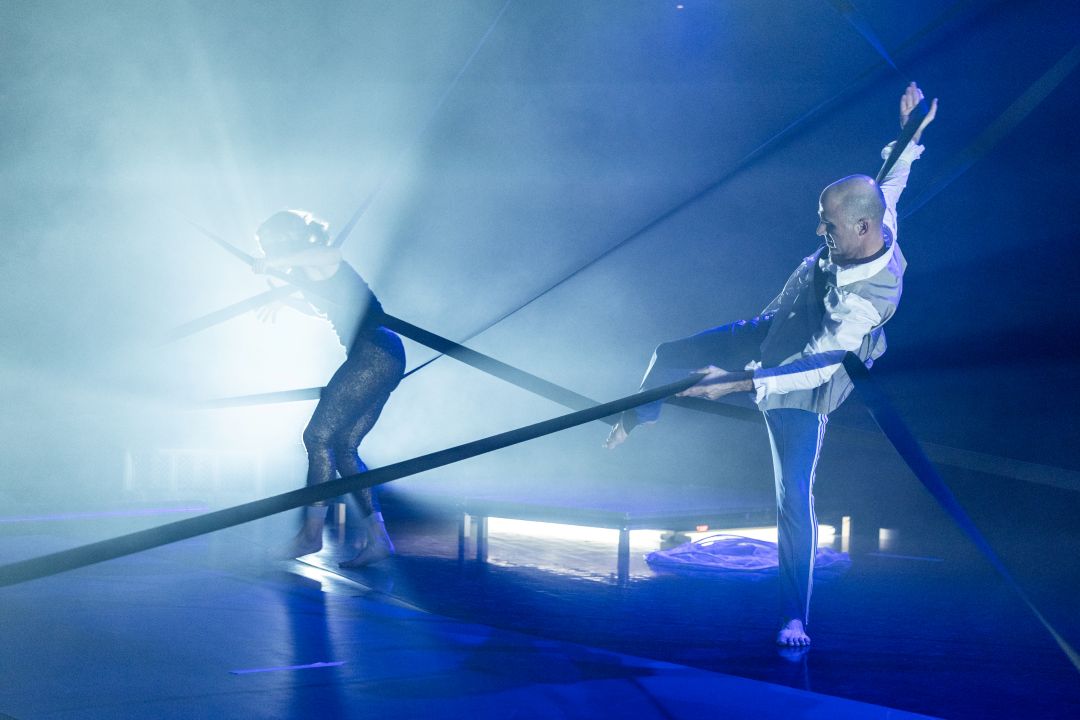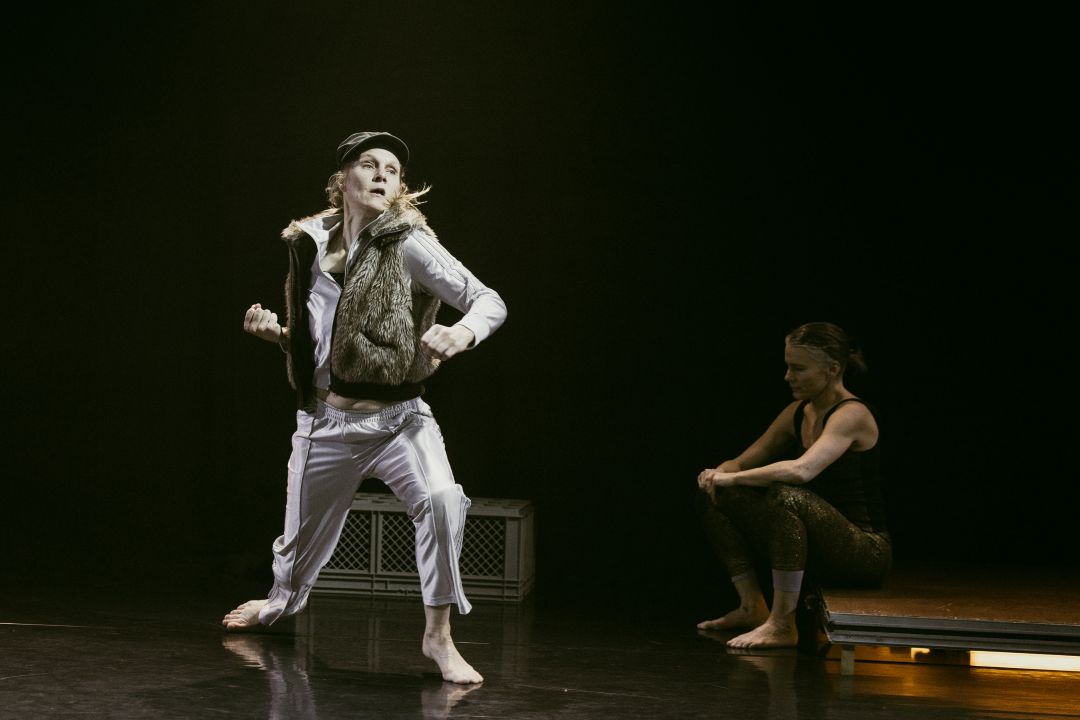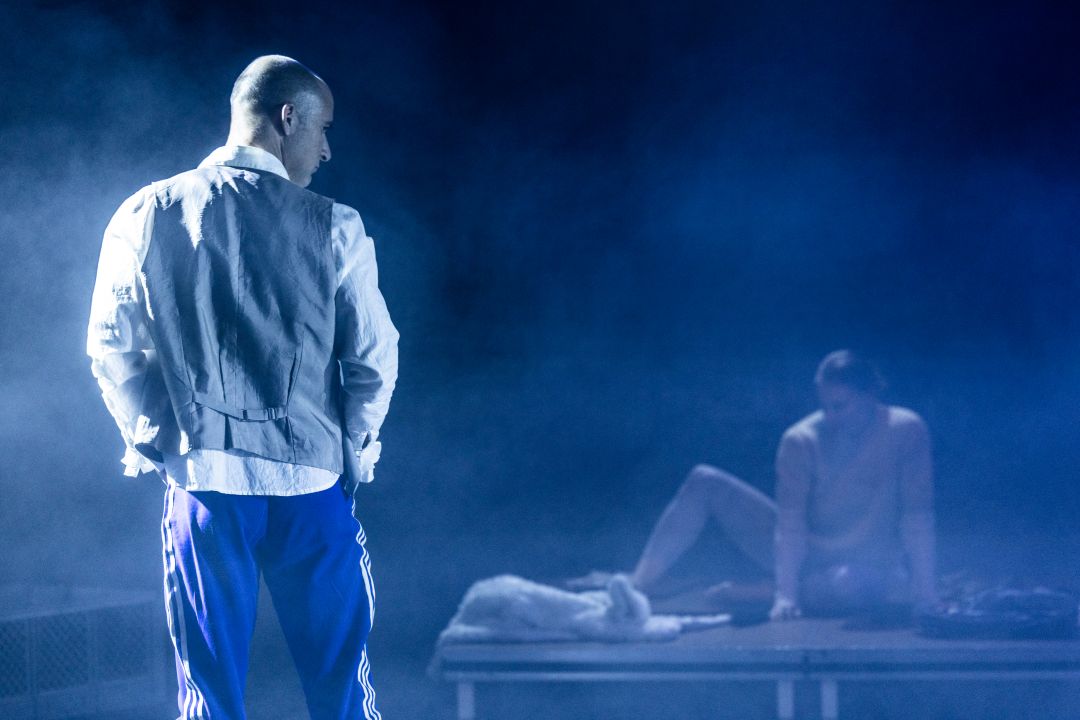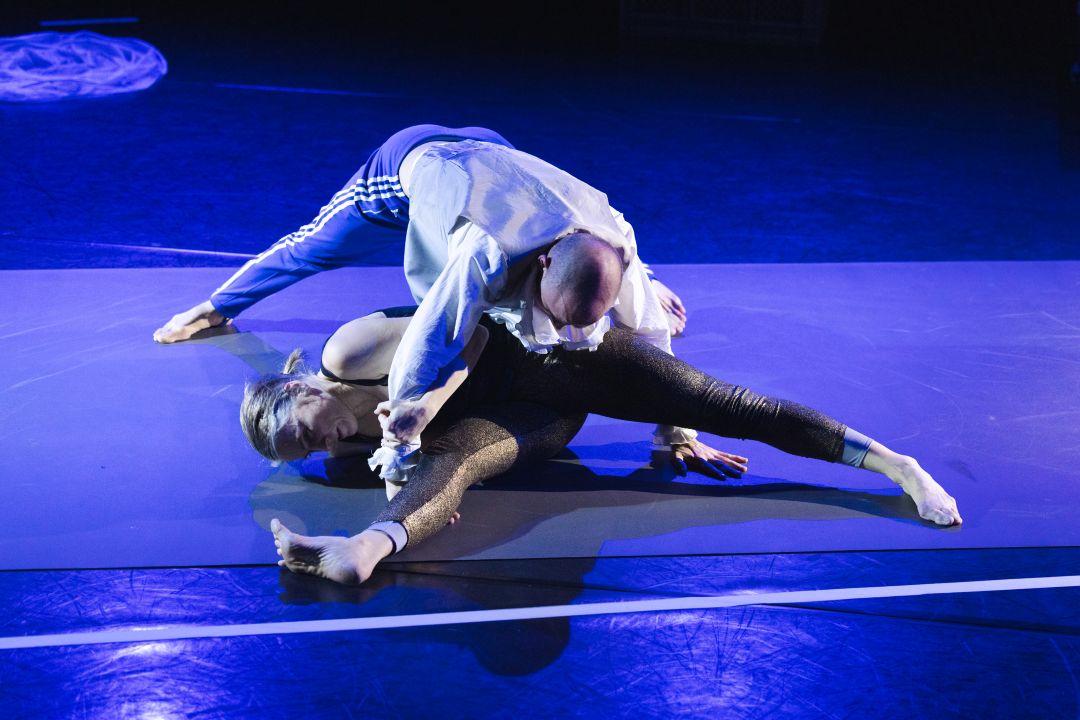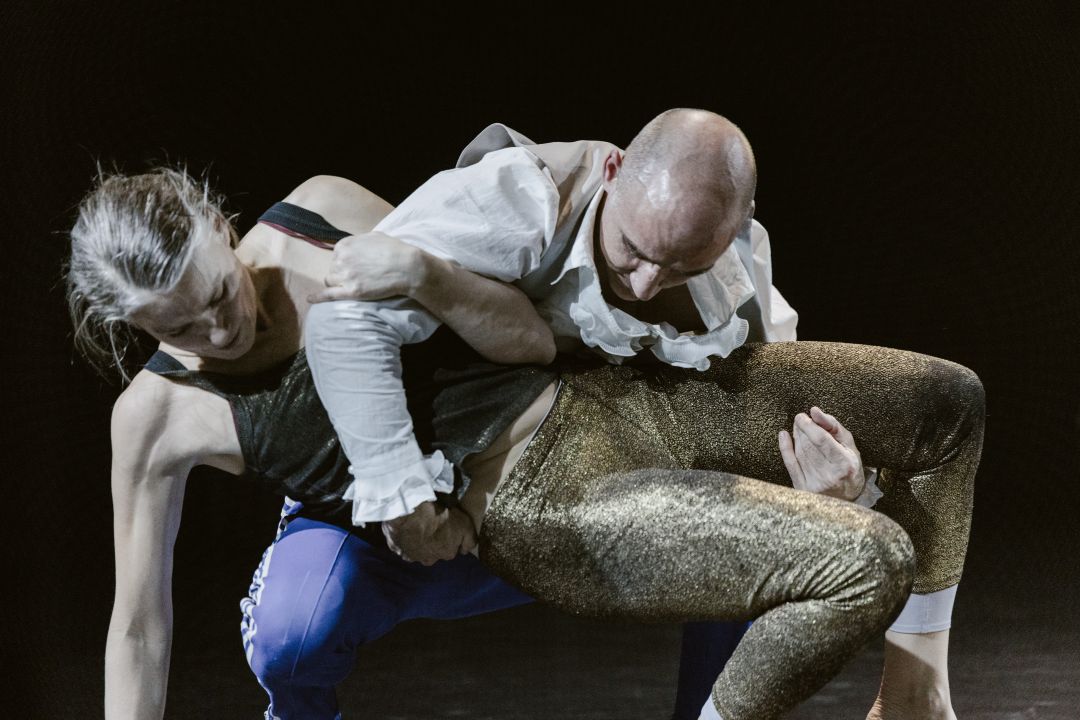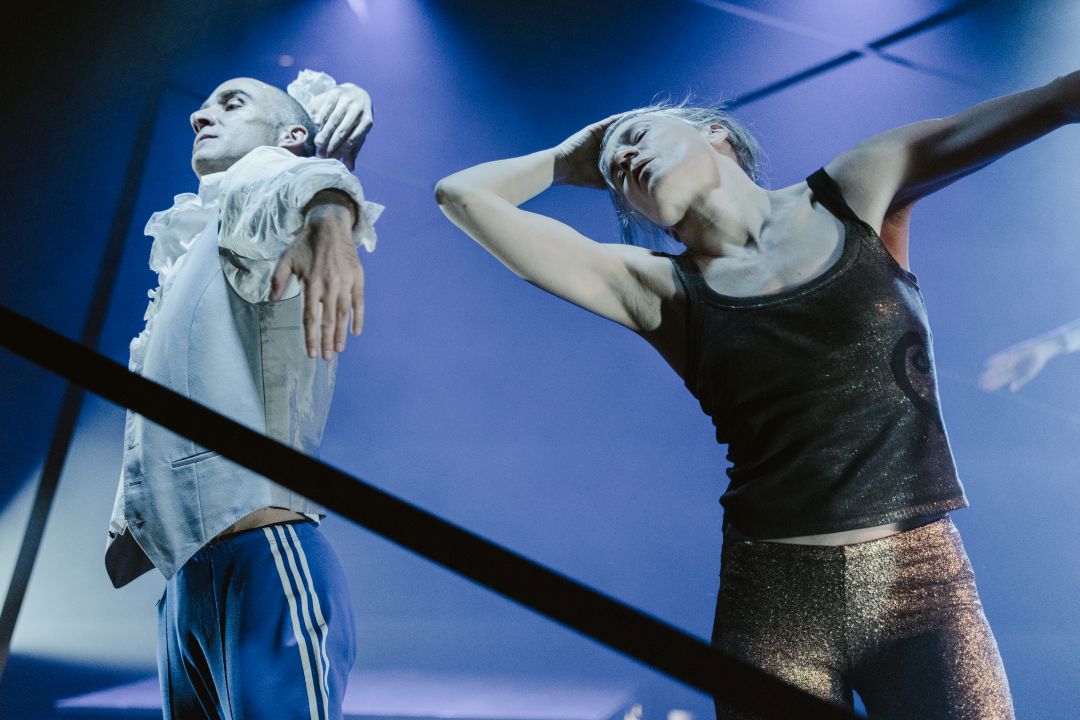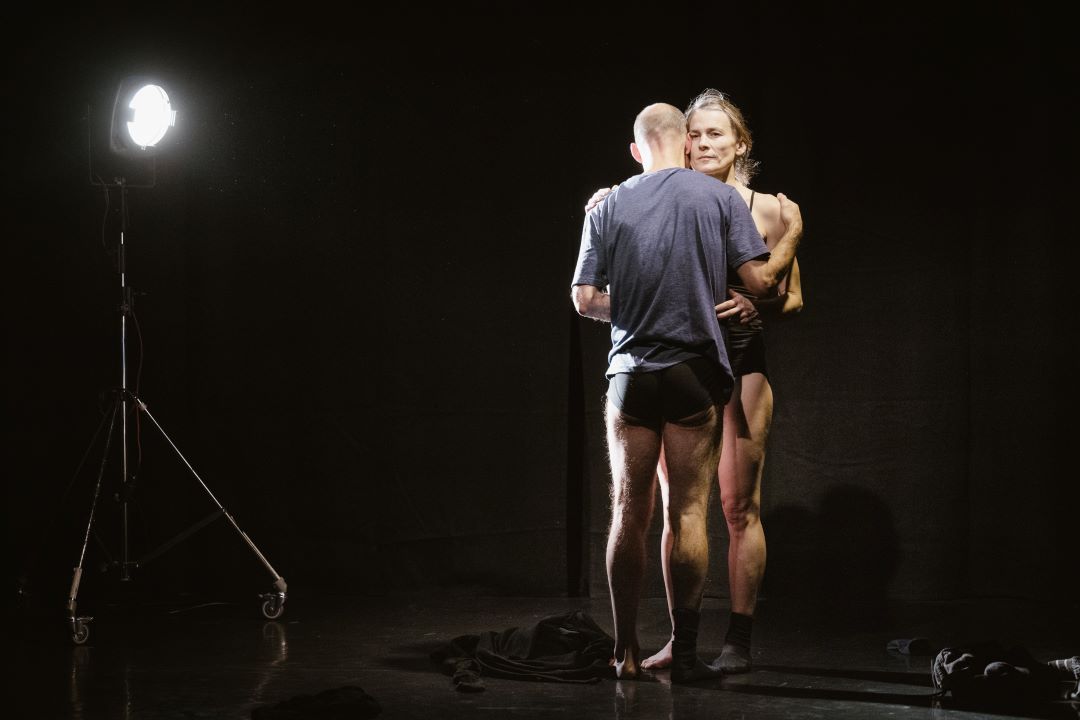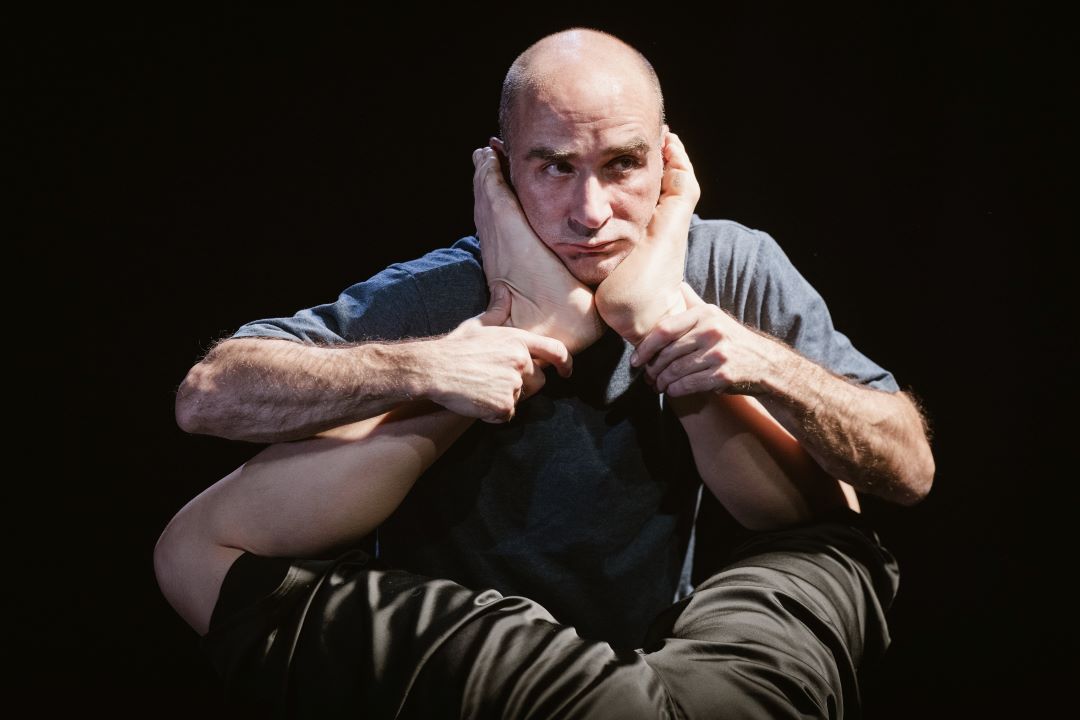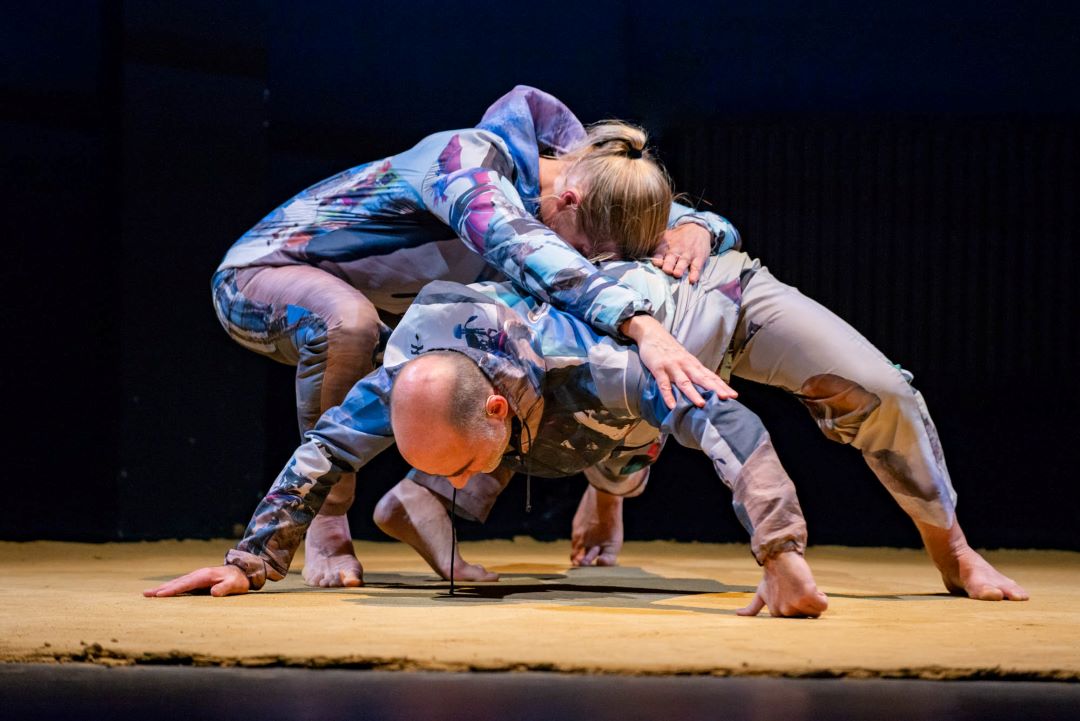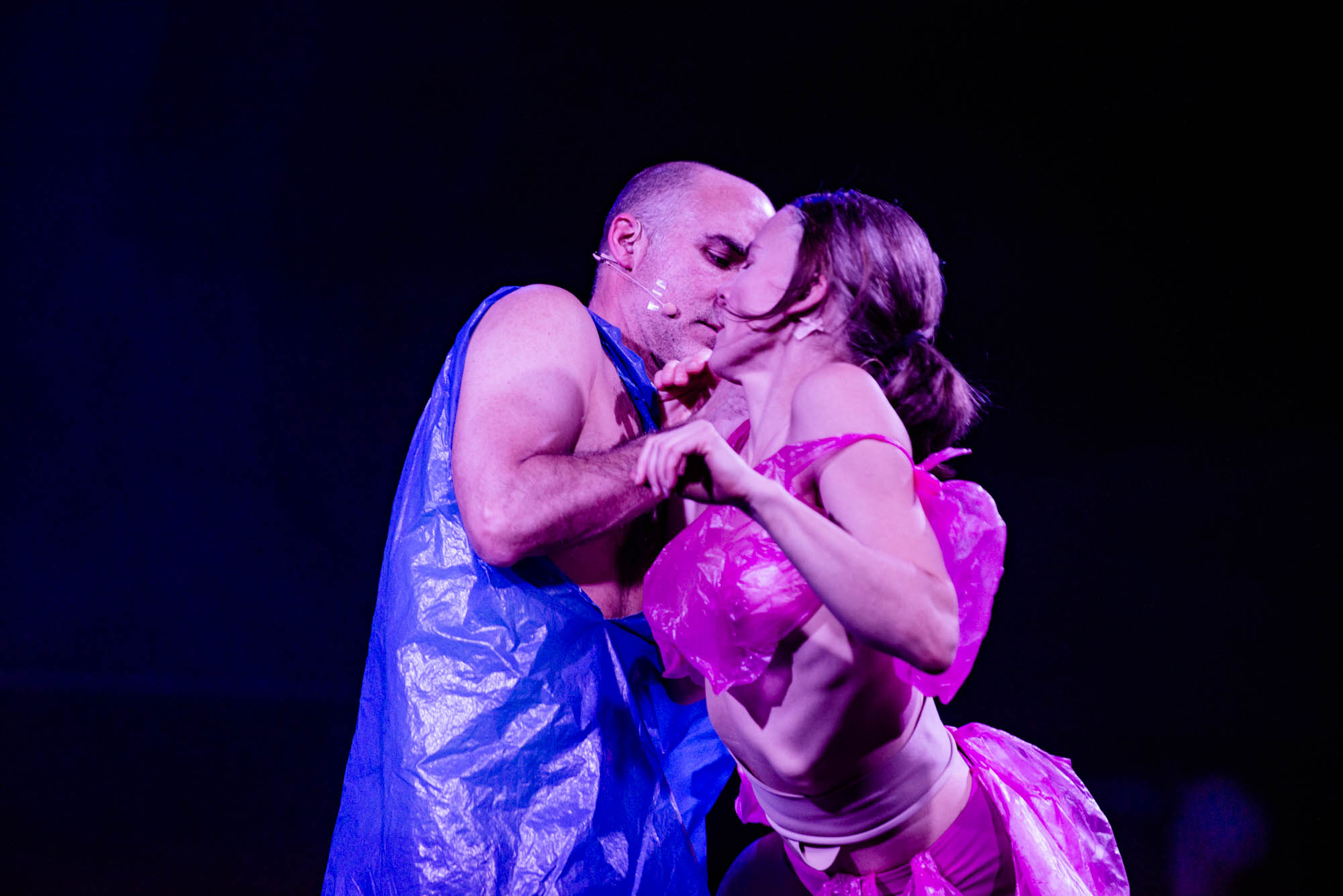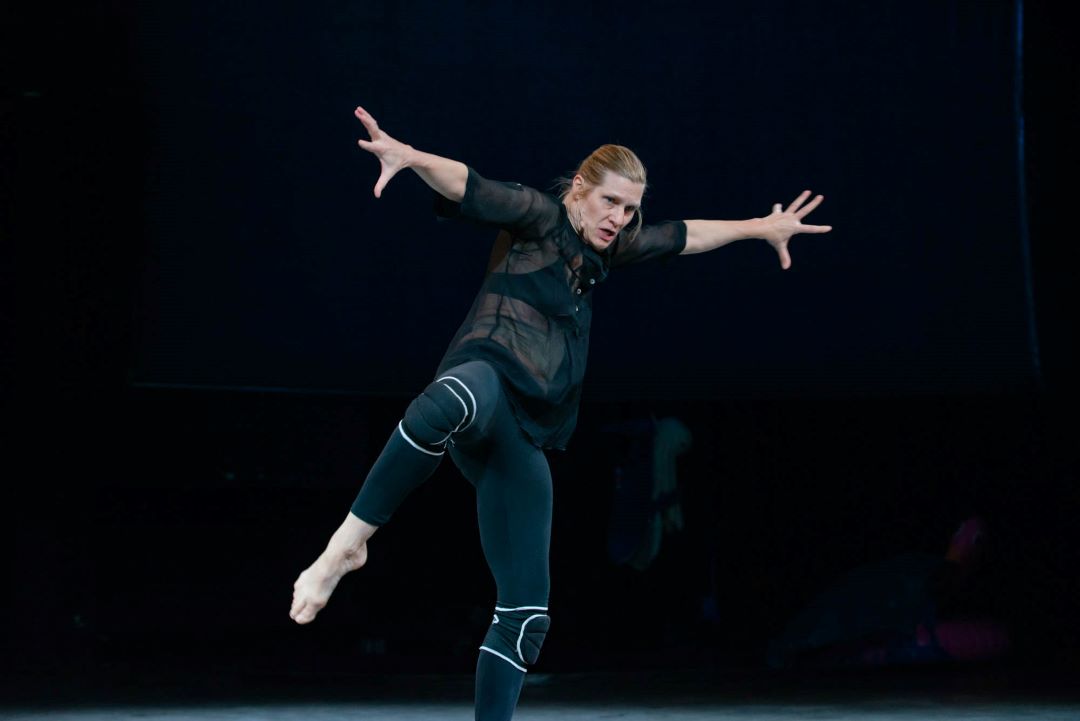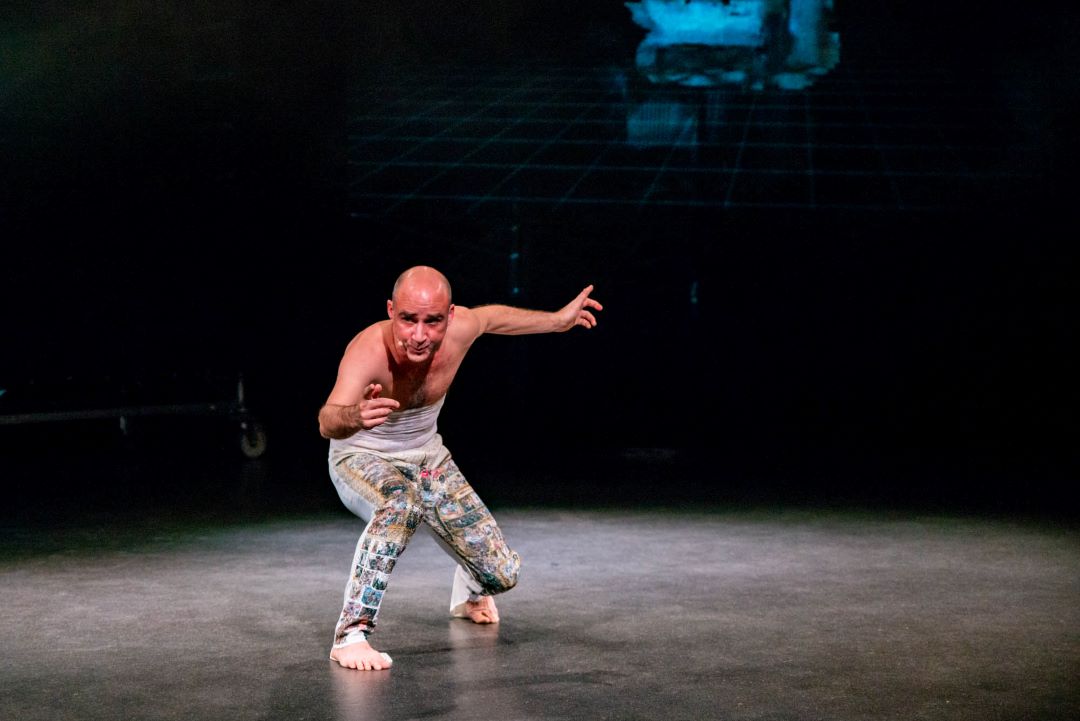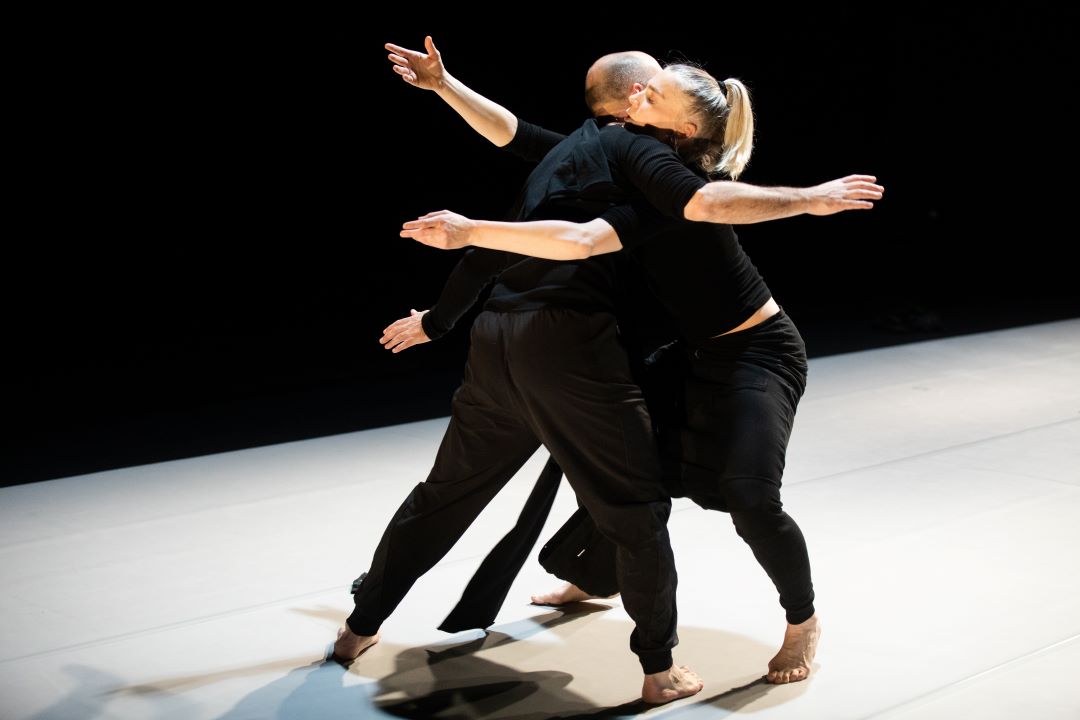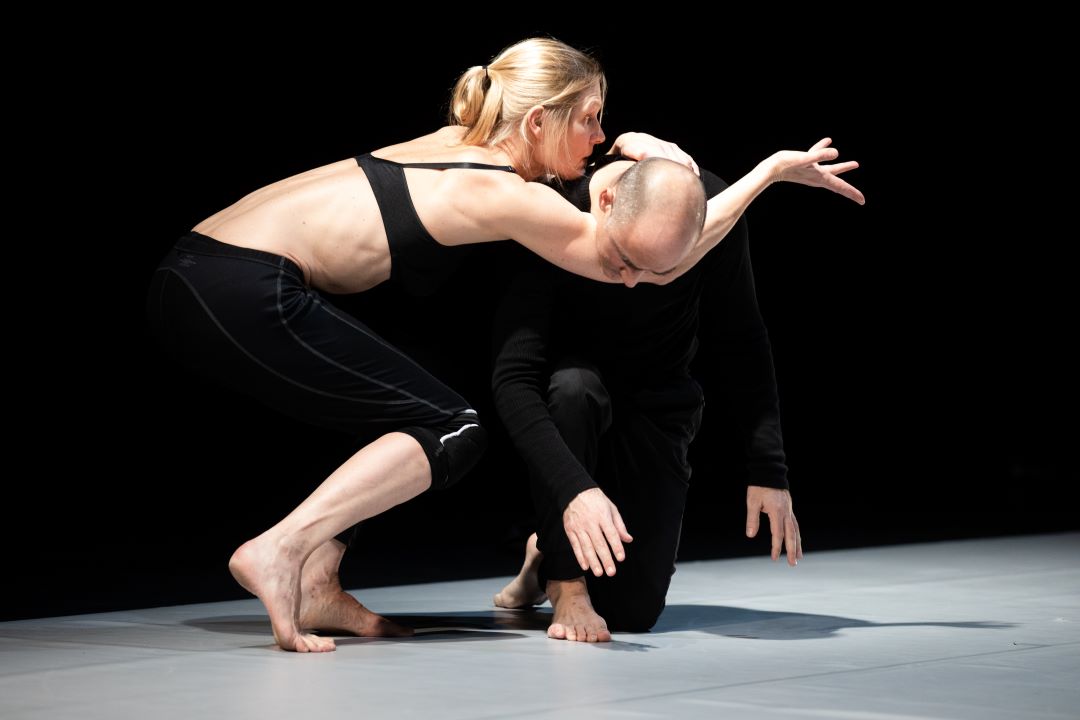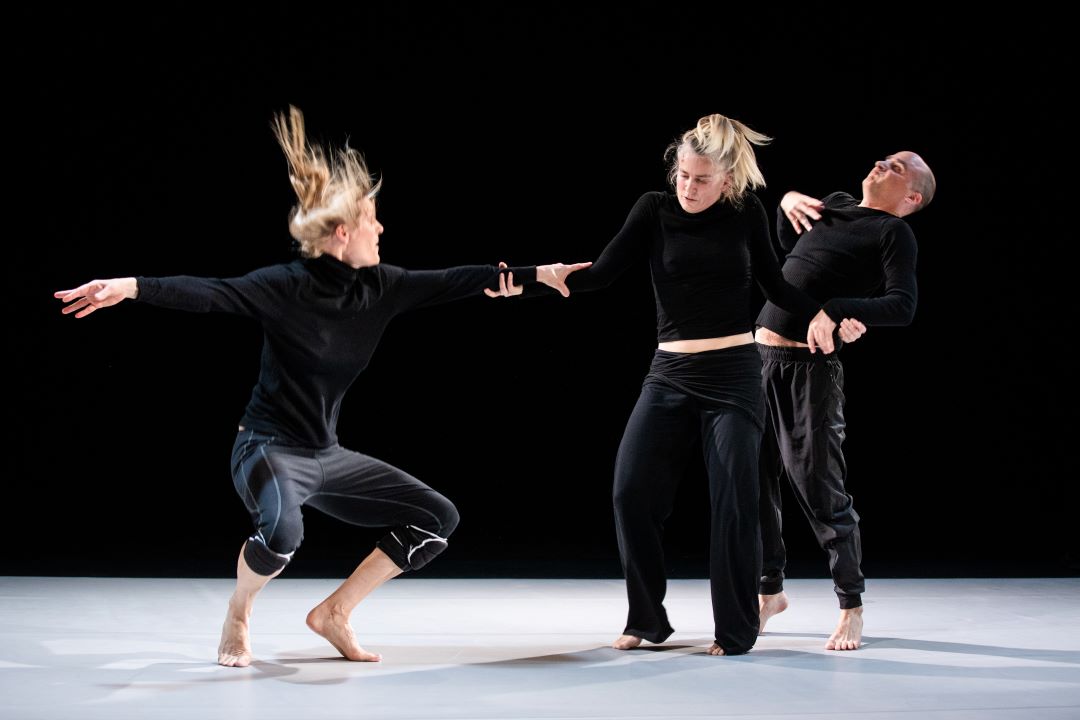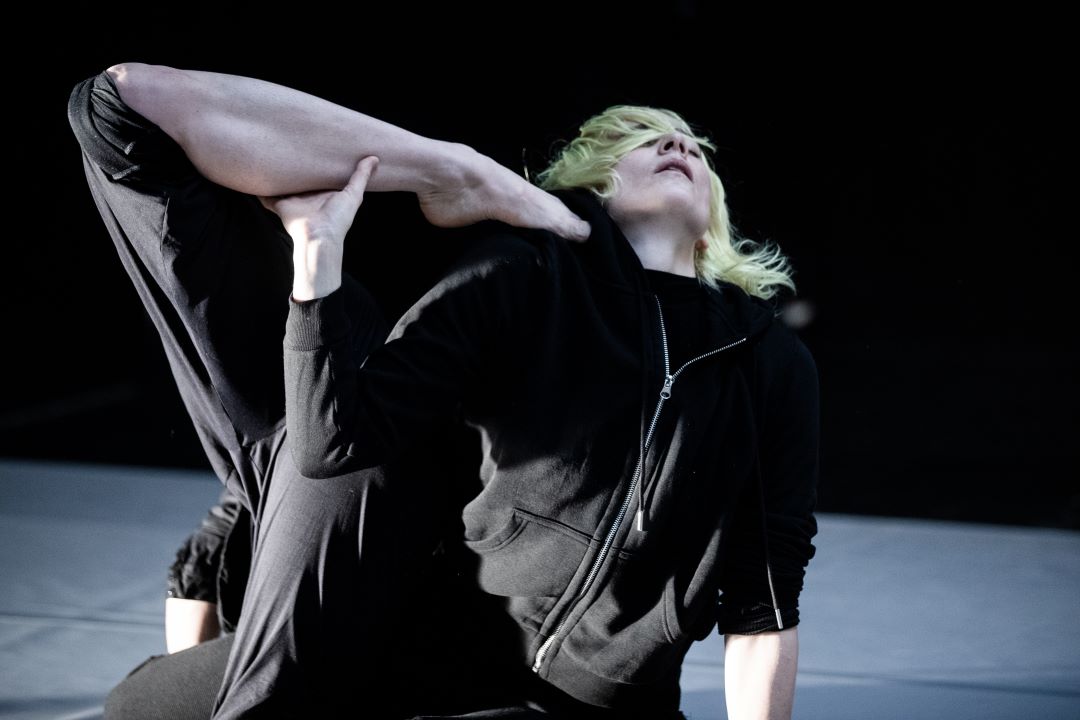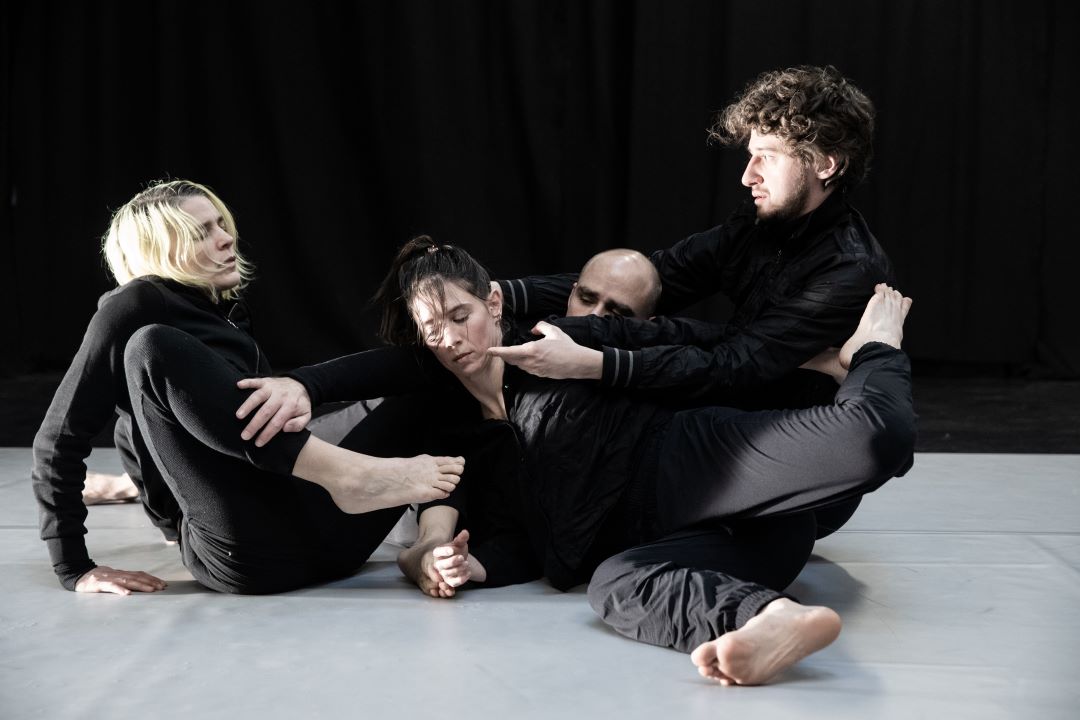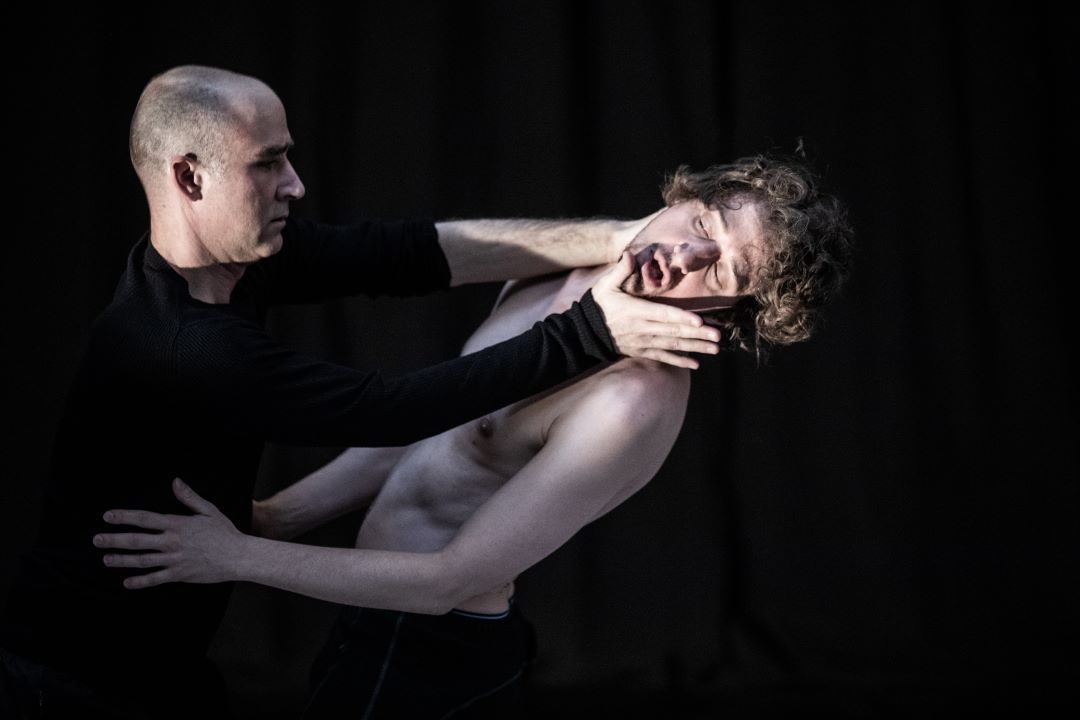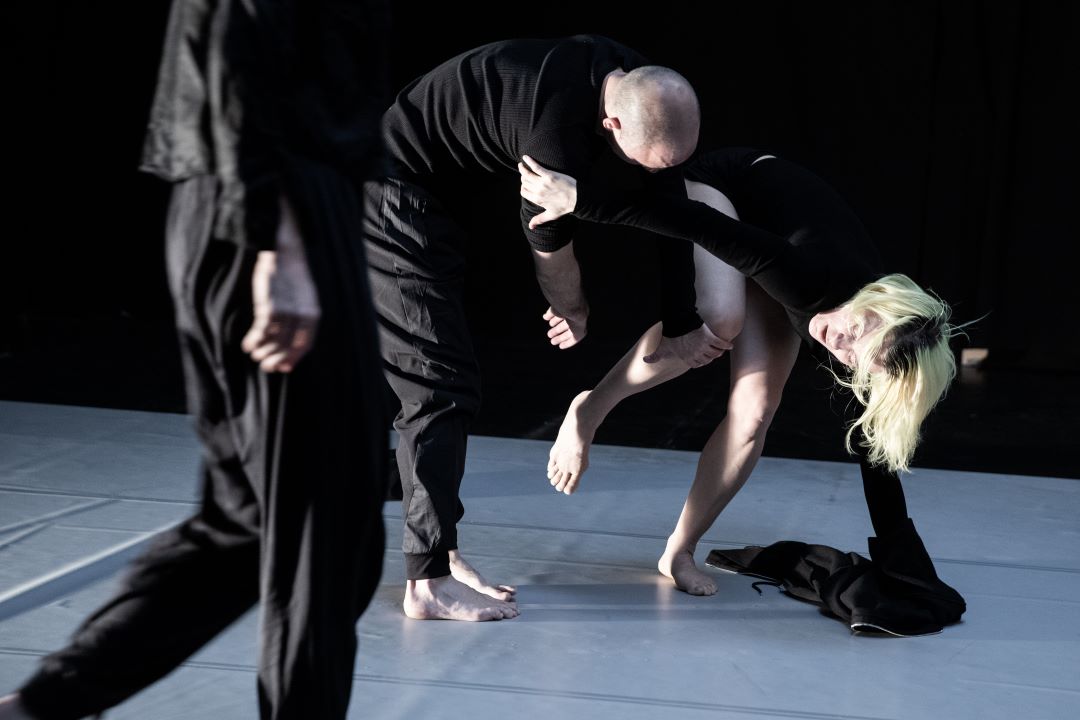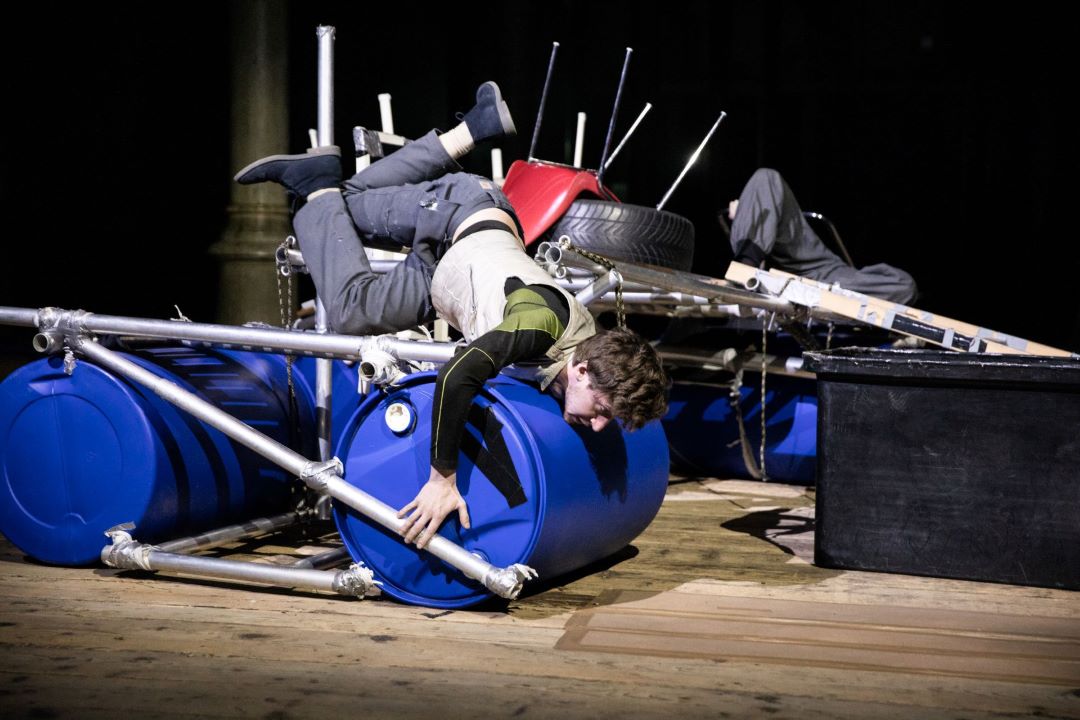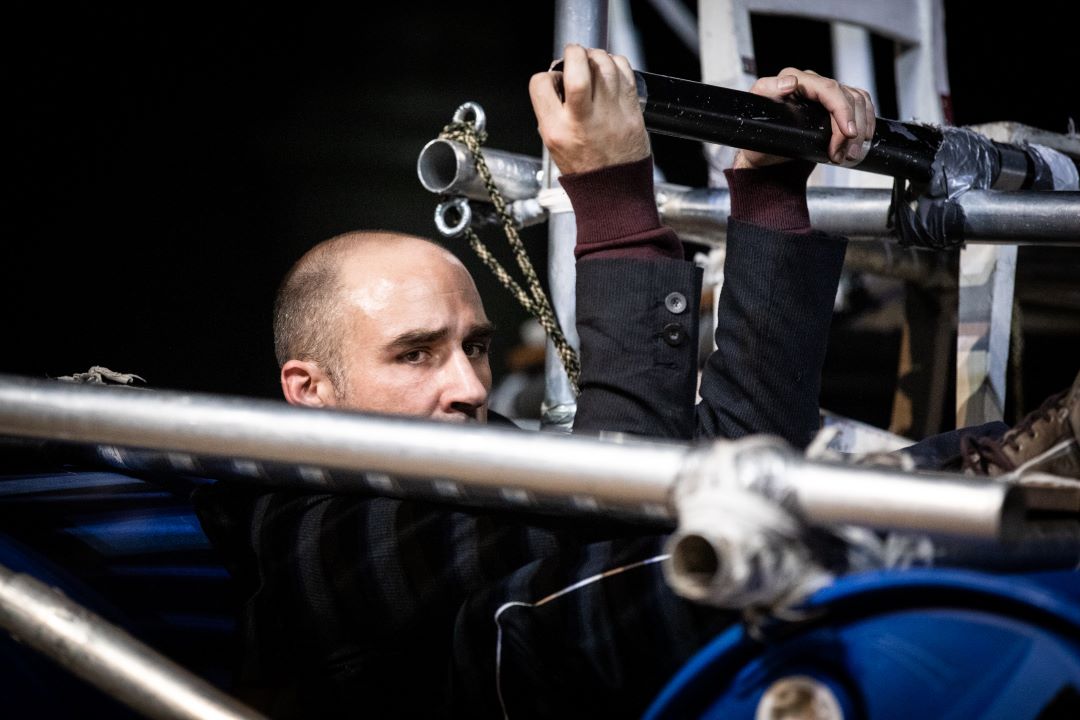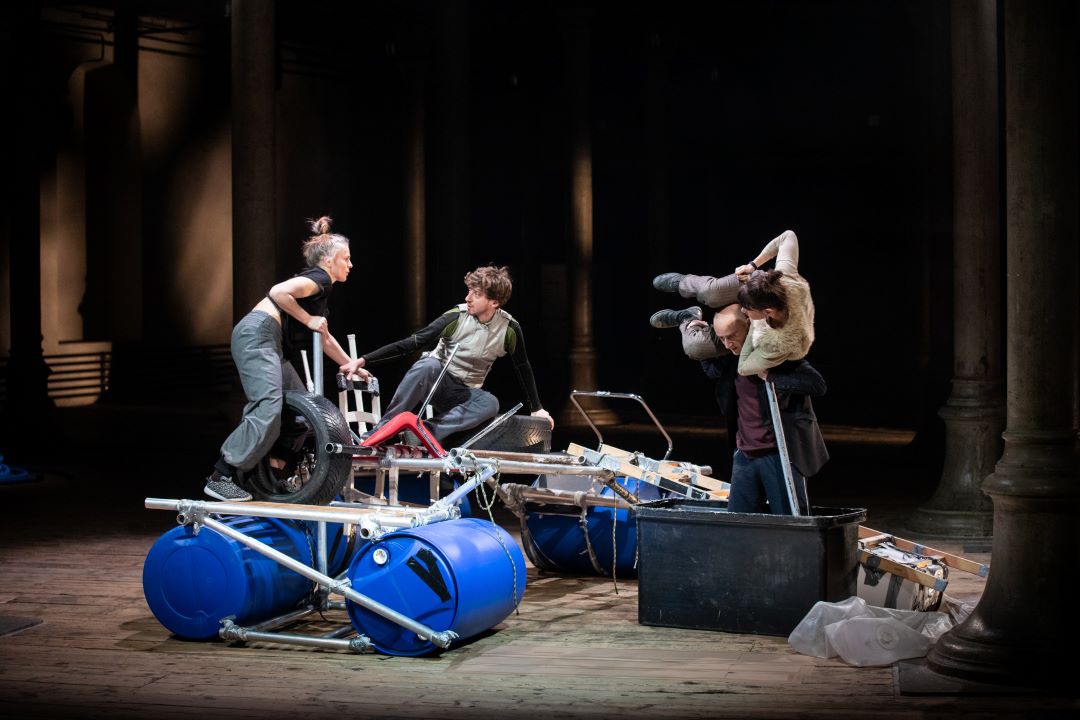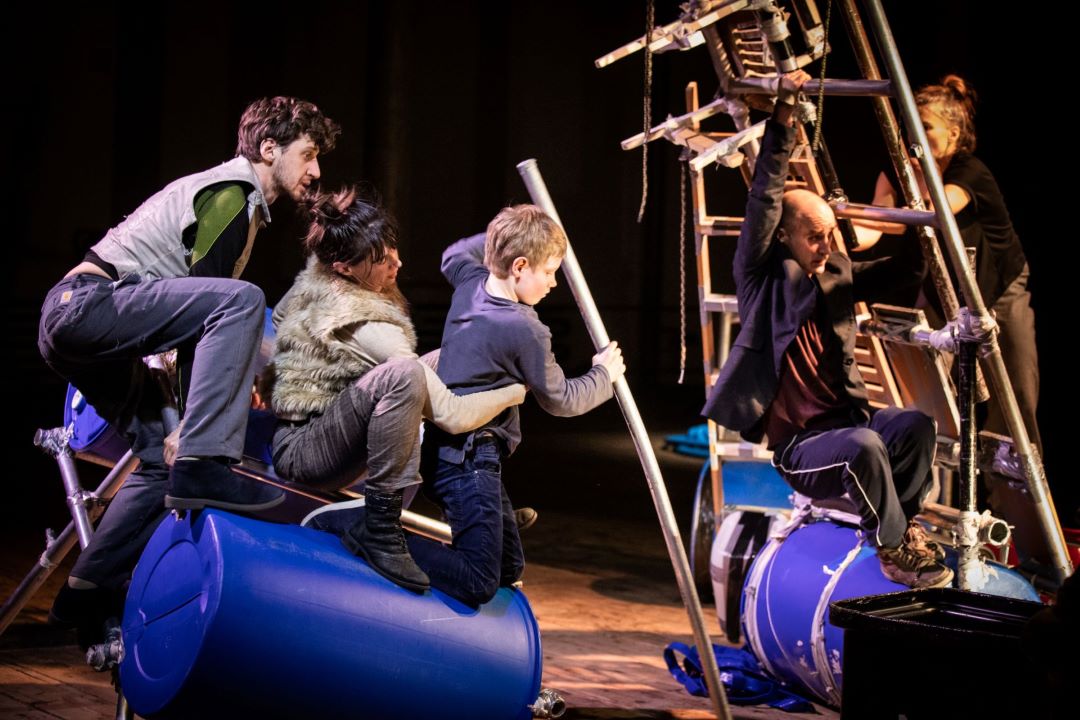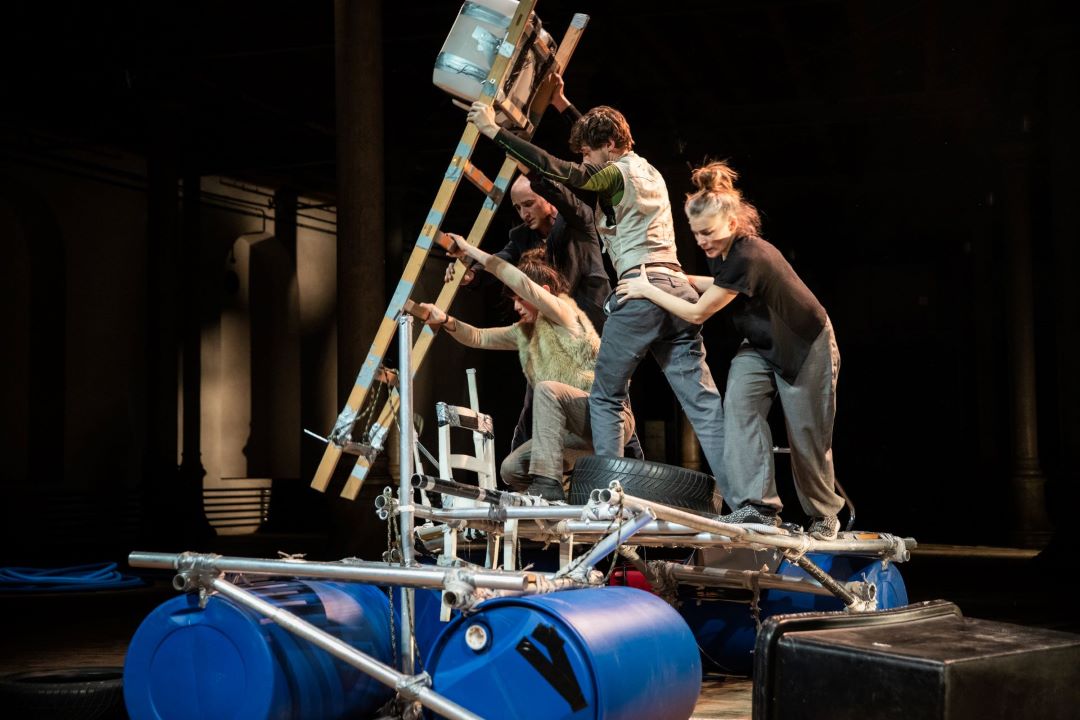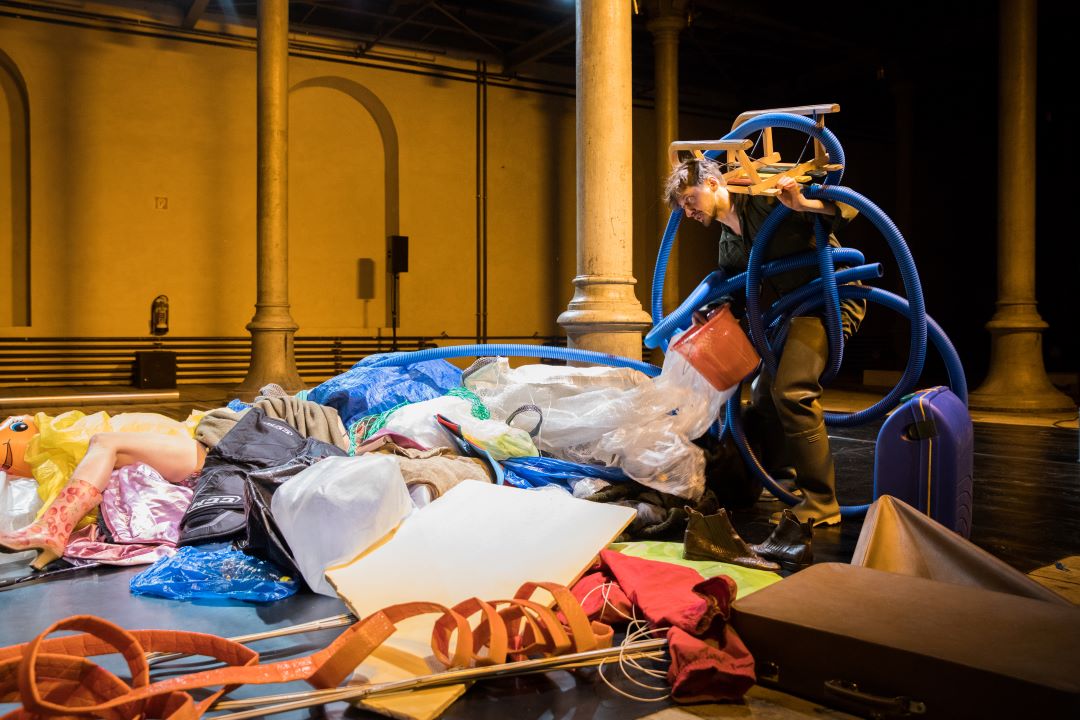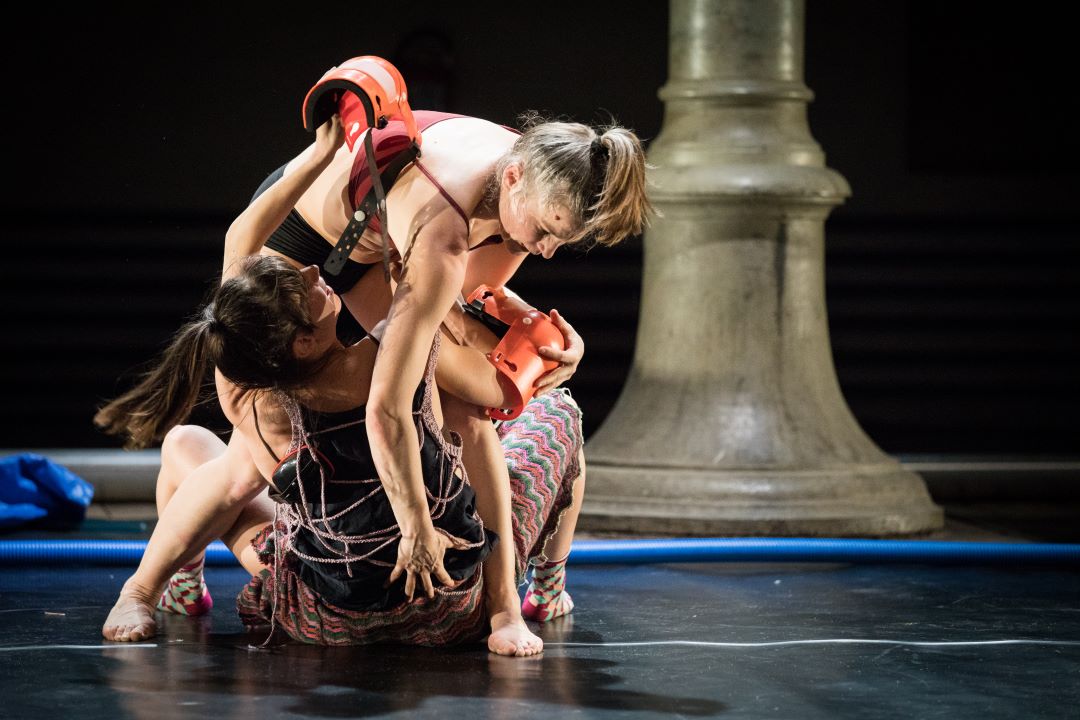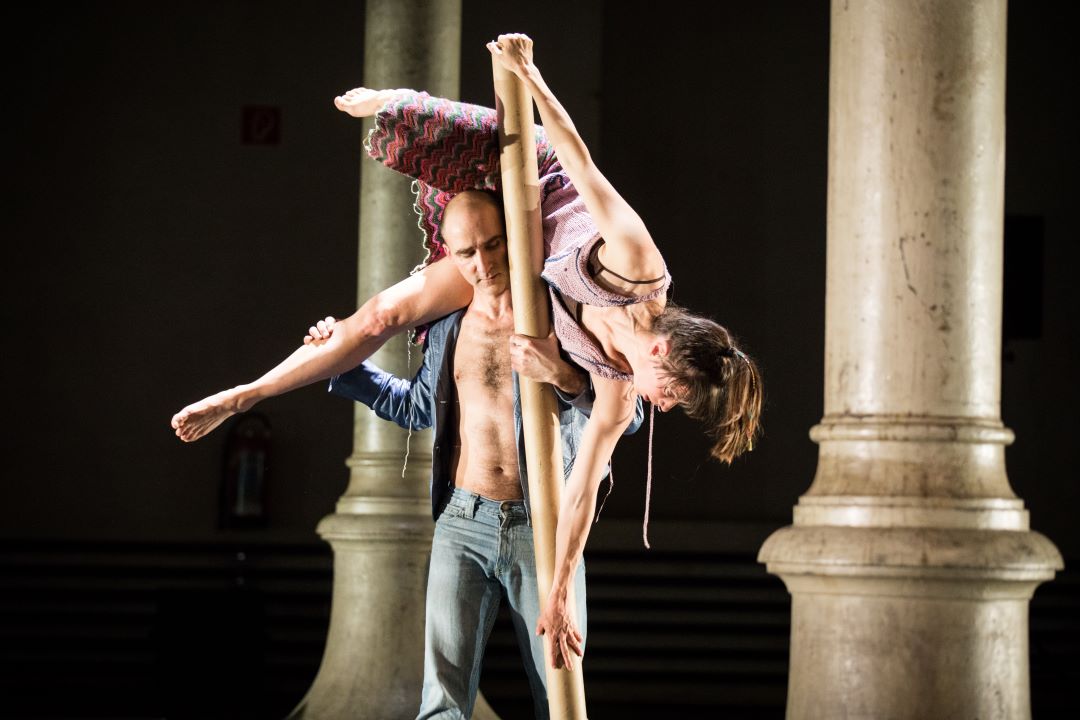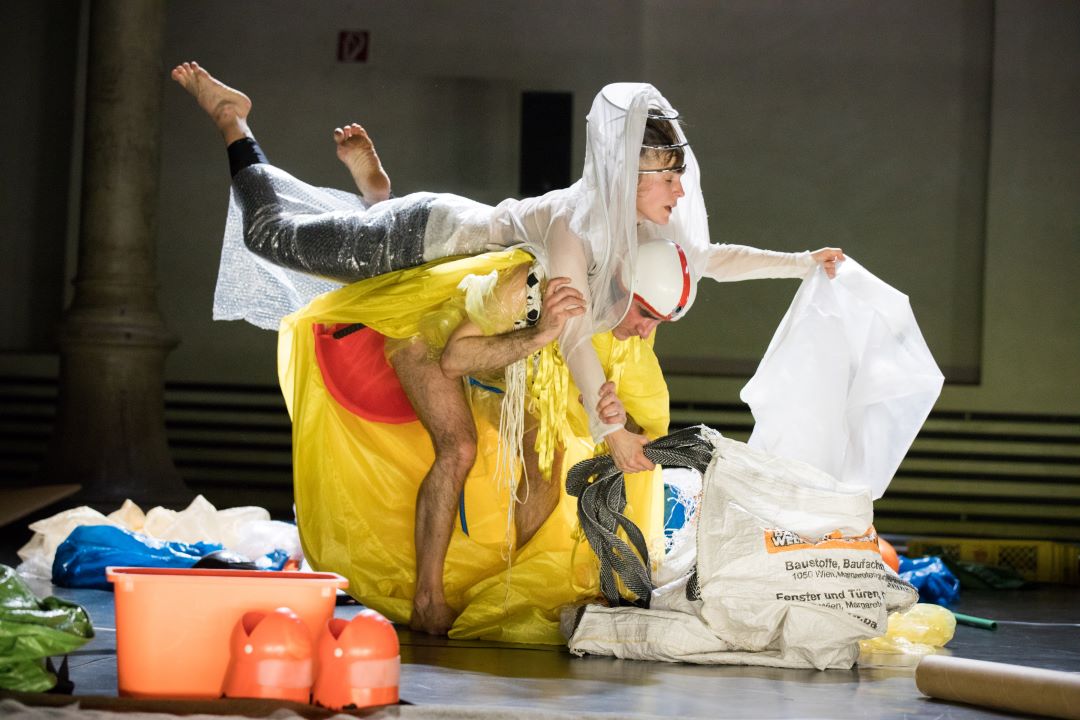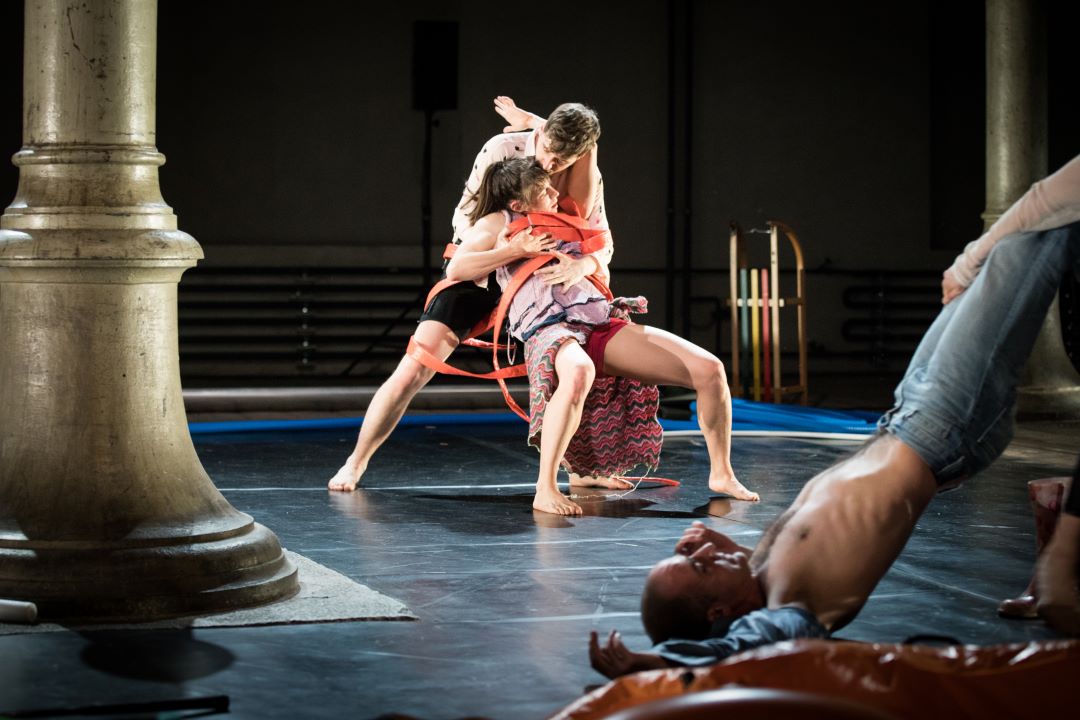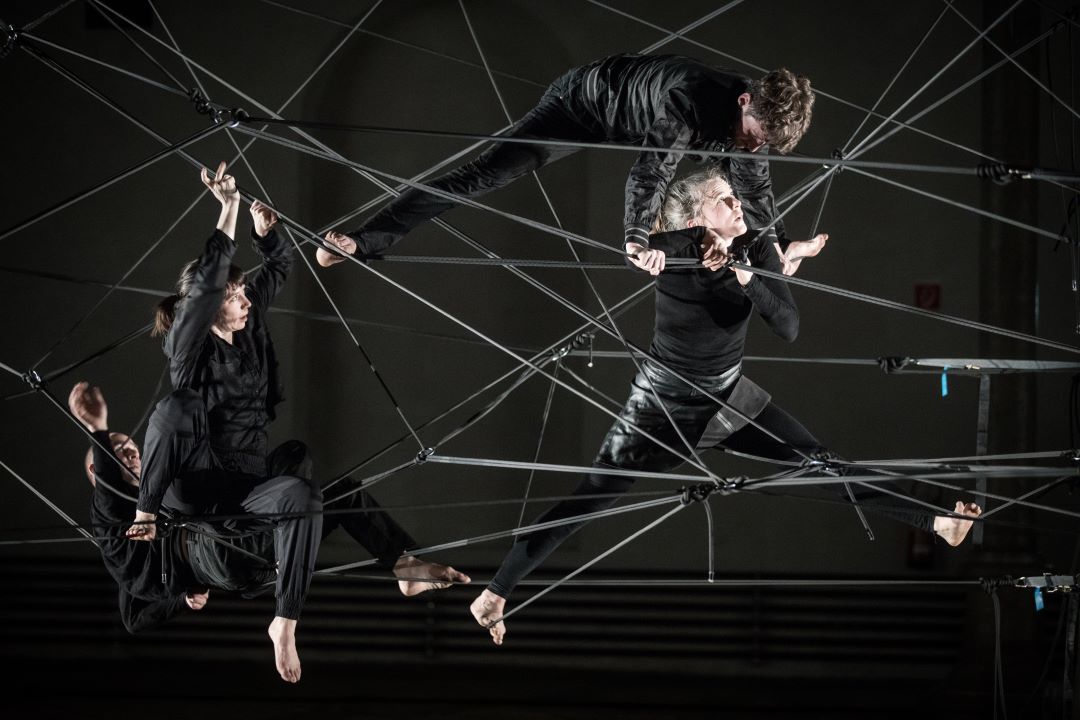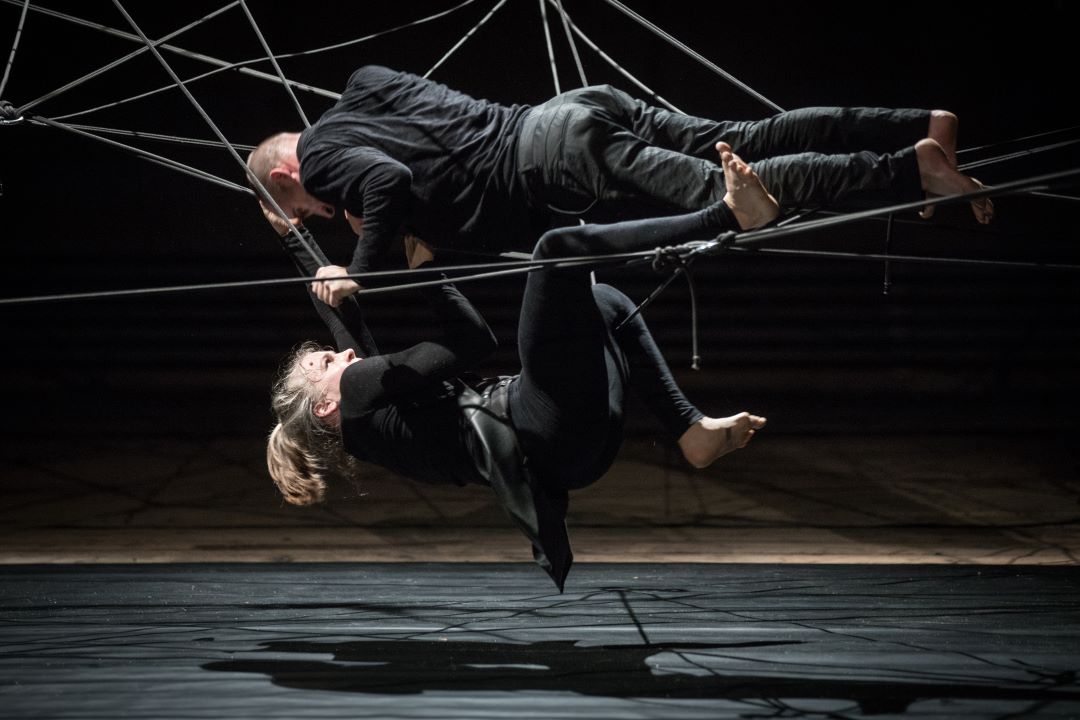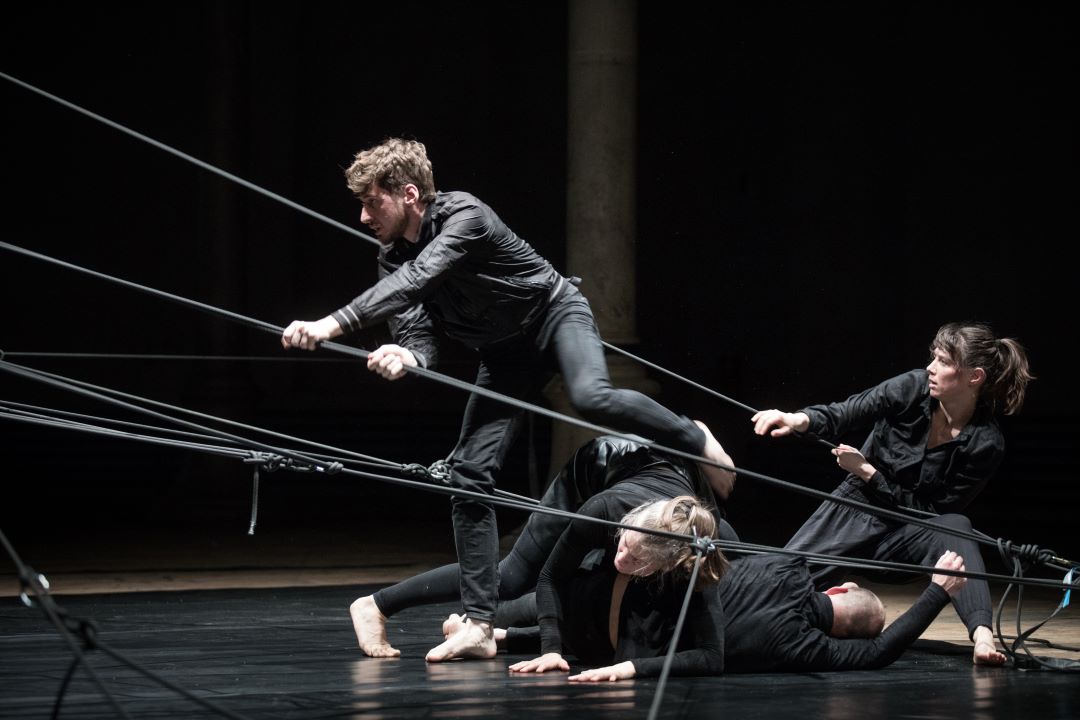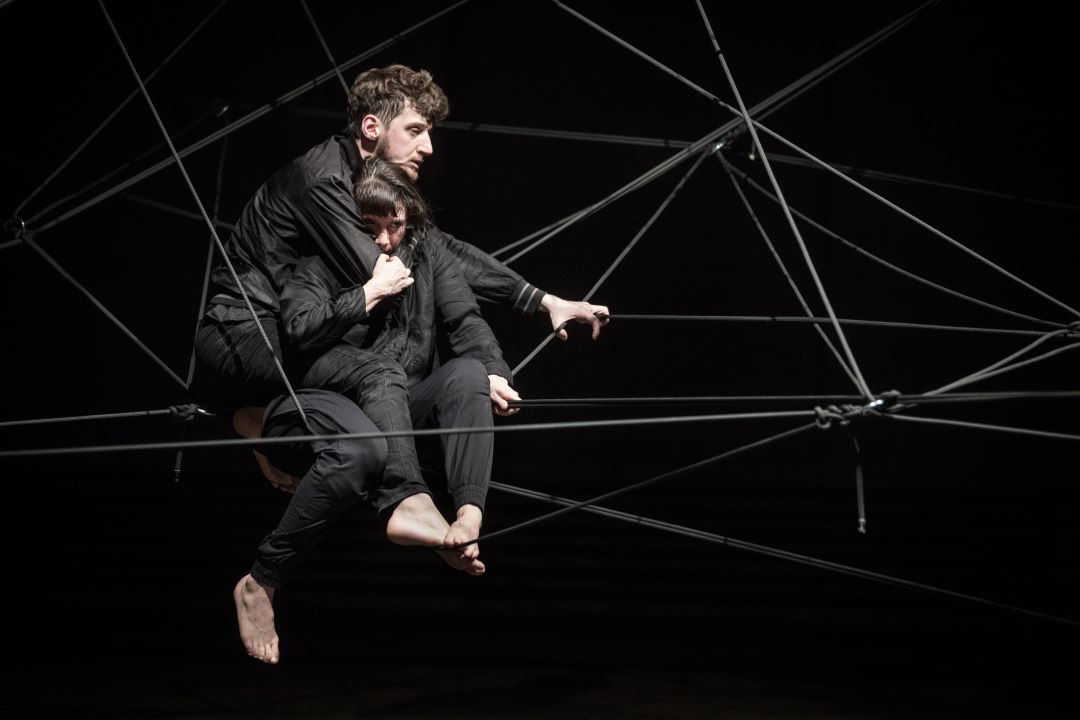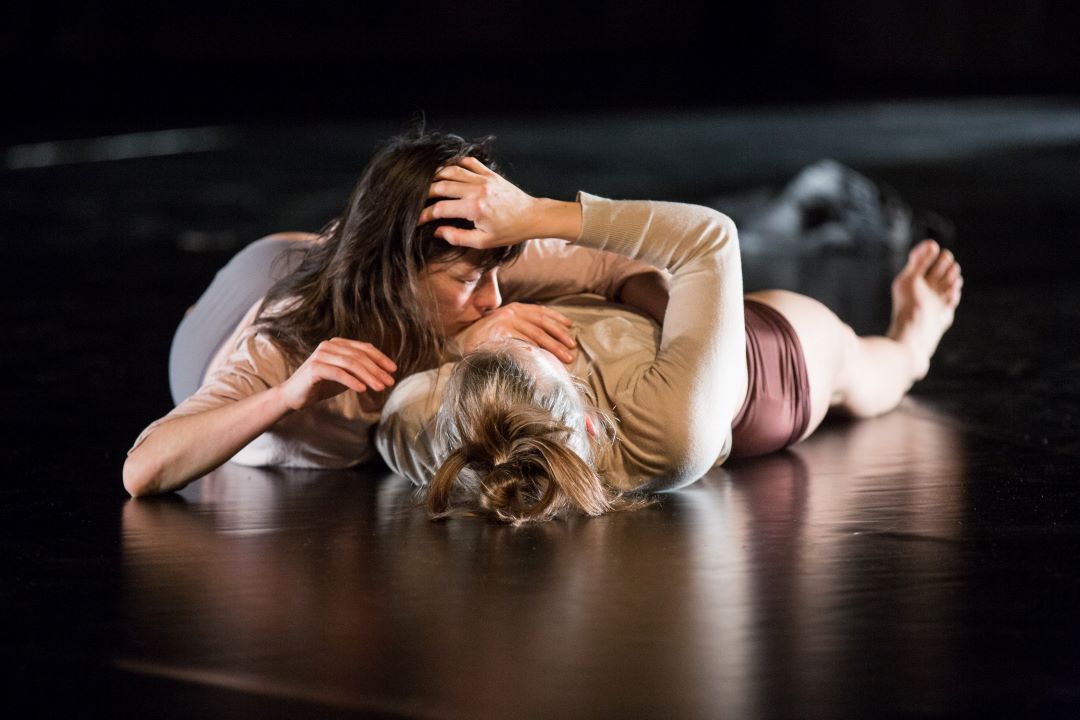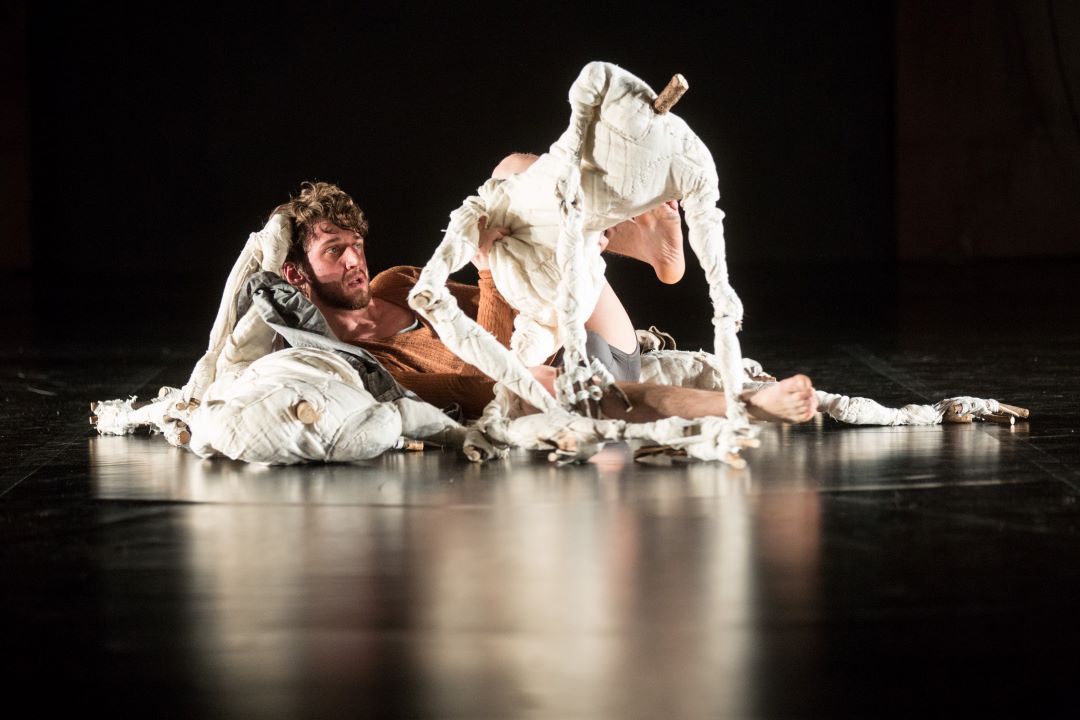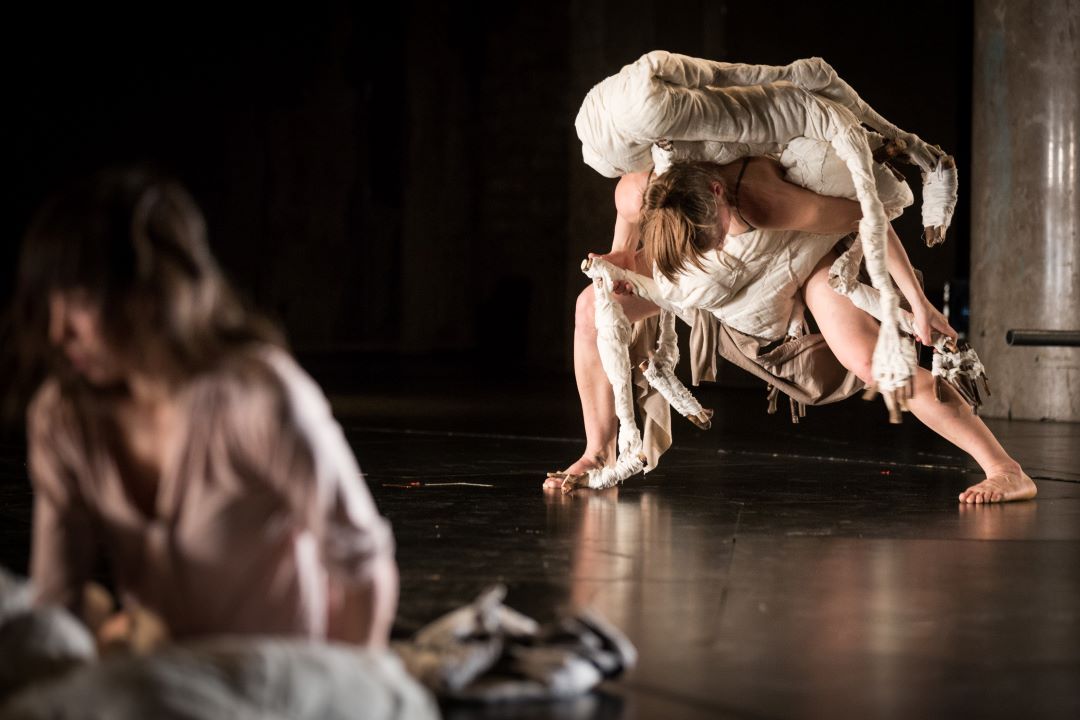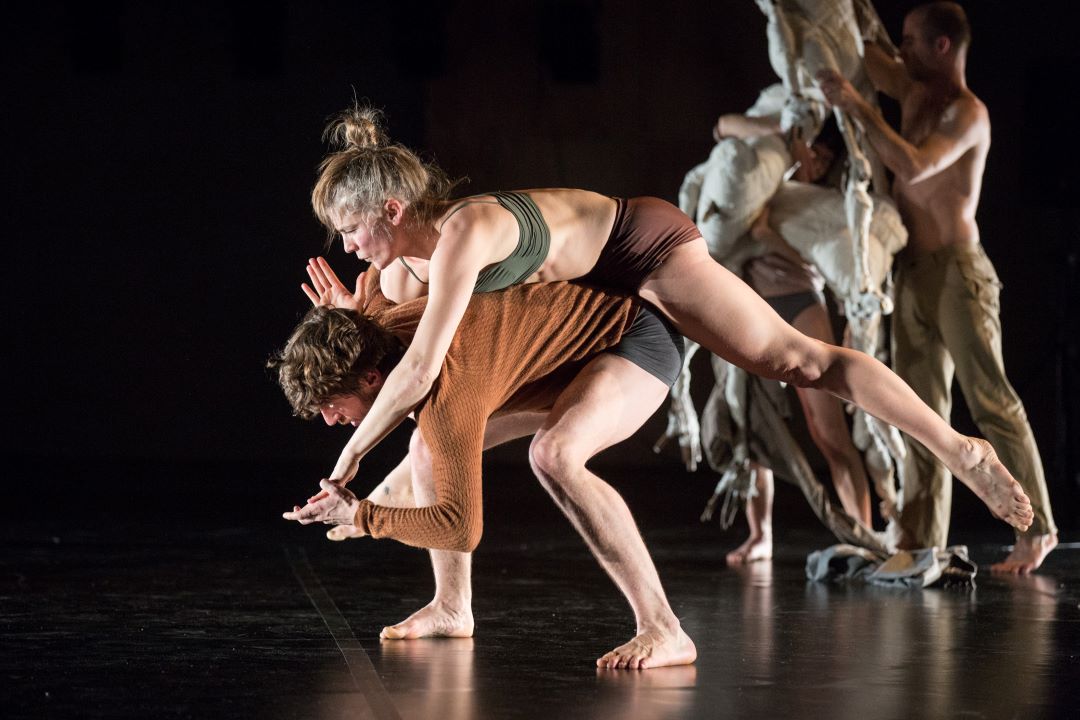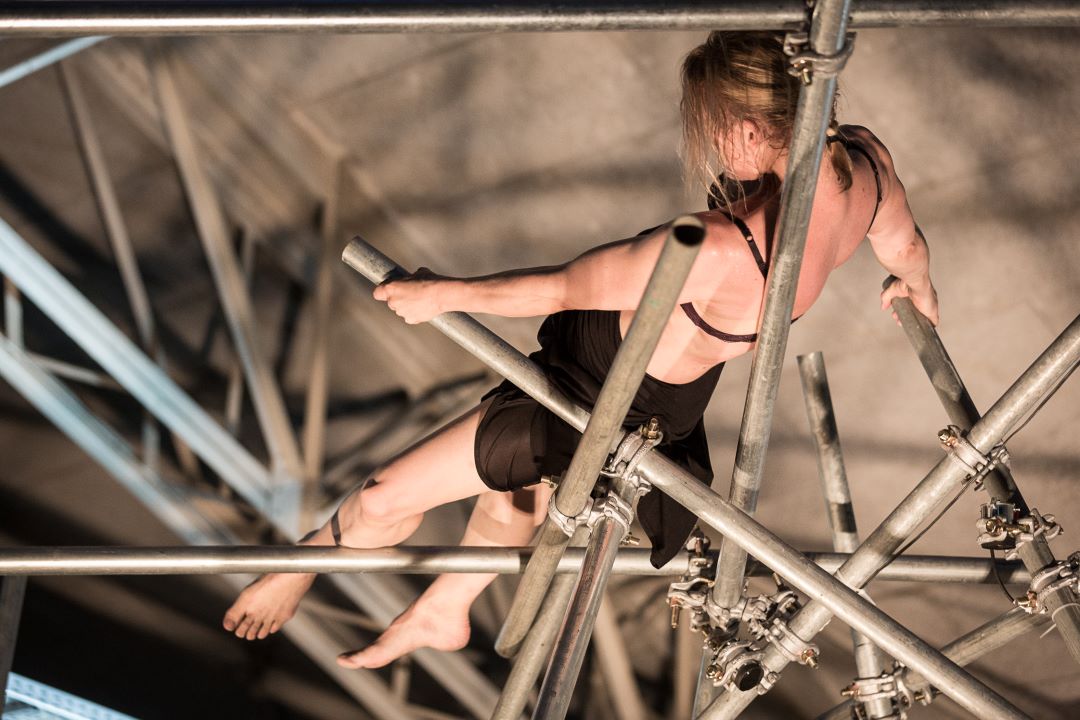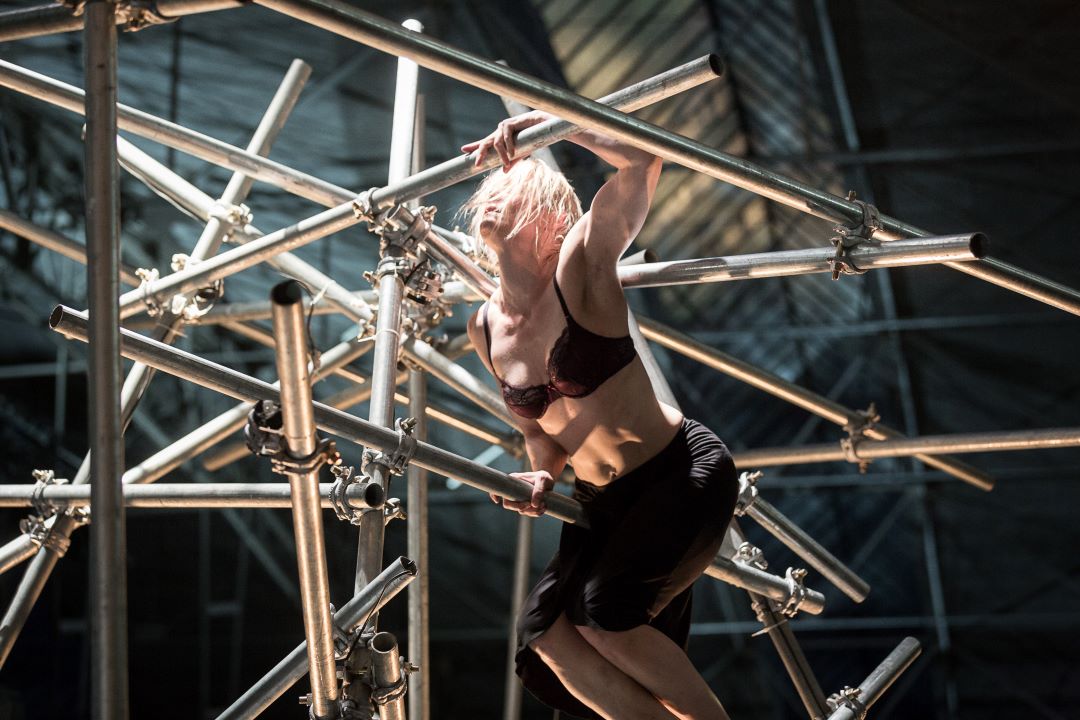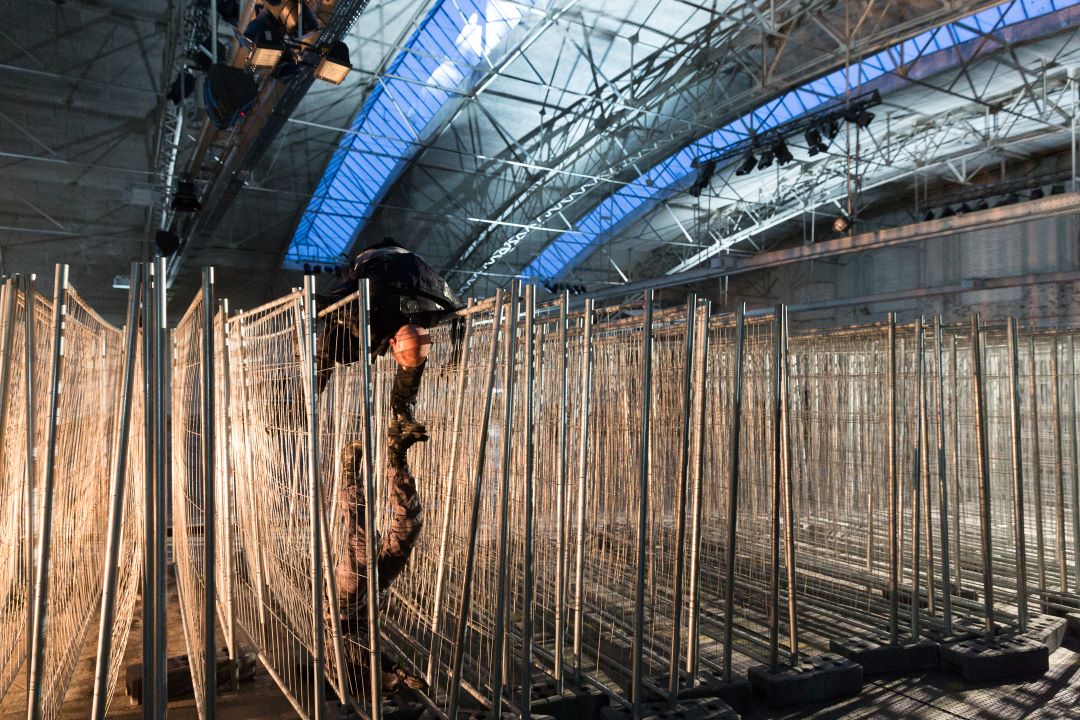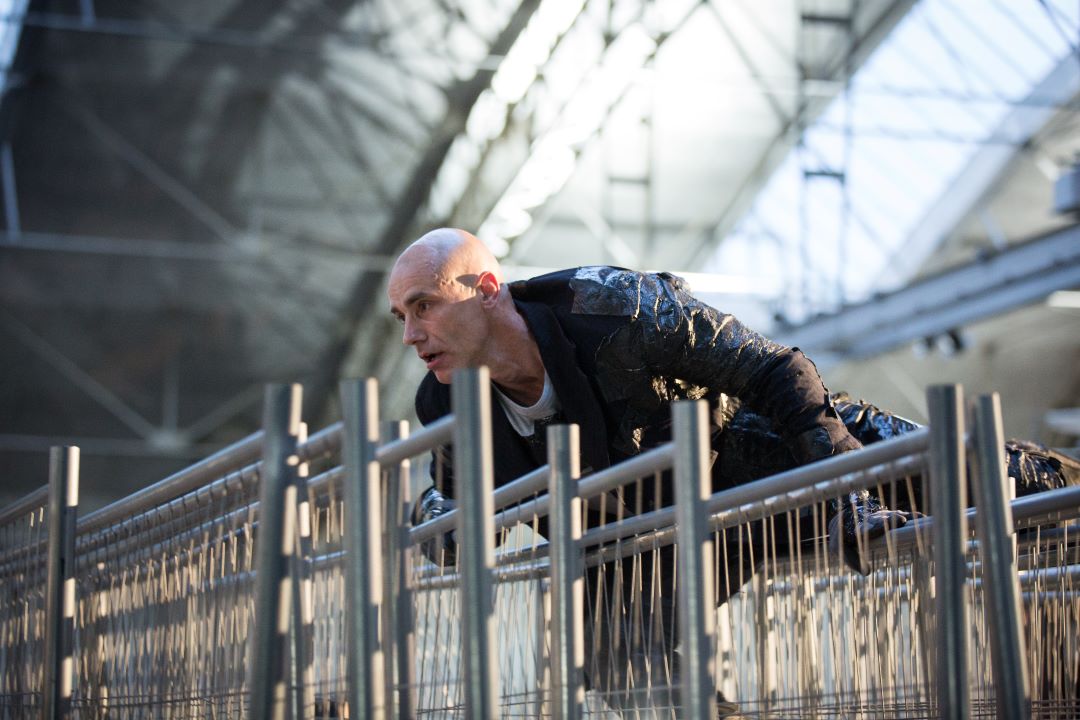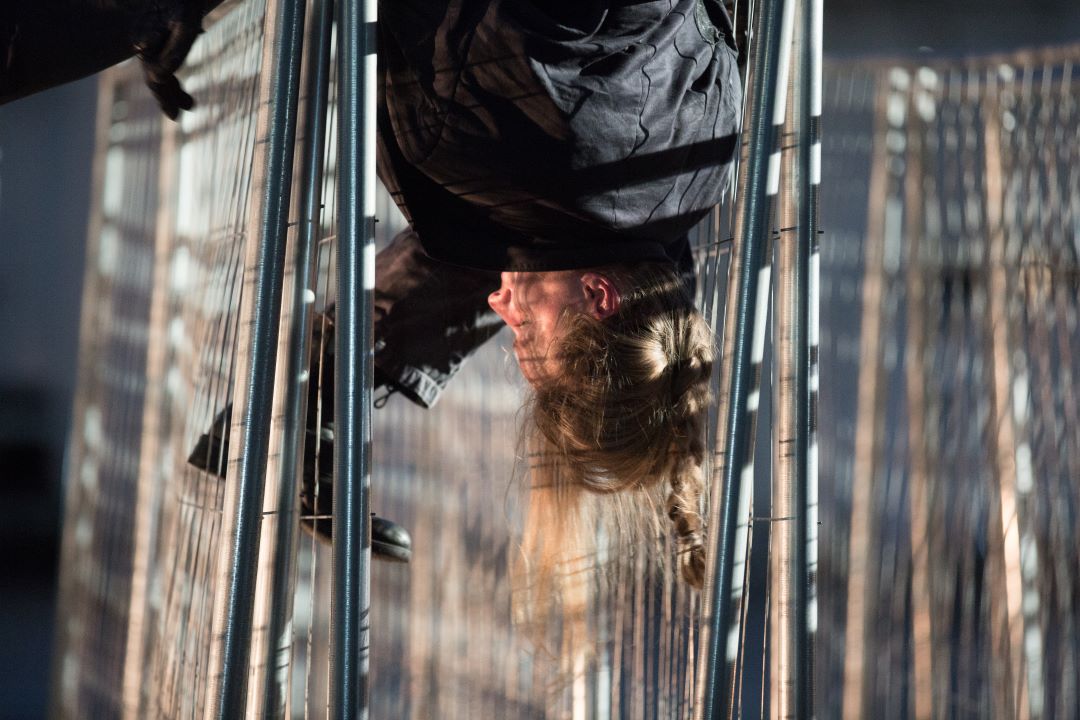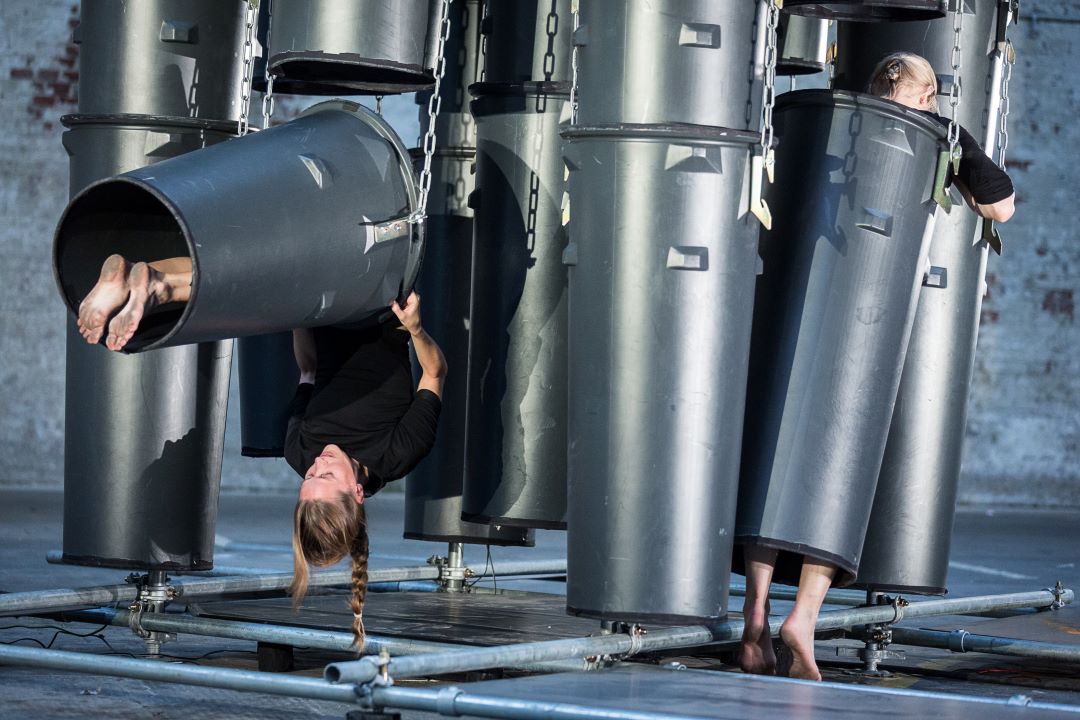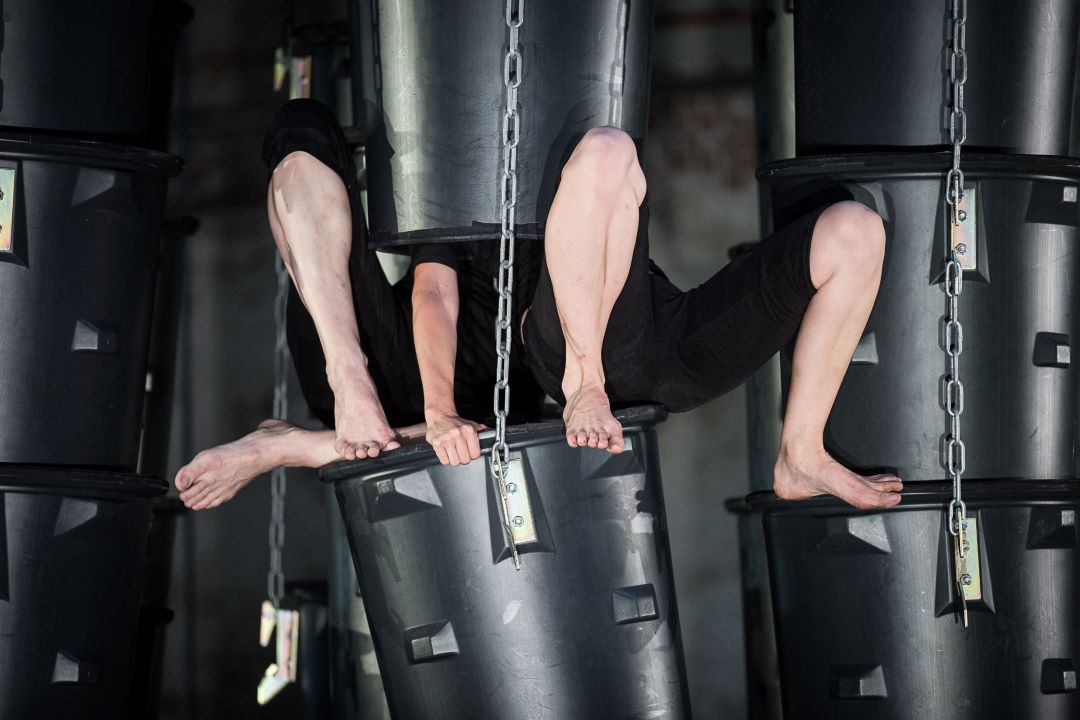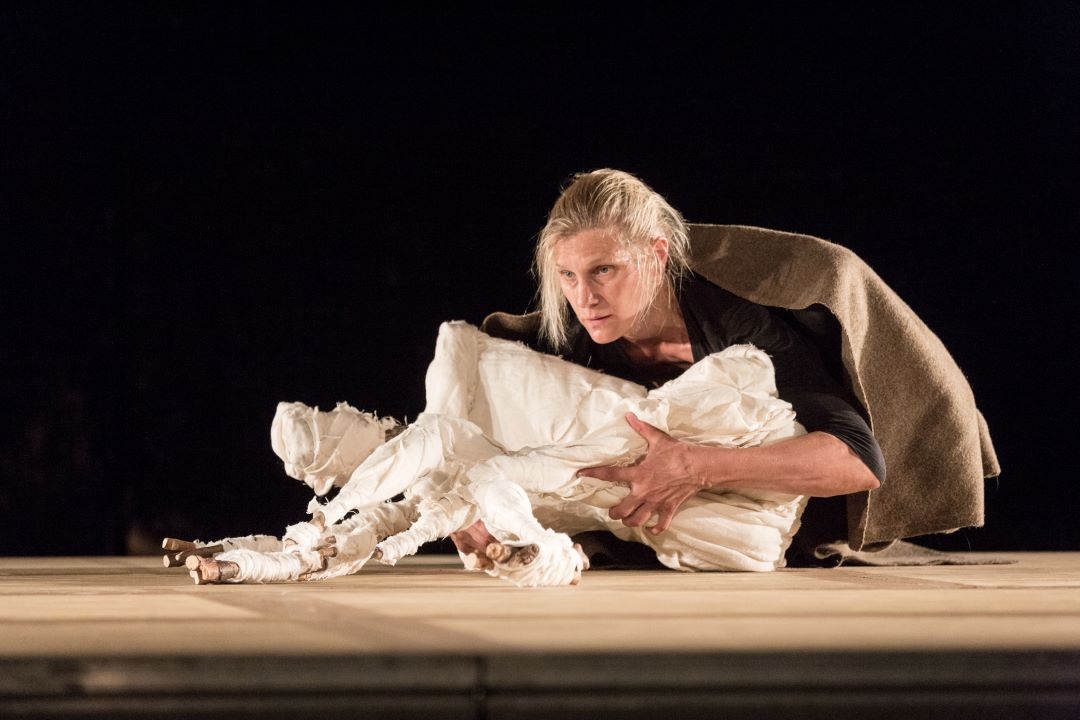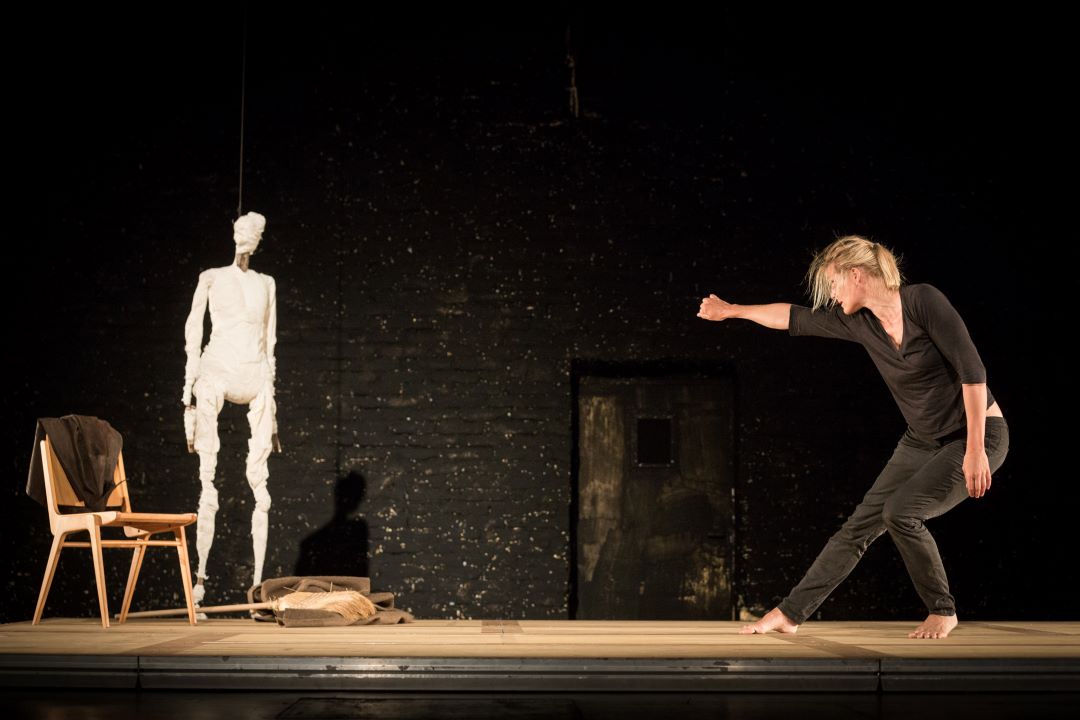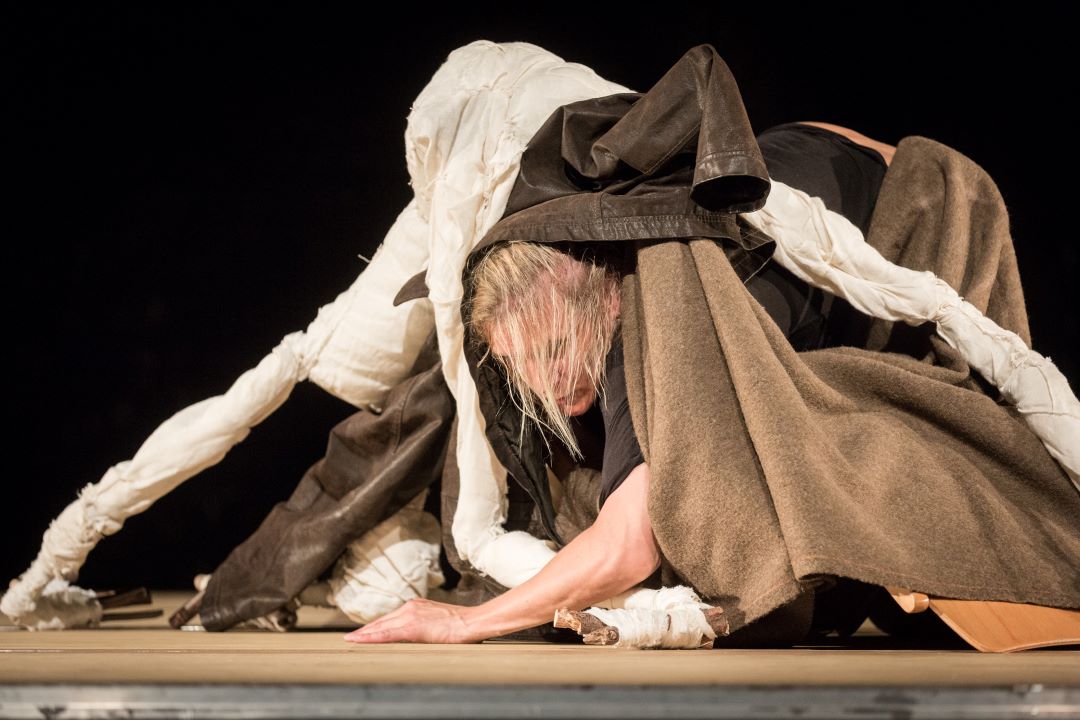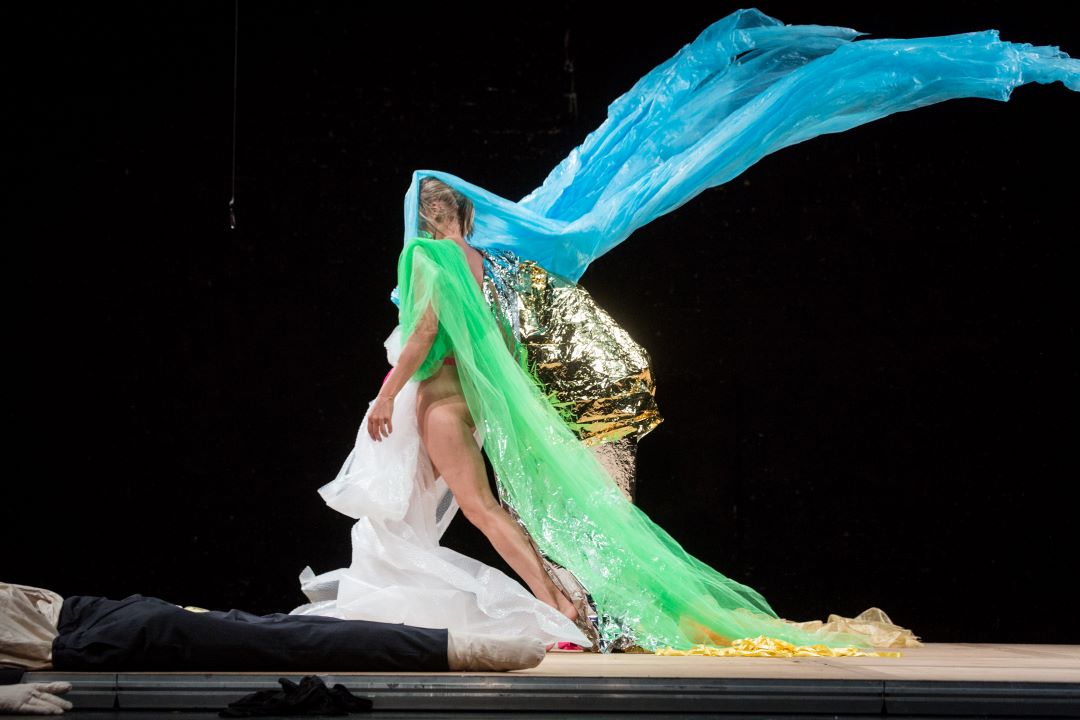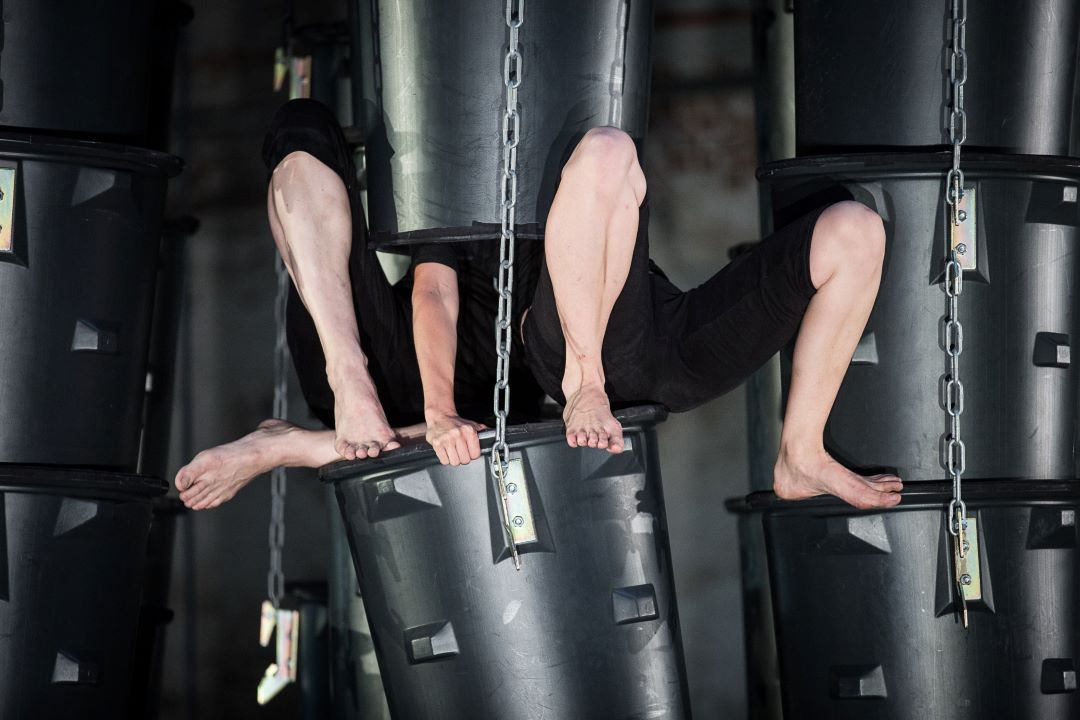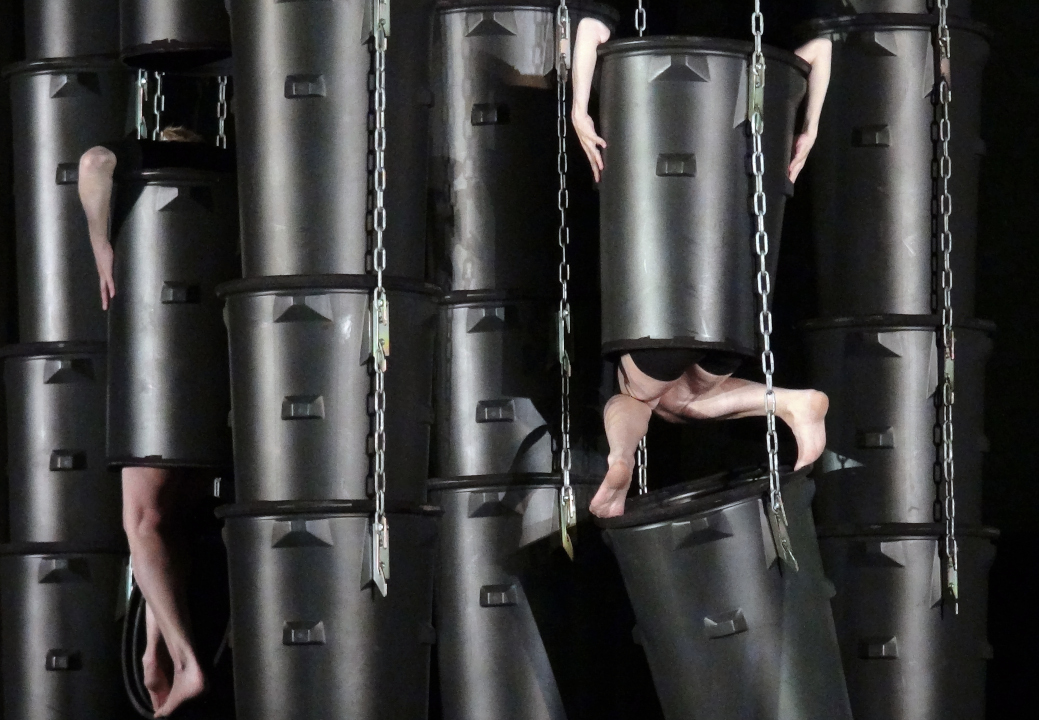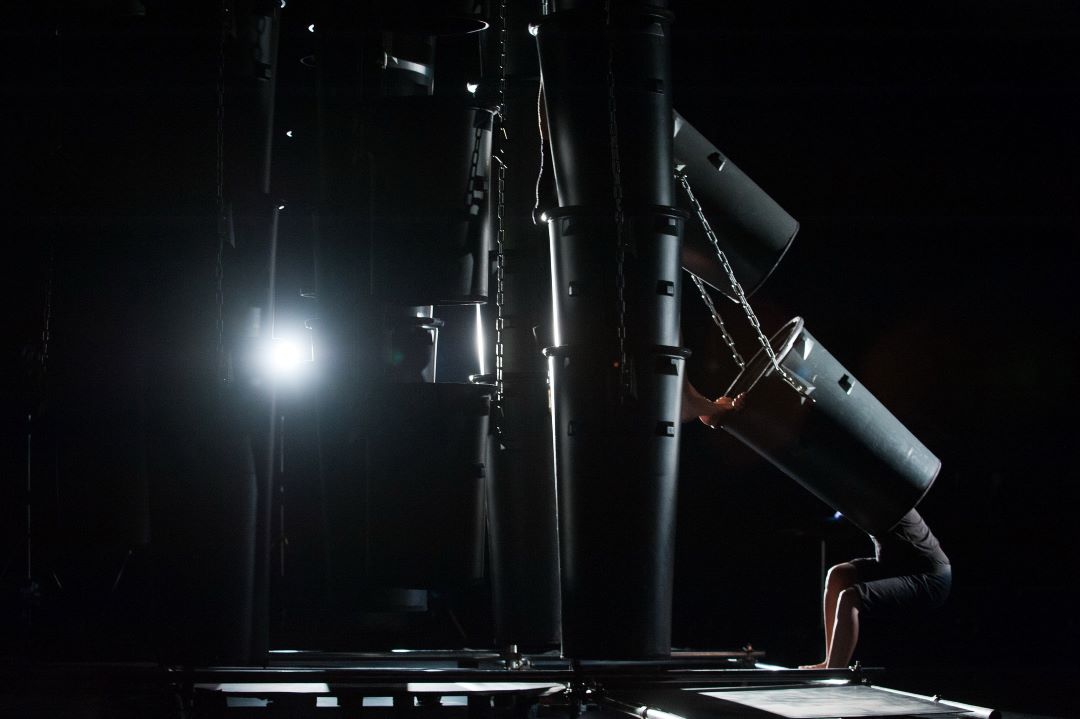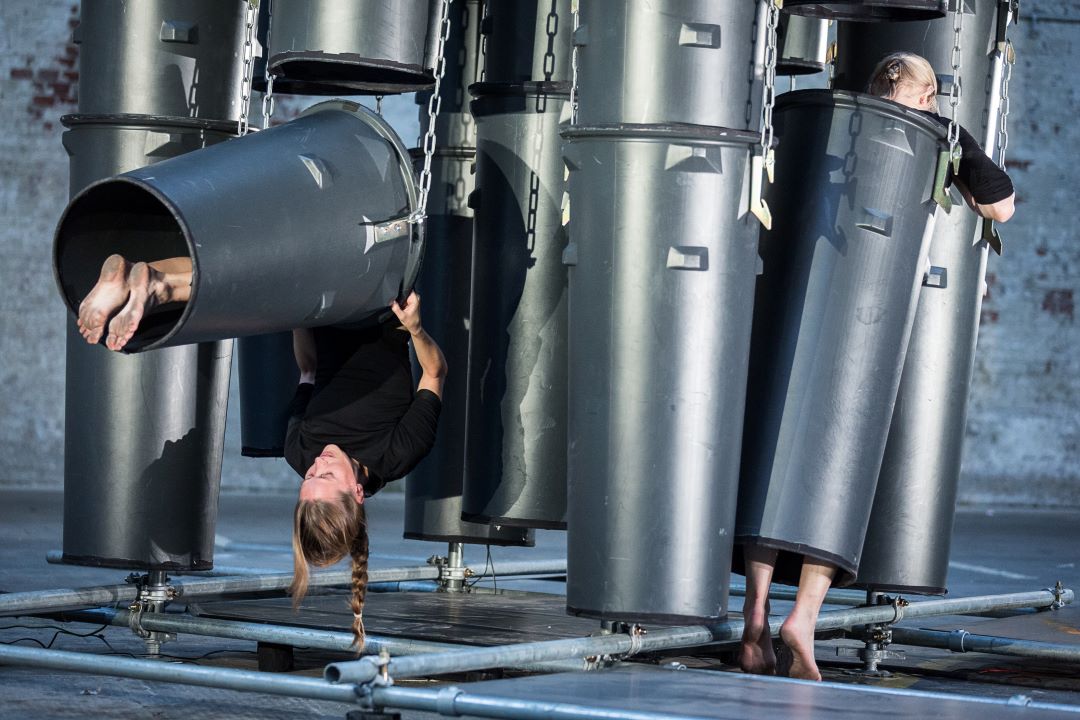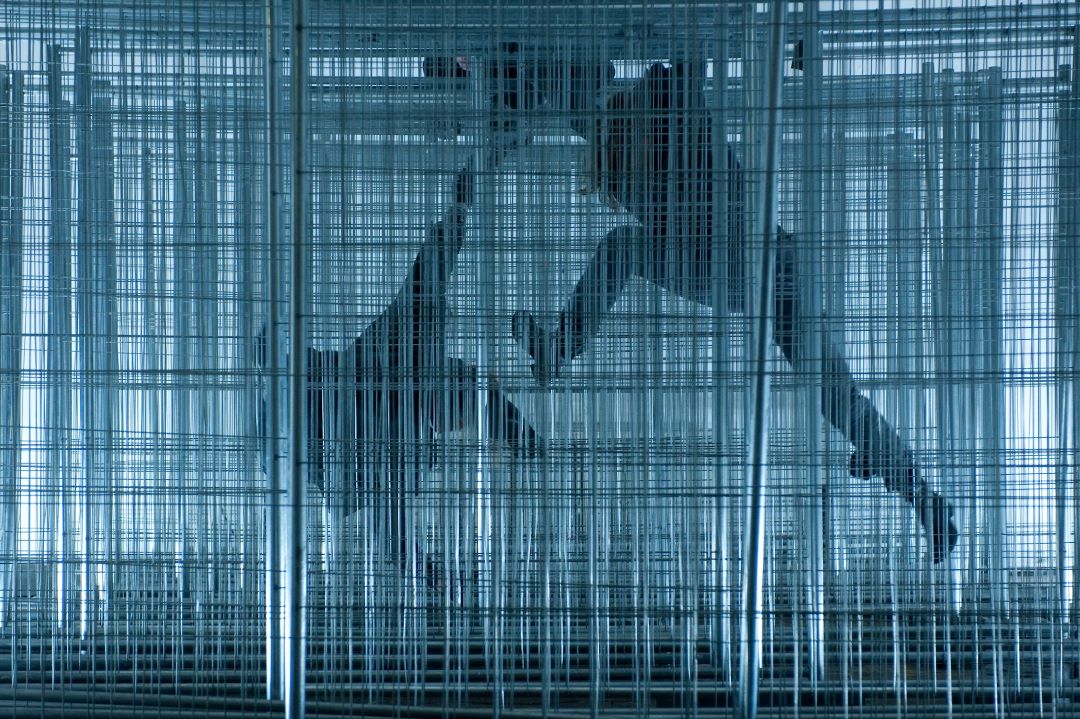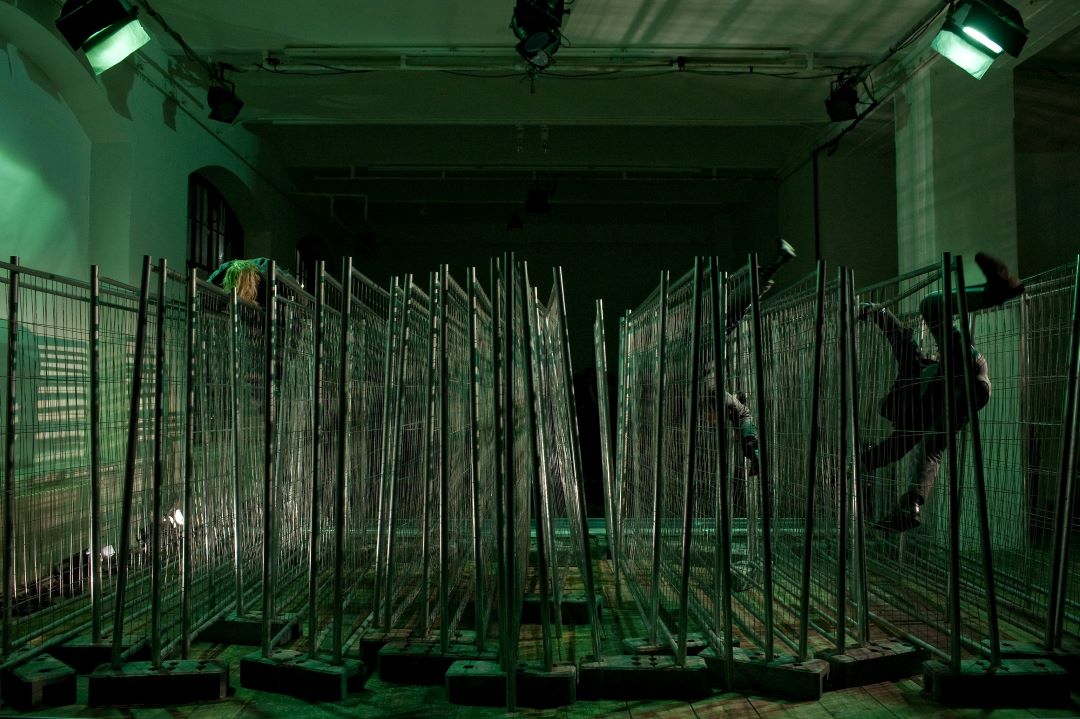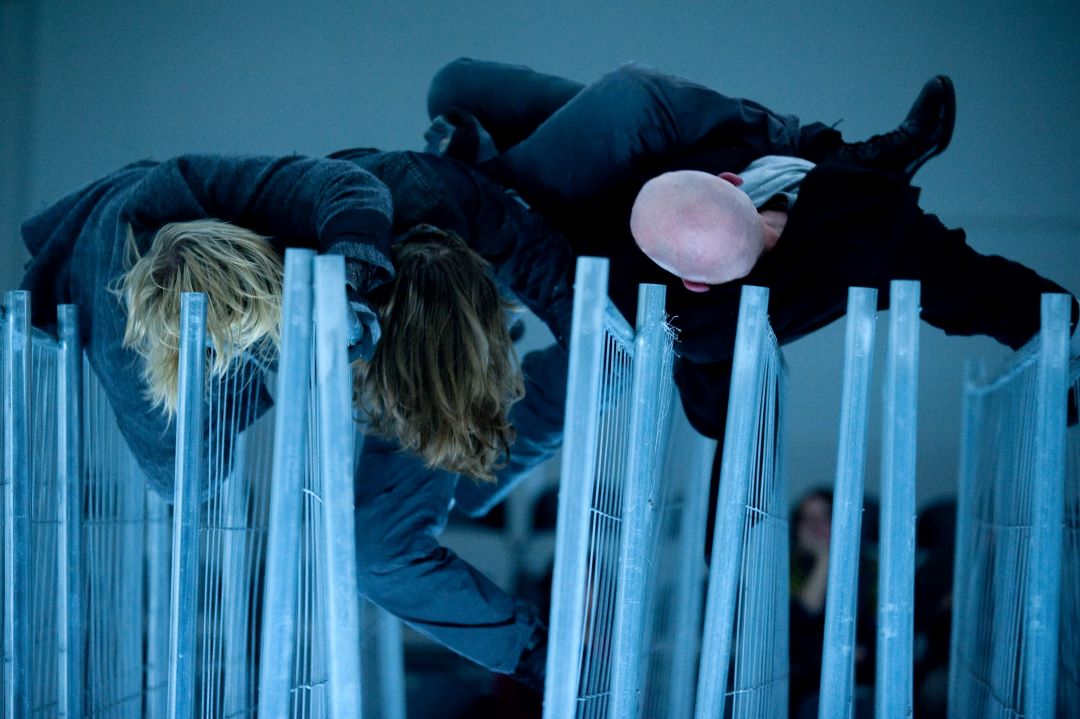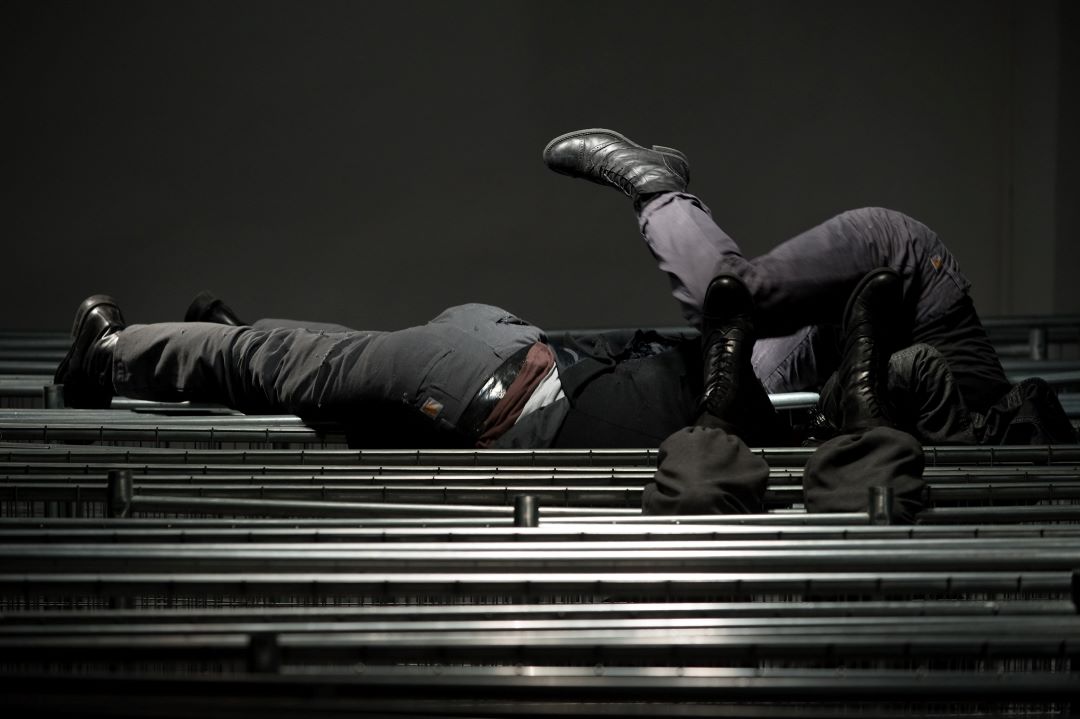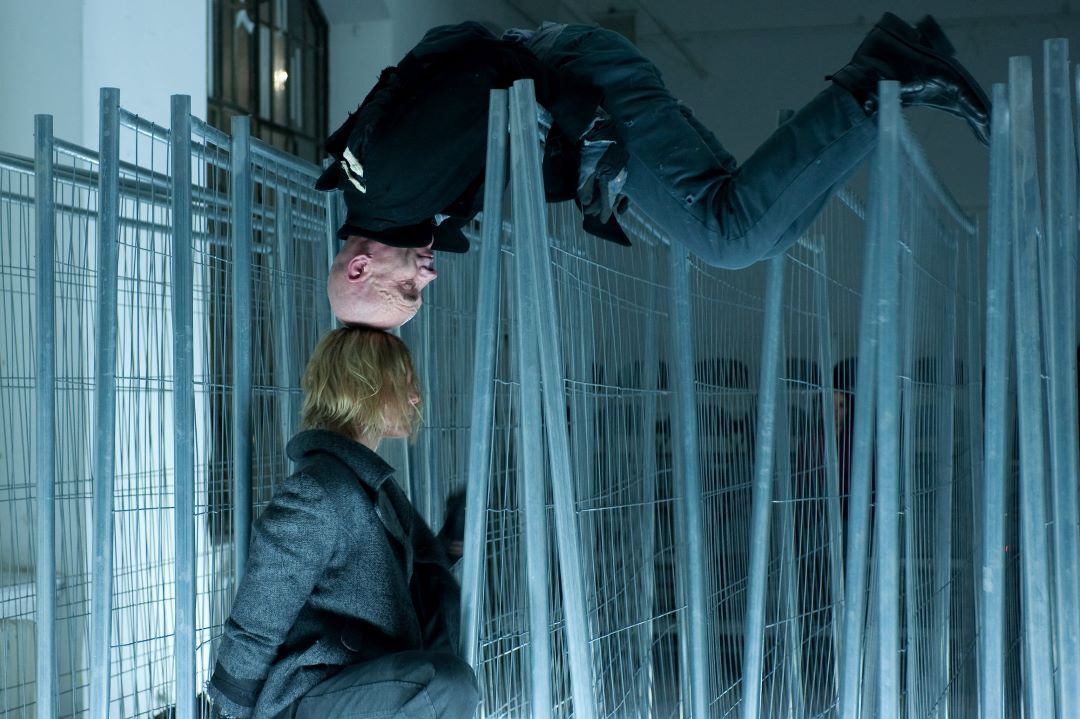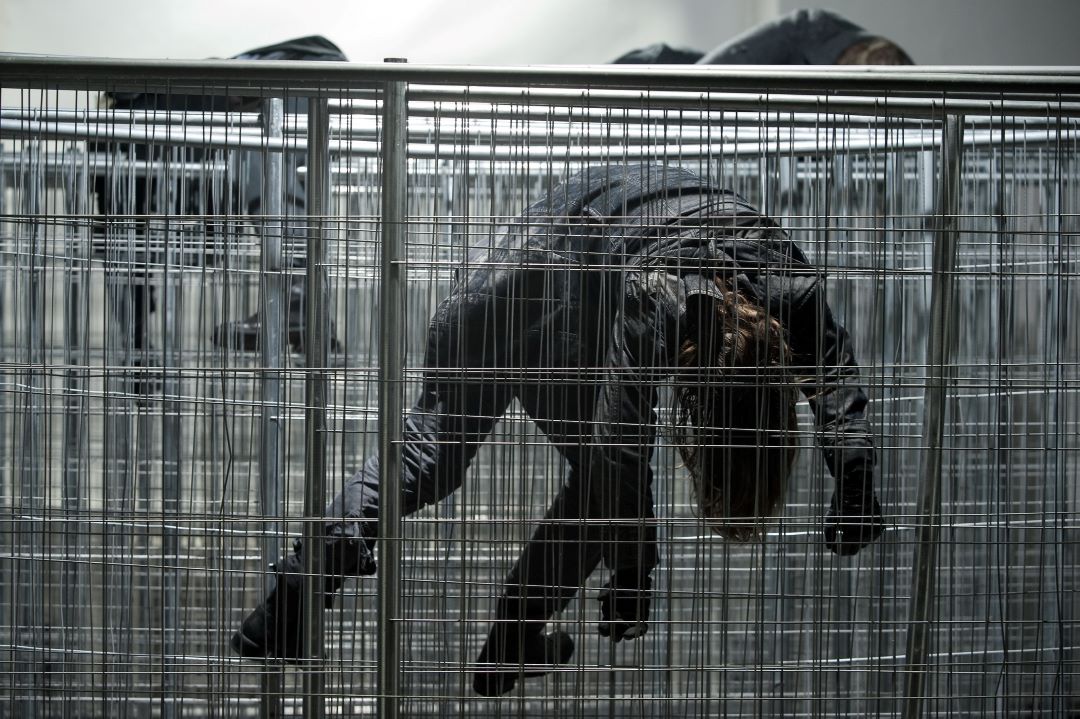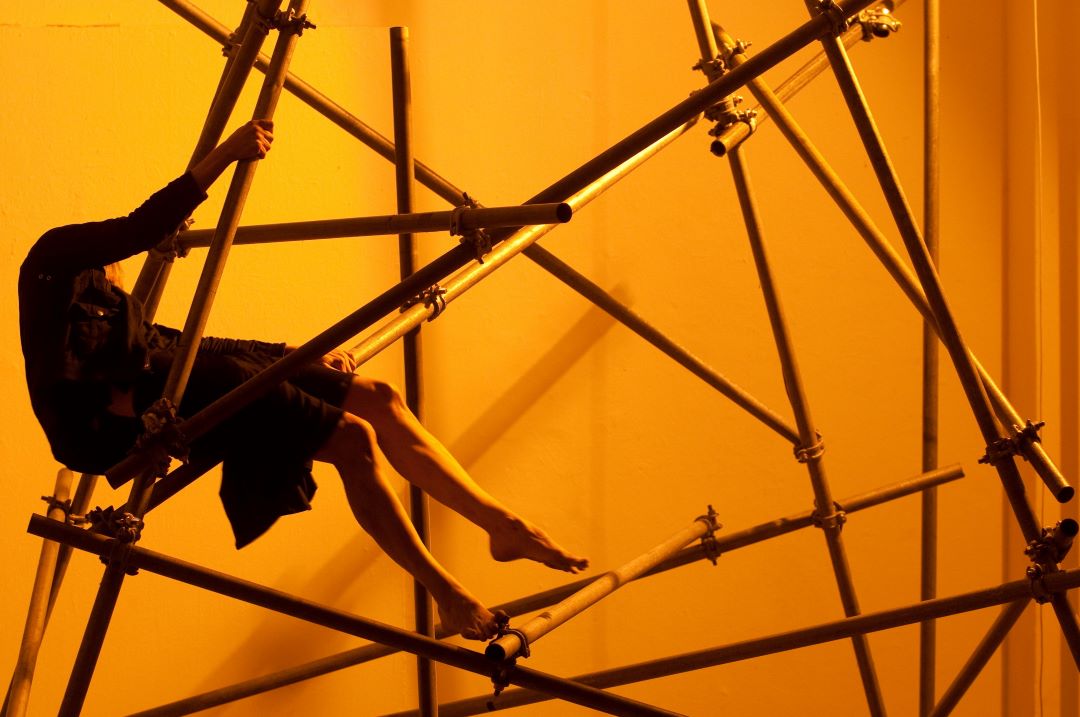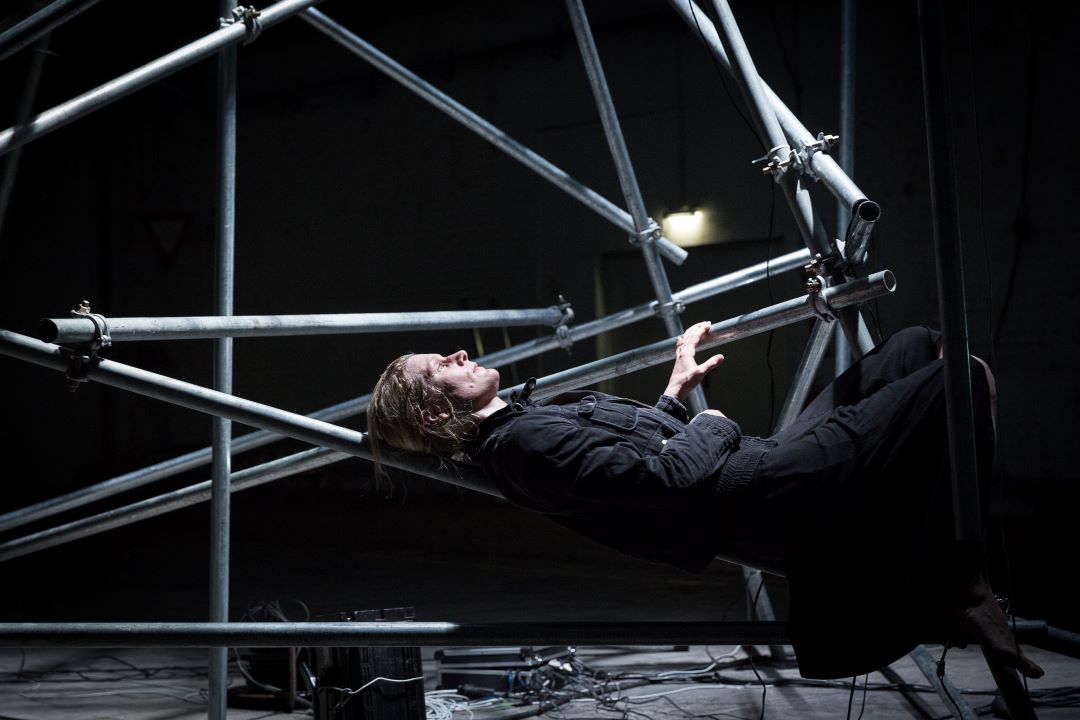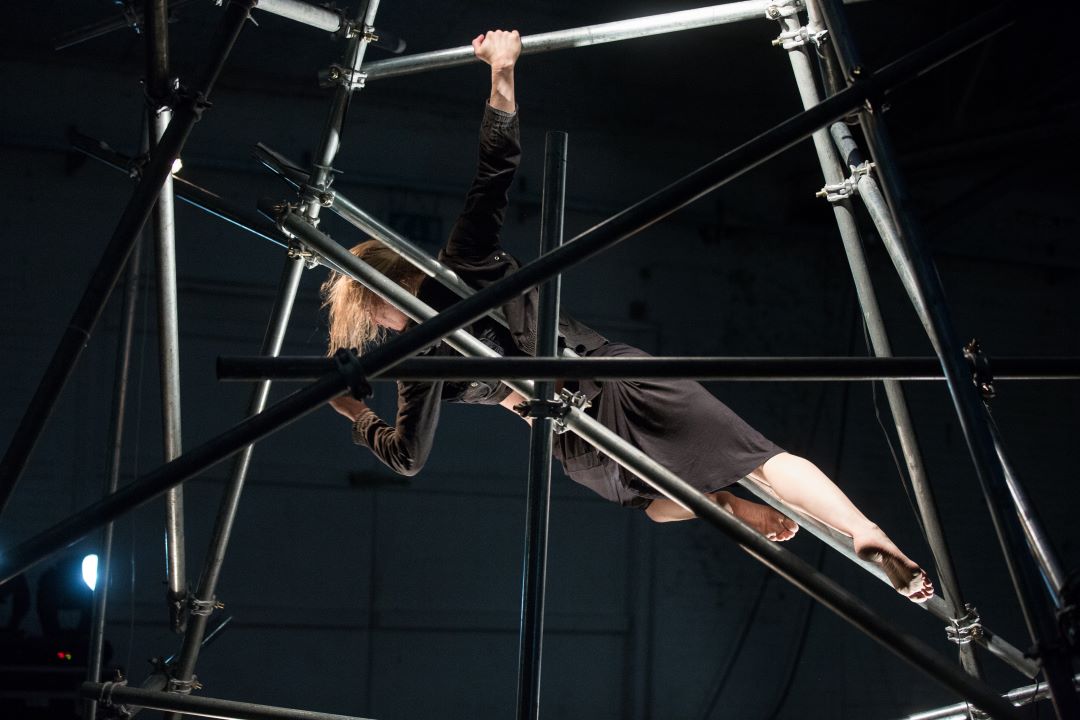PRODUCTIONS
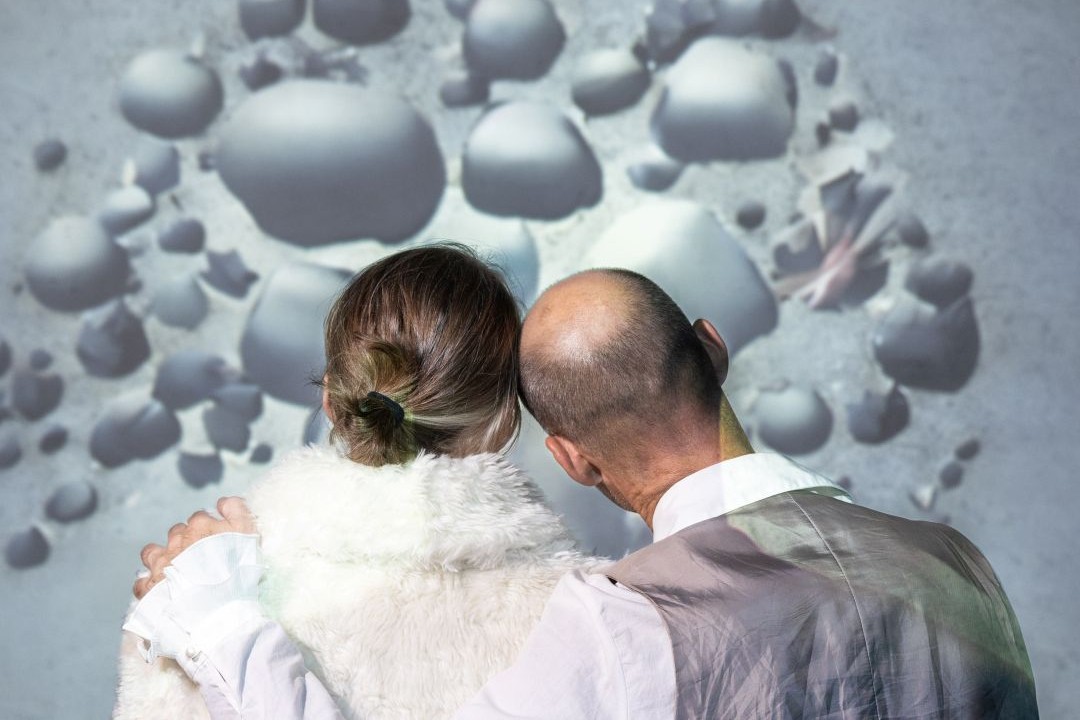

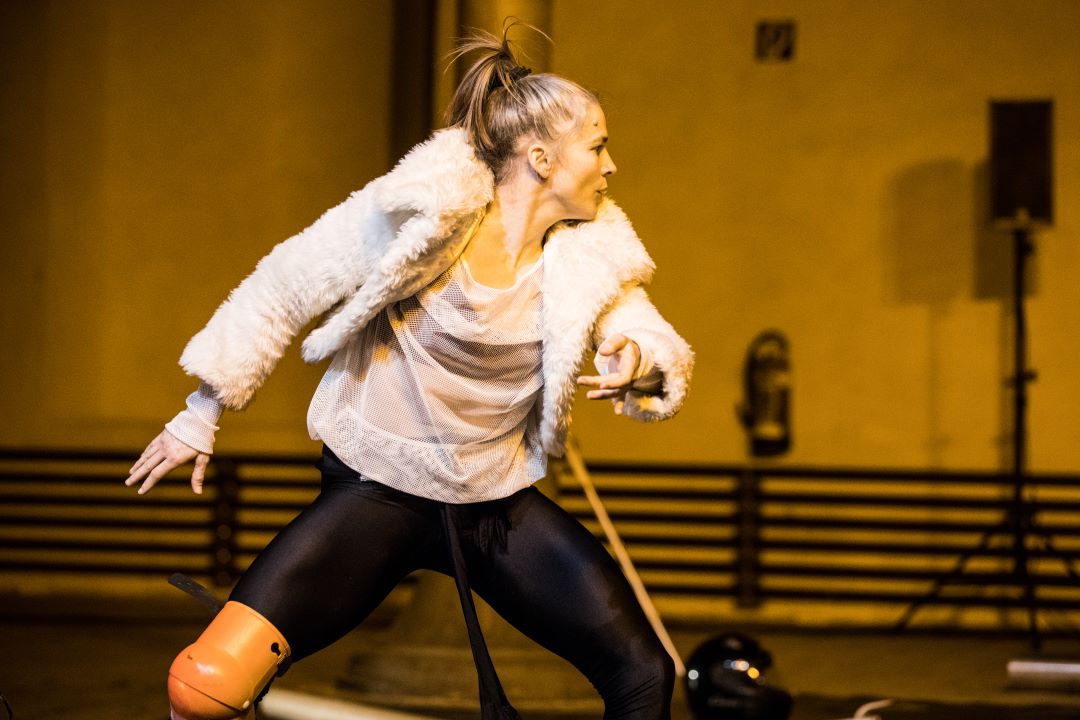



The signs of the times discussed in the media and in society are literally crying out for rigorous rethinking and
radical change. What usually remains, however, is a state of self-indulgent withdrawal that is shared with a few
like-minded people.
But are we really so different in our desires and needs?
Doesn't emphasising our differences make us weaker than emphasising what we have in common?
Cri des signes is a piece that addresses the departure from our own worlds into the collective. Out of the layers and
surfaces and into a shared, related world. It is about enlarging the radius of these commonalities, turning towards each
other and growing stronger together.
After all, it's not just our powerlessness in the face of major global issues that leaves us in a state of more or less
creative apathy. The excessive demands of an increasingly complex and digitally dominated everyday life and the many
small decisions and habits also contribute to this.
Remedies to prevent being trapped in one's own social bubble could include going out, joining in, getting involved in
something, challenging each other, but also adapting, trying something out together, allowing connections and also
tension in order to make something resonate collectively . . . to name just a few possibilities.
We also want to incorporate the monitors and AIs into our wildest dreams, not with apocalyptic or threatening
intentions, but full of a creative desire for change and fresh perspectives and always with the sunny side in mind.
Perhaps they will learn that from us too. That would change the omens.
World - Premiere: 14 January
2025, Das Off.Theater, Wien/AT, duration: approx. 60 min.
Further performances: 15
- 19 January 2025, Das
Off.Theater, Wien/AT
Artistic direction, direction: Saskia Hölbling; Dance, choreography: Saskia Hölbling, Ardan Hussain, Leonie Wahl; Video: Evi Jägle; Music: Heinz Ditsch; Lights: Reto Schubiger, Sound technique: Miriam Jochmann; Video technique: Jakob Figo; Video documentation: Maximilian Pramatarov; Press: Simon Hajós
DANS.KIAS: „cri des signes"
Rando Hannemann, tanz.at, 17 January 2025In her new piece, Viennese choreographer and dancer Saskia Hölbling confronts the all-too-clear signs of our times. The tendency to split into ever smaller feuding units and the retreat of the individual from participation, a tendency that is not only shattering the social and political landscape in this country but in the worst case even destroying it, is staged by the three dancers as an exhausting cry.
Three flat platforms stand like strongholds, as in “My House is my Castle” by the three dancers Saskia Hölbling, Leonie Wahl and Ardan Hussain. Evi Jägle's video installation projects fast-cut impressions of the interior life of contemporaries flooded with stimuli onto a diagonal asphalt-grey strip of dance floor. Crowds of people, fleeting, barely graspable images of a highly complex reality that cannot be processed in and because of their abundance, which whizz past you like reels and posts and tweets and yet rush through you to get caught up there.
Everyone deals with it in their own way. Saskia Hölbling, who has often shown her lyrical talent in her plays, recites in English. She uses it to frame the piece. She talks about digital worlds, about those marching in the uniform of diversity, about the bread and circuses of modern times: digital distractions as a lubricant for the journey into inner emptiness. Reto Schubiger's lighting is initially hazy, then, in conjunction with the music, separates scenes and moods, segments the stage and lifts the three performers out of the surrounding darkness.
Leonie Wahl is driven, but she fights. Her struggle to position herself in and in relation to this world and to herself - she tests various identities in her search for the answer to the question “Who am I?” - is an arduous, futile endeavour. Ardan Hussain is trapped. Exploring his room for manoeuvre and his narrow limits and accepting them, not without rebelling against them, give him something like freedom. Saskia Hölbling staggers back and forth, without stability or direction. She feels threatened and resists. All three are alone.
Heinz Ditsch embeds a series of pop songs in electronic sound and silence. The dramaturgy of these songs by Dire Straits, Anne Clark, Serge Gainsbourg, James Brown, Tricky and Shwamp guides the dance action, which ironically breaks and mirrors the musical templates. The classic “Je t'aime”, for example, becomes the dance of a conflict-laden relationship full of power struggles and aggression and the inability to open up and get close. Or, to “It's a Man's World”, Ardan Hussain slips into a hoop skirt and allows himself the - confusing - discovery of his feminine aspects.
This allows for rapprochement and an exploration of similarities. And Hölbling finds her way into self-expression. Drawing her circles, they empower themselves within them. They synchronise her movements, put on clothes as fleeting facades and masquerades and identify them as such. The dance of the three with their understated, modest and yet energetic presence is mature, places itself at the service of the subject, needs no effects and therefore radiates all the more powerfully. Marvellous!
The piece has not been granted any emotional impact. Nevertheless, it is relevant. It is part of a series of works by Hölbling in which she traces the effects of environments on the individual and its embedding in social structures. In this jointly choreographed piece, they examine many things.
The uprooting of the individual leads to habitual and textile disguises that are supposed to provide support like a mental exoskeleton. However, they are not conducive to identification with them. Uncertainty and lack of stability disguised as plurality cause fear. And that makes us aggressive. Shadow boxing into nothingness and relationship battles tell of this. Powerlessness and hopelessness give birth to resignation. This is followed by flight or attack, depression or aggression.
Polarised and polarising proclamations of simplified truths that have been shifted into the virtual world are evidence of frayed value systems and the power of the irrational. Where phantoms are given power and false idols value, the self must take a back seat. Diversity is a colourful façade, behind which the same resentments that always affect the other are cultivated and lived out, closely guarded by the unconsciously protected non-sufficiency.
They reassure themselves of what they have in common and then go their separate ways again. But with a consciousness raised to another level that will allow them to live differently from now on. In their final dance with black bands stretched into the room, they show the entanglements in media landscapes, virtual realities, social and societal corsets and psychological conditioning. But also that it is possible not only to escape them, but to live with them, to use them constructively. Provided that we become aware. This hint of hope makes "cri des signes" a delicate, even tender utopia for a world on the brink of disintegration.
Society in Uproar
Angela Heide, tanzschrift.at, 18 January 2025“I've no wish to stand up and speak”, is the opening line of cri des signes: but it is precisely this cri, this cry, or call, a kind of dark, desperate appeal to today's societies, with which the new piece by Austrian choreographer and dancer Saskia Hölbling at Vienna's Off-Theatre begins.
Her voice has “too little power”, Hölbling's character continues in her opening monologue. The stage: three square performance platforms placed at different points in the theatre space. At the edges are grey plastic boxes for seating, visible at the back right: the technical console. In the course of the sixty-minute production, a little above the floor of realities the three main playing platforms become places of retreat and revolution, spaces of love and farewell. Hölbling and her two co-choreographers and dancers, Leonie Wahl and Ardan Hussain, embark on a musically structured revue-like sequence, they enter into ever new choreographic territory: they are “brothers” (and sisters) “in arms” and “men” in a “world of men”, then again “prophets” and belligerent lovers. Each of these danced “cries” seems to be a fragment of the indignation cited at the beginning about a “comfort world”, a world in which only some people can make themselves comfortable, while others are constantly on the run. A grey bin bag containing a series of items of clothing, which Wahl puts on and takes off on one of the platforms at the beginning, is what it is - and at the same time a place of events: new identities emerge from its interior, changing the spaces as the play progresses, but also their wearers. At the end, Hölbling lays out the pieces once again in different configurations, shifts them several times on the small stage she has been given, allowing new figures to appear again and again to characterise this world of signs and meanings.
“my turn to stumble, my turn to fall”
By the time the sack creatures find themselves in their final location, Wahl, Hussain and Hölbling have searched for positions and configurations in different ways, immersed themselves in “urban nightmares”, but also in “positive feelings” and “martial arts”, stumbling and plunged into a whole series of dark fears (“fear all the time”) in the trenchant “disco light” (Reto Schubiger) of the evening. As in her last work, fragments of desire, which was also shown at Vienna's Off Theatre a year ago, Hölbling also avoids linear narratives in her new project, but always gives her choreography readable passages that alternate with less narrative sequences.
In this way, the “individual worlds” cited in the programme become just as clearly visible through the performance of the respective but shifting “solo spaces” as moments of community, or at least “commonality”, even if it is only the shared items of clothing. Or an incipient love story that mutates into a fierce battle, then again into an almost clownish scuffle. Again and again, the three performers come together out of their own narrative spaces, remain in the choreographed community space for a short time without giving up their respective characteristics, only to separate again from here in duets or solo passages (the “Gentle”, the “Acrobat”, the “Warrior” etc.).
“sleeplessness strikes the eye wide open”
Several times during the evening, a digital urban landscape (video: Evi Jägle) is superimposed on the dance floor, which is laid across the stage from left to right at a slight angle - these are deliberately overwhelming, intoxicating images of a world going to pieces, flashing up in a matter of seconds, whose shrill media cris des signes prevent calm - and at the same time create apathy: “the excessive demands of an increasingly complex and digitally dominated everyday life”, according to the programme.
déformation humaine
At the end, Hussain and Wahl divide the space anew with wide black rubber bands like laser beams, dissecting what has been seen up to that point one last time. - With cri des signes, Saskia Hölbling succeeds in creating a powerful evening that doesn't just linger in the nightmarish, in which something like hope, or at least a smile, always seems possible in view of the paradoxes that it continually opens up in the encounters between spaces, bodies, echoing sounds and song texts.
Saskia Hölbling's cry for a wasted future
Helmut Ploebst, der standard, 15 January 2025The signs have been pointing to a storm for a long time. Because they have not been paid the proper attention, a political hurricane is now tearing at ill-prepared societies. Viennese choreographer Saskia Hölbling reacts to this with her new piece Cri des Signes - Scream of the Signs - which is currently showing at the Off-Theatre. What the title announces somewhat luridly does not materialise on stage. Cri des Signes has become a normal choreography of human entanglements, in which Hölbling dances together with Leonie Wahl and Ardan Hussain to show that something is going wrong. The result, roughly sketched, is a portrait of a community in which there is a lot of gesticulation without any drastic consequences.
This is precisely why Hölbling touches a particularly sensitive nerve in the masks of pure conscience that are so conspicuously worn these days. The trio, in their moderate scream of the signs, downplay their sensitivities, with barely identifiable digital video images (Evi Jägle) projected onto the floor from time to time and a pleasing mix of music guiding the action to somewhere.
Uncanny normality
This is how our sweaty postmodern media societies have gambled away, babbled and droned their future so far. The signs in the storm are not screaming out of embarrassment, but in the face of all too late realisation of this embarrassment. “Distractions are the lovers of this comfort world”, says Hölbling in the piece, noting that dictatorship and the mainstream survive: with militant bargaining and the worthlessness of our lives.
The three characters valiantly seek to come together, which should bring a certain comfort. After all, everything goes on, and the audience doesn't have to go home completely downhearted. Cri des Signes has not produced a masterpiece, but it marks the uncanny normality of what is now threatening to capsize us.
A DANS.KIAS production. In co-production with the OFF.THEATER and with support of the Cultural Department of the City of Vienna
In her work “fragments of desire”, Saskia Hölbling avoids linear narratives in order to give the audience a
clear view of the world. Instead, DANS.KIAS catapults us into the centre of a kaleidoscopic fanning out of human
gatherings, linguistic embeddings and situational absurdities.
In “fragments of desire”, Hölbling choreographically sketches a wide variety of situations that relate to global events
as well as those that concern us in our daily lives.
In this way, “fragments of desire” opens up paradoxical and touching perspectives on us humans with all our idiosyncrasies. And shows how disorientated we can sometimes be when the signs around us change. That everything is always changing, even though we long for stability and continuity. “fragments of desire” refers to the fragility of the topographies and structures surrounding us, the power of words, images and touch, but also their fleeting nature.
World - Premiere: 16 January 2024, Das Off.Theater, Wien/AT, duration: approx. 60 min.
Further performances: 17 - 20
January 2024, Das Off.Theater, Wien/AT
Further performances: 05, 07 + 08 August 2024,
Das Off.Theater, Wien/AT, in the frame of IMPULSTANZ
Artistic direction, direction: Saskia Hölbling; Dance, choreography: Saskia Hölbling, Ardan Hussain, Leonie Wahl; Video: Evi Jägle; Text:Saskia Hölbling, Leonie Wahl; Music, composition: Heinz Ditsch; Lights: Reto Schubiger, Sound technique: Miriam Jochmann; Video technique: Jakob Figo; Video documentation: Maximilian Pramatarov; Production, press: Simon Hajós
Atomic mushroom cloud full of confidence: Saskia Hölbling's “fragments of desire”
Helmut Ploebst, der standard, 17 January 2024The Viennese choreographer explores the balance between social desires and disappointments in the Off-Theatre.
That sounds somewhat reassuring: “The images are exuberant, but comprehensible.” But in the next breath, the sedation cracks: “The words have nothing more to say, but that will pass.” And so a joke about the popular euphemism is inevitable: “The mushroom cloud is rising, but full of confidence.”
So “fragments of desire”, the new work by Viennese choreographer Saskia Hölbling, is not harmless. It is now having its world premiere at the Off-Theatre - and delivers what a preview in December promised: it uses precise artistic instruments to measure the current balance between social desires and disappointments.
Because this measurement takes place in a present whose complexity no longer needs to be pointed out by art, the dancers Hölbling, Leonie Wahl and Ardan Hussain create a simplistically fragmentary structure in the piece. Between dance and music, texts and digital video animations, outlines of an emotional and rational overload emerge. Not as a swan song, but as an attempt to cope and endeavour to avert tipping over into the abyss of disappointment after all.
“fragments of desire” demonstrates a fundamental disturbance, but the trio concentrate on preventing this from turning into panic. With success. The piece neither falls apart nor does it drift into cynicism. Hölbling proves that it is not necessary to flee from dance in order to present controversial content in a performative way. And she succeeds in pointing out that it is not exclusively language that shapes our reality, but that social behaviour and action shape language.
DANS.KIAS: „fragments of desire“
Rando Hannemann, tanz.at, 21 January 2024“As if the world were a bed of roses!” The deep connection between form and content cannot always be experienced as consistently as here. Dance, theatre, text, language, visual art, music and sound, installation. And images, news, information, situations. And thoughts, emotions, states, sensory impressions. Saskia Hölbling and her company DANS.KIAS mix these tools, the outside and the inside, to create “fragments of desire”, which premiered at the OFF-Theatre in Vienna.
It is a jumble of short sequences which, with this very arrangement, their respective performative character and the aspects they address, come crashing down on us like real life. In her high-speed video animations, Evi Jägle shows series of images and films that hammer war and destruction into the auditorium, people confronting it on their own, resistance and demonstrations from all regions of the world and the destructive existence of urbanised people. Through dance and performance, people suffer, doubt, despair, search, defy, fight, hold on and love.
“The mushroom cloud rises, but full of confidence.” They put the cynicism of interest-driven argumentation, whether political, social or individual, into poetic words. The texts by Saskia Hölbling and Leonie Wahl expose populist oversimplifications on the one hand, while exposing the hidden intentions of the arguments behind even the most inhumane and destructive acts on the other. Hölbling's poetry leads to paradoxes whose denial of reality and dissociative attitude are the image of an oppressive, individual intrapsychic reality. And this creates discomfort.
The fullness, diversity and complexity of the world in which we live and, in particular, the omnipresent destructiveness of humans, both in the media and in reality, directed against fellow human beings and the planet, are increasingly overwhelming. It is humans themselves, the perception of whom as primitive destructive beings is discouraging. What follows is a life that balances on the precipice of despairIt is no longer possible to process the impressions and information we consciously and unconsciously absorb in a qualified manner; positioning ourselves in our world seems illusory. The challenges lead to excessive demands. The three performers' efforts to find a strategy for dealing with them come to nothing. The emotional confusion leaves disturbance and inner chaos as a reflection of the outside world. Dance as an expression of the unknowable, sex as a narcotic, desperate cries as an outlet.
In their many solos and duets, the three unique dancers Saskia Hölbling, Leonie Wahl and Ardan Hussain (all in their mid-40s) show that artistic and life experience can bring radiance to dance. Each has their own moments that get under your skin. Saskia Hölbling, for example, touches the audience with a solo she performed in the first show in December. She feels inside herself to recognise what is happening and what is happening to her.
Ardan Hussain, who dances the most dynamic solos, and Leonie Wahl also seek orientation. In theatrical scenes, Wahl only successfully squeezes whole words out of herself on the second attempt. Unsorted like her inner life. In this work, historiography is put the right way up. The facts of the world and the contradictory nature of values generate emotions and sensitivities that become deeply engraved in the psyches of those involved and affected and are passed down through generations far into the future. Uncertainty and fear have an impact on society from below. The popularity of populist simplifiers in politics and society around the world is rooted in this. And, incidentally, Marx's old thesis “Being determines consciousness” and the new one about the power of language to shape consciousness are also scrutinised here. This takes the piece beyond stocktaking.
The emotional states, desires and needs, the impulses and urges, the emotional and rational strategies change abruptly. They also perform desperate attempts to escape insecurity by violently maintaining the status quo. Above all, however, there is a tremendous fragility. The temporary becomes the unifying aspect. Frequent, violent breaks chase the audience through "fragments of desire" without fragmenting the piece itself. At its end, the faded writings of the scholars, the stories of people's lives, their dreams, hopes, wishes and possible futures, their pain and their fears lie before us as a pile of rubble. The long sheet of paper, previously written on in colour and with dance, ends up on stage as a crumpled bundle. Unfortunately, the final image is far too short. No time for contemplation and reflection, which would have been desirable after such a dense, complex work.
A DANS.KIAS production. In co-production with the OFF.THEATER and with support of the Cultural Department of the City of Vienna
With "inhabit the impossible", DANS.KIAS has taken the risk of placing the unimaginable, the impossible, at the centre of
a transdisciplinary project.
Since spring 2021, the choreographer and dancer Saskia Hölbling and the philosopher Arno Böhler have been meeting
regularly and have invited people from very different backgrounds to open up spaces of thought and prepare the ground
for "inhabit the impossible".Together with the dancers Ardan Hussain and Leonie Wahl, the media artist Evi Jägle, the
quantum physicist Tanja Traxler, as well as the video artist Kay Walkowiak and the musician and composer Heinz Ditsch
new artistic strategies were developed and the possibilities of the impossible explored.
Mythology and science fiction join hands, phenomena beyond our imagination open up new possibilities and between
intuition, flashes of thought and fleeting formulas of life, new possibilities emerge. It's an invitation to experience
this habitat of the impossible together.
World premiere: 17 January 2023, WUK, Wien/AT, duration: approx. 120 min.
FIELD-PERFORMANCE INHABIT THE IMPOSSIBLE
Artistc direction: Saskia Hölbling;
Scientific direction, philosophy: Arno Böhler;
Choreography, dance, performance: Saskia Hölbling, Ardan Hussain, Leonie Wahl;
Lecture-performance: Arno Böhler, Susanne Valerie Granzer;
Media art: Evi Jägle;
Video art: Kay Walkowiak;
Quantum-physics-performance: Tanja Traxler;
Music, sound design: Heinz Ditsch;
Lights design: Reto Schubiger;
Costume: Evi Jägle & DANS.KIAS;
Stage: Marco Tölzer;
Production & public relations: Simon Hajós;
Video-documentation: Maximilian Pramatarov
GUEST-PERFORMANCE
Black Hole:
Jyoti Dogra
PUBLIC WORKSHOP INHABIT THE IMPOSSIBLE
Team: Michael Boch, Elke Pichler, Mira Magdalena Sickinger
Light-installation: Elisabeth Wildling
Artistic-research: Janhavi Dhamankar
And Adonis farts
Verena Franke, Wiener Zeitung, 18 January 2023(...) Saskia Hölbling challenges her audience. The Viennese choreographer has always felt that simply sitting in her performance and letting what she sees take effect is not enough. In her current work, “inhabit the impossible”, which premiered at the WUK on Tuesday, she goes one step further than usual, requiring the audience to listen and think right to the end. (...) (...) Together with the performers Ardan Hussain and Leonie Wahl, the media artist Evi Jägle, the quantum physicist Tanja Traxler, the video artist Kay Walkowiak and the musician and composer Heinz Ditsch, an opulent, transdisciplinary work has been created that challenges all the senses: there are scenes based on Hölbling's movement repertoire in all possible formations distributed throughout the room with expressive props, interspersed with video projections on three screens and countless text fragments. Explanations by Böhler and Jägle clarify the performative and philosophical concept of space and time. Past meets future, the god Chronos meets environmental pollution. And Adonis farts. Worth seeing! (...)
Das Mögliche im Unmöglichen
Paul Delavos, tanznetz, 20 January 2023(...) With her current production, a “cross-disciplinary field performance”, the choreographer Saskia Hölbling challenges the audience. On show is a mixture of dance, video, sound, and philosophical and quantum-physics lectures. (...) (...) The dance moments are characterised by great physicality and the transfer of impulses. Much of it seems very delicate, almost vulnerable; one sees no grand gestures or scenes. The composer Heinz Ditsch provides the appropriate soundscape. (...)
Saskia Hölbling and Jyoti Dogra at WUK Wien
Rando Hannemann, tanz.at, 27 January 2023What is the impossible and how does it relate to the possible, to reality? What meaning, what value can be attached to it? And how might a performative exploration of these questions be shaped? In their work “inhabit the impossible”, premiered here, Vienna's Saskia Hölbling, her company DANS.KIAS and the philosopher Arno Böhler shatter the boundaries of art, philosophy, physics, mythology and science fiction and combine them into a dense, demanding cross-disciplinary field performance. The Indian performance artist Jyoti Dogra crowns the three-part event with her subsequent performance “Black Hole”.
Extending over more than a year, the exchange between the artistic director, choreographer and dancer Saskia Hölbling, the scientific director Arno Böhler, the dancers Ardan Hussain and Leonie Wahl, the media artist Evi Jägle, the quantum physicist Tanja Traxler, the video artist Kay Walkowiak and the musician and composer Heinz Ditsch, with the aim of exploring “the possibilities of the impossible”, resulted in a multidisciplinary work in which all participants, starting from their artistic or research realms, meet on a common stage setting.
Seven days earlier, this premiere was preceded by an almost three-hour open workshop with philosophy PhD students Michael Boch, Elke Pichler and Mira Magdalena Sickinger from the Vienna PhD School at the University of Vienna. Philosophical, literary and poetic texts, the foundations of Indian yoga, discursive-performative participation by the audience - the results were surprising - and a dance piece by the Indian dancer and philosopher Janhavi Dhamankar in a light and space installation by Elisabeth Wildling, which juxtaposed Western thinking in polarities with the Eastern alternative of both/and, intertwined spiritual science and art, intellect, physical and sensual experience. Offered to the audience without any preconditions, the workshop proved to be a valuable and meaningful format in its own right, but in its theoretical parts it was intended for the philosophically trained and engaged. As a counterpoint to the joy of thinking, the dance performance was a clever physical reflection that overcame polarity.
The performance “inhabit the impossible” is played on the large round stage (by Marco Tölzer), in three sections surrounded by the audience and connected by three screens, and with a circular clay surface and a shallow watered oval, drawing the audience into the action on this (stage) earth and into shared responsibility for them, as a field of experimentation that is both specific to and permeates the genre. And how does one dance the impossible which partly becomes the possible, becomes reality, and thus generates new possibilities again? The fluctuation of particles in a vacuum (from the energy latent in it, particles of matter are created for the shortest periods of time, which immediately disintegrate again) becomes a fluctuation of thought fragments, which, expressed in movement, reflects this physical principle in its immediacy and incoherence. Likewise the dance. Alone, in pairs, in threes, they form sculptures that, pausing briefly in the flow of movement, describe the emergence and decay of materiality in physical energy fields.
The entanglement of particles that remain communicatively connected to each other over unlimited distances in the universe and without time difference (the question of whether the speed of light is actually the maximum possible is thus urgently raised) becomes the entanglement of bodies that penetrate each other without touching. In their grey men, they seem to re-enact on the table the process of entanglement observed by the physicist, the search for a possibility of bonding.
Video animations and photographic works by Kay Walkowiak, which accompanied the performance on the three screens, showed worlds of animated planetary models, mystical places of nature, fragments of human civilisation or virtual realities sprung from the imagination. The photos, centrally mirrored images of unreal realities, seemed like pairs of entangled particles that want to follow their henceforth separate paths with opposing spin.
Whether with pulsating dark droning or shrieking winds, squeaking strings in dissonant staccato or bright cymbals, the range of Heinz Ditsch's sounds, between electronic sound and acoustic music, stands for the range of the piece's themes and accompanies the performers as does Reto Schubiger's lighting design - apart from partial brightenings largely covered. Arno Böhler takes a humorous approach. His “vortex column”, created from one of the cardboard tubes and a multifunctional metal spiral placed over it, stands for his effort to soften the gravity and seriousness of the subject matter with a playful approach. Included in this image is the allusion to the abundance of metaphors in the work. In addition to constant attention, what they otherwise convey (Saskia Hölbling also shows herself to be a remarkable poet) requires a basic knowledge of philosophy and physics. Equipped with this, the immense range of density and thought, the poetry of the linguistic and physical images and the dramaturgical wit find their destination in brains and hearts. Reflections on the nature of time, duplicity and chronic repetition, on art as a place for the impossible, on beauty, the devil and death, on the incomplete, imperfect nature of every image of reality, on the up and down of Meister Eckhart, about Nitzsche's Zarathustra and Spinosa's immanence without transcendence and his thus philosophically anticipated physics, about that and the folding of space, about Schrödinger's cat in its superposition of life and death and its quantum-physics reality . . .
And they do not hold back from criticism. Clothed in plastic in the oval sea, humankind at the end of all food chains, as the self-important crown of creation and ruler of nature and yet only its destroyer. An image also of sawing at the branch, of rejecting the nurturing hand. They exhibit short-sighted stupidity, ruthlessness against the environment and oneself. Driven by greed. Like a ruler enthroned on high, the man stands on a ladder, with a nylon stocking-covered, impulse-clouded gaze, directing two women on long cardboard tubes. Who at the same time are supporting him. Mythologies (at least the occidental ones) and the powerful figures in them are primarily male-dominated. The impossibility of patriarchy has become inscribed in narratives and history.
What humankind has created? What it has lifted out of the abundance of possibilities into reality? Capitalism, a throwaway society, waste of resources, exploitation of one's own kind and of the planet. The way out? “The wolf bows to the sheep.” And, “Chronos wearies . . . ” Fluctuation of thoughts, gestures, physical states, spatial relations, possibilities and realities. Viewed on a larger scale, through the spatio-temporal telescope, lives also fluctuate into an eternal possible reality, repeat their own being in variations, eras fluctuate and thus reproduce on a larger scale that chronic-chronological recurrence, make the impossible possible, depending on how one adjusts the time zoom. And perhaps also vice versa.
Following the last three of the five performances of “inhabit the impossible”, the Indian performance artist Jyoti Dogra, who at the invitation of Arno Böhler and Susanne Valerie Granzer travelled from her home town of Mumbai for the presentation, showed her work “Black Hole”. In the 90 minutes, she develops a play about dying (of a woman suffering from cancer). With impressive authenticity and dynamism, she plays with worlds of thought and feeling (several times she cries real tears), she finds surprising parallels in the singularities in black holes and in us, in an interweaving of physical knowledge and deep psycho-spiritual knowledge, which in immensely clever poetry and deeply touching play she condenses into a work of rarely experienced intensity. Captivating from the first to the last moment.
Philosophical thoughts and insights and discoveries from the recent history of physics - especially, but not exclusively, from quantum physics - examined for their metaphorical meaning and artistically translated into images, condensed into highly complex, occasionally playfully treated, challenging and enriching works not only for the world of art. “inhabit the impossible” and “Black Hole” set standards. In terms of a much-needed holistic approach to the world and to humanity and its spiritual dimension that breaks down disciplinary boundaries. And when it dies, not all of it turns to earth. A few helium atoms escape into the atmosphere, penetrate it and make their way to the nearest black hole. Right? And if they travel at 6000 km/s, they will arrive there, in the singularity of the black hole, in a little more than 1.2 million years. So it is not impossible to reach this (and our) singularity. What do we need to do it? As always in life: humility, hope and confidence. And a little patience.
A DANS.KIAS production, co-produced by WUK performing arts and supported by the Cultural Department of the City of Vienna and Federal Ministry for Art, Culture, Public Service and Sport



In her new piece "through touches" Saskia Hölbling deals with the power of touch. The touches take place subversively at
the beginning, then gradually escalating – without any purpose, without reservations, unintentionally, but urging for
more.
Three people meet on an empty white surface. Like blank page, nothing stands in their way. In the absence of things or
other distractions, they begin to show themselves, to engage with each other and to become involved with each other.
Dance of the Touch
In a fragile dance of touch, they create an intimate space for themselves that makes their bodies permeable and enables
them to make the other's impulses their own and vice versa. To read one another.
Being in the Other
Cautiously to hastily, they try one another out, body to body, body to body – tender and demanding, awkward and
devotedly, feet on stomach, face in armpit, arm around knee.
The bodies immerse themselves in one another as if the skin holds the secret of access to the other. As if this would
open the door to an unprecedented form of encounter.
Reconnecting
“Touching or meeting people can neither be clicked on nor wiped away, they are individually completely different and
therefore very special.
“But it takes time to get involved with the other, to pause and listen. In the rehearsals we gave ourselves this time
and it was incredibly nice to see how unorthodox, bizarre and absurd some reactions to the other turn out, but there was
never a moment too much, or too strange, or too embarrassing, and this is originally connected with 'getting involved
with the other'. What an omnipresent utopia in global times,” says Hölbling about the approach to her current work.
World premiere: 08 August 2021, WUK, Wien/AT, duration: approx. 60 min.
Direction, choreography: Saskia Hölbling; Dance, performance: Ardan Hussain, Saskia Hölbling, Leonie Wahl; Music: Heinz Ditsch; Light: Reto Schubiger; Video-documentation: Peter A. Egger; Production, management: Simon Hajós
“through touches”: Saskia Hölbling touches at ImPulsTanz
Sonja Harter, Salzburger Nachrichen, 09. August 2021(...) It is about gestures, bodies and space. At first it is a hesitant stroke across the cheek, chin or shoulder, but the touches become more and more intense ― until the different parts of the body support each other in the contortions of the dance. In her choreography Hölbling is able to tell a story of keeping one's distance ― and overcoming it. This happens slowly: sometimes it is a nudge in the armpit of the other person, then again a fleeting kiss on the stomach. The bodies (of the company), who knew each other so well, have to find new ways to approach one another. (...)
Dance against algorithmic isolation
Helmut Ploebst, Falter, 09. August 2021Saskia Hölbling uses the magic of touch to free herself and her dancers from isolation. In “through touches”, the diversity of our tactile communication is revealed. The reference to digital prostheses also applies here: “You can neither click nor wipe away touches with people,” says the choreographer. Acknowledging this would probably be an important step on the way to emancipation from the rule of algorithms.
A DANS.KIAS production
Co-produced by WUK performing arts.
Supported by the cultural department of the City of Vienna, the Federal Chancellery of the Republic of Austria for Arts
and Culture, the cultural an science comission at Alsergrund.

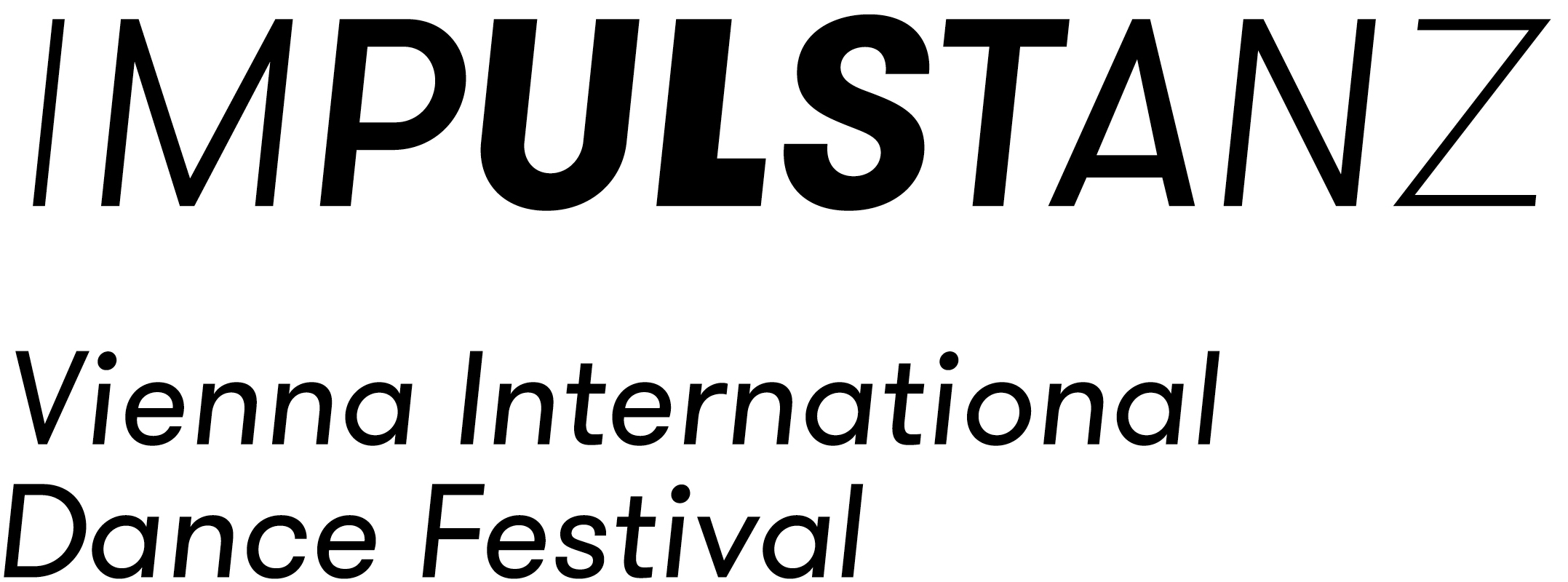


The 25th anniversary of DANS.KIAS fell in the middle of the first lockdown
Precisely on Friday 13 March 2020 - already in the final rehearsals - we had to abandon everything.
No anniversary piece 1 - 4 April 2020 at the WUK in Vienna
“through touches” - ! no way !
Nevertheless, the work never stopped:
- a two-hour documentary about the work with DANS.KIAS since 1995 is being produced.
- and two articles are published that honour the anniversary despite lock downs, one in the GIFT and one in the “Presse”
newspaper.
The filming of “through touches”, which was planned for the beginning of June, with all the protective measures (at that
time still very expensive PCR tests and quarantine) unfortunately failed in the end.
Two dancers changed their lives and were no longer part of the ensemble. I return to the stage and the quartet becomes a
trio.
After a summer with light at the end of the tunnel, darkness again: 2021 begins with another lockdown ‒ and again no
performances with an audience.
11-14 February 2021 at the WUK dancing and filming, despite everything.
- Curators, organisers and other illustrious guests are invited
- Ö1 and the APA are also guests
We were always allowed to work there and an internal audience with tests, masks and keeping an incredible distance was
also allowed to come. It felt really subversive, but was clearly not very sociable.
And then finally
8 and 10 August premiere in front of an audience as part of ImPulsTanz at the WUK.
Choreographer Hölbling uses lockdown for new projects
Lukas Wodicka, Salzburger Nachrichten, 15 February 2021The premiere of the contemporary dance piece “through touches” should have taken place in April last year to coincide with the 25th anniversary of Compagnie Dans.Kias. Now, instead of the piece, the coronavirus has cast a spotlight on the “primal human desire to come together”, choreographer Saskia Hölbling explains in an interview with APA. However, the founder of Dans.Kias has been able to use the involuntary postponement to develop new projects.
Three people meet in an otherwise empty space. Soon they have little choice but to approach, touch and explore each other, sometimes more cautiously and sometimes more vigorously. It doesn't seem to matter whether foot meets stomach, hand meets hand or face meets sole: the main thing is body to body. “through touches” thus addresses the “sensitive but strangely irrepressible power of touch”, as the announcement of the piece puts it - an exciting topic in times of a pandemic. But the idea already existed before the virus largely brought the cultural sector to a standstill. “It arose from the observation that in the world we live in, there is hardly any room left to engage with others, to touch them,” explained Hölbling, who is responsible for directing and choreographing the work and also has a dancing role in it.
Then came Corona and focused on the lack of coming together. “That's quite cynical that this issue is now at the centre of attention,” said the 49-year-old. However, the Viennese, is pleased that the current need for social distancing means that “people are realising again that the culture of coming together has been totally lost. Everything that makes people special has been cut off.” Of course, it would be nicer if a virus didn't first have to ensure that this focus is created, says Hölbling……..if it didn't need a virus to ensure if it hadn't been a virus to ensure
The Dans.Kias founder has already created over 40 works. However, she has never had to wait this long for a performance. “You can't keep up the tension for almost a year without running out of steam,” said Hölbling. She deliberately put the work away. Bringing it to a premiere prematurely via (live) stream was not an option for the choreographer: “If I simply film and stream "through touches", it misses the point.” Everything is faster online and the image consumption is different. “I'm putting on a performance so that people can come and get involved in a setting. They can zap through the world during the day anyway,” Hölbling explained her decision.
She focused on new things instead of tinkering with alternative performance possibilities. In addition to an ensemble piece that still revolves around the theme of “through touches”, a project called “Inhabit the impossible” is also planned. A total of 14 thinkers from various fields such as architecture, performance and film will explore future spaces over a longer period of time. Philosopher Arno Böhler is also contributing his perspective on the topic. “You shouldn't think of it as everyone sitting in their own little room and thinking about something. We also have repeated points of overlap,” explained Hölbling. Ultimately, the aim is to create a set of arrangements that bring together different, but also mixed perspectives.
Until then, the artist soon hopes to be able to perform “through touches” in front of an audience. “A piece always continues to develop on stage. We are already very starved from not having an interaction with the audience,” regretted Hölbling. And although the Dans.Kias founder is feeling the effects of the coronavirus “on all her nerves”, she is optimistic that touching people will not feel strange once she has survived abstinence: “This is an exceptional situation. It will disappear again.”
A DANS.KIAS production
Co-produced by WUK performing arts.
Supported by the cultural department of the City of Vienna, the Federal Chancellery of the Republic of Austria for Arts
and Culture, the cultural and science comission at Alsergrund.



The world has gone off the rails. A group of people are stranded somewhere between the oceans. In her new piece "da-nach"
[Afterwards], the choreographer Saskia Hölbling has her ensemble DANS.KIAS dance at the border between dystopia and
utopia.
A group of people find themselves somewhere on one of the world's oceans between flotsam and remnants of a bygone era.
It is unclear what has happened. It would also be irrelevant for the course of events. Now they are there, surrounded by
all sorts of things. Do they remember what they were doing before? Rather not. Or do they? From somewhere, suspicions
seep through.
In her current work, Saskia Hölbling draws a world on the border between dystopia and utopia. In "da-nach", Hölbling catapults her ensemble out of a world of abundance and permanent networking. Having arrived at this undefined place, it is now in their hands to reinvent themselves. Or not.
World Premiere: 1 March 2019, Atelierhaus der Akademie der bildenden Künste Wien, Vienna/AT, duration: approx. 60 min.
Choreography, staging: Saskia Hölbling; Dance, choreography: Anna Hein, Ardan Hussain, Jan Jakubal, Oskar Mitterer, Leonie Wahl; Music, composition: Wolfgang Mitterer; Assistence music: Moritz Cizek; Costume, stage:Gudrun Lenk-Wane; Lights: Reto Schubiger; Video-documentation: Peter A. Egger; Management: Simon Hajós
A Piece of Hope in the Apocalypse
Michaela Preiner, European Cultural News, 2 March 2019First of all: “da-nach” is a small but stunning production . . . and you shouldn't miss it, because an Austrian dance production like this, which is so harmonious, clever and coherent, provided with great choreography and brilliant sound, first has to be searched for first. . . . It is thanks to the creativity of Gudrun Lenk-Wane that the arte-povera props do not indicate a cheap production, but are used appropriately and repeatedly to cause amazement. . . . The great thing about this production is that it is a total work of art. And it's not one that flaunts this term on marketing banners. Stage, choreography and music, but also the dramaturgy of the story itself are convincing without any compromises. It is highly topical, but at the same time also of archaic force. In “da-nach”, compulsive humanity is soberly confronted with a second, completely different side, which usually doesn't occur at all in the current discourses on dystopia: namely, that of empathy, of joint action and willingness to help – which ultimately also contributes to the survival of the human species in this special context. It may well also be this redeeming prospect of an everywhere predicted bleak future that makes this piece of contemporary dance so extremely impressive. Chapeau, chapeau and: thanks for that! (Michaela Preiner, European Cultural News)
Life in the Flotsam
Oliver Lang, Kronenzeitung, 3 March 2019Somewhere in nowhere, forgotten and alone, lost – and yet not lost: these are the figures in Saskia Hölbling's one-hour dance piece “da-nach”. . . . Wolfgang Mitterer, one of the most interesting Austrian composers, has written the musical backdrop that seems so dangerous, oppressive, exciting, but also always somehow familiar. . . . Hölbling develops a set of figures who gropingly explore the new environment. . . . What succeeds in barely an hour is a skilfully made study of the human: together the excellent dancers create a dark but not hopeless atmosphere of forlornness. And create a unity in Hölbling's design that captivates!
A DANS.KIAS production. Supported by the cultural department of the City of Vienna, the Federal Chancellery of the Republic of Austria for Arts and Culture and ImPulsTanz - Vienna International Dance Festival. In co-operation with the Academy of Fine Arts Vienna.



In her choreography, Saskia Hölbling focuses on all the objects that often otherwise go unnoticed. In her current work
she literally lets things dance out of line.
Hölbling takes the constantly increasing accumulation of objects as an opportunity to create a dispositif in which she
embraces all this luxuriance and abundance.
The dancers Anna Hein, Leonie Wahl, Ardan Hussain and Jan Jakubal invite the objects to dance. In motion, the objects find their own life, are mounted on the bodies, draped around them, they become landscapes or locations, sculptures or outfits. An inspiring interplay that constantly gives rise to new situations. The things take shape, are reinvented. The boundaries between human and object dissolve. It comes to touching encounters, fantastic sculptures are formed, new worlds arise, an unceasing process of emergence and decay that in all its multitudes keeps us under its spell.
World Premiere: 1 March 2018, Atelierhaus der Akademie der bildenden Künste Wien, Vienna/AT, duration: approx. 80 min
Choreography, staging: Saskia Hölbling; Dance, choreography: Ardan Hussain, Jan Jakubal, Leonie Wahl, Anna Hein; Music, composition: Wolfgang Mitterer; Assistence music: Moritz Cizek; Costume, stage: Gudrun Lenk-Wane; Lights: Reto Schubiger; Video-documentation: Peter A. Egger; Management: Simon Hajós
The Private Life of Thing
Karl Heinz Roschitz, Kronenzeitung, 07.03.2018It is ordinary everyday objects that this time become the main actors in the performance: “things”, the choreographer Saskia Hölbling's new evening show in the Semperdepot, focuses on everything inconspicuous, from parasols to tyres. An eighty-minute spectacle with celebrated attentiveness. The buzzing fan blows over a devastated garbage landscape. What's all that lying around there! But everything can become an actor, even take a lead role. Even more: every thing has what it takes to become a fetish, an object of struggle and an icon. In the course of the evening little is actually used in the way described in the operating instructions. But everything is allowed to participate in a flow of transformations. What emerges are strange images: it is less about the individual meaning than about the overall effect.
And the dancers? They too sometimes seem like the things that they are pushing, working on and looking after: they are not so much actors with their own personalities as interchangeable players who occasionally even become objects that are presented and dressed. The Austrian composer Wolfgang Mitterer has underpinned all this with fragmentary music. Quotations from well-known works by Stravinsky to Tchaikovsky fly around one's ears and then decay into small particles again. Finally: hearty applause!
Triumph of the Birds of Paradise in their Parallel World
Helmut Ploebst, Der Standard, 02 march 2018Messies are very inspiring people. In their flats, houses or gardens they collect things that seem like worthless junk to other people. A precarious passion that can turn into real suffering. With her new work “things” in the Semperdepot of the Academy of Fine Arts, the Viennese choreographer Saskia Hölbling is currently showing that it doesn't have to be like that. The stuff piled up on a dance floor forms an artistically arranged chaos. Hölbling and her four dancers, Ardan Hussain, Leonie Wahl, Jan Jakubal and Anna Hein, make no secret of the fact that they dominate this landscape of plastic tarpaulins, tubes, helmets, containers, suitcases, sacks etc.. Real messies, on the other hand, allow themselves to be overwhelmed by their hellish proliferations of chaos and order. That is what makes them tragic heroes. Memories of “Citizen Kane” Citizen Kane, as it turns out in Orson Welles' 1941 film, became the messie in search of the symbol of his lost childhood happiness – a Rosebud-make sledge. A similar wooden sledge can also be found among Hölbling's things. That may be an allusion to “Citizen Kane”. Especially since the beautiful opening scene of the work is bathed in a light that transforms the stage into an almost perfect black-and-white image and with Wolfgang Mitterer's composition, which begins with this image, is reminiscent of film music. But what happens then, leads far away from this seductive association, which perhaps is only due to vortex formation in the viewer's memory-banks. It leads, for example, to Ann Liv Young's eerie black-and-white in her “Elektra” at the 2014 Steirischer Herbst. And further to Alain Platel's “Tauberbach” at the ImPulsTanz festival in the same year: there the dancers also moved in a heap of waste materials. Excessive accumulations of things as in Isabelle Schad's “California Roll” (Tanzquartier 2005) have been a recurring motif in the choreography of the past two decades. Human vs the Maelstrom of Things Vera Mantero's work “Poetry and Savagery”, which was also shown to the Viennese by Dietheater Künstlerhaus in 1999, was a very lovely experience . Because there, too, the dancers – as now in Hölbling's “things” – began to drape the stuff surrounding them over their bodies and in the fantastic costumes thus created began to strut around like birds of paradise from a parallel world. Here as there, poetry enables the triumph of humans over the maelstrom of things buzzing around them. The poetic play can prevent them from being drawn by this vortex into the hades of depression.
A DANS.KIAS production,
supported by the cultural department of the City of Vienna and the Federal Chancellery of the Republic of Austria for
Arts and Culture.



In "Corps suspendus" Saskia Hölbling stretches, exposes, combines, gathers, hinders or networks four dancers through a
mesh of ropes.
Looking into the world is urgent; it leaves behind an unquiet, almost worrying impression: the many people who are on
the move there, the many people in the quicksand between success and superfluousness, the many Trumps, the non-faces,
the many ideologically raw, the many egos between consumer oases and rubbish dumps.
These many people are always others. Far enough away in order to speak of the other but close enough to feel “threatened”. With Corpus suspendus Hölbling produces a little world machine in which the bodies mutually surrender themselves. A “new” body emerges that develops in relationship to and dependence on one another.
World premiere: 3 March 2017, Atelierhaus der Akademie der bildenden Künste Wien, Wien/AT, duration: approx. 60 min.
Choreography, staging: Saskia Hölbling; Dance, choreography: Ardan Hussain, Jan Jakubal, Leonie Wahl, Anna Hein; Music, composition: Wolfgang Mitterer; Assistence music: Moritz Cizek; Costume, stage: Gudrun Lenk-Wane; Lights: Gerald Pappenberger; Video-documentation: Peter A. Egger; Management: Simon Hajós
The Solution-Oriented Network Machine
Helmut Ploebst, Der Standard, 07 march 2017Impressive premières by Saskia Hölbling in the Semper Depot It's a trap. Two men and two women become entangled in a a big net made of black threads, which a hidden arachnid has stretched across a wide, uncanny space. The Viennese choreographer Saskia Hölbling had this installation set up by Gudrun Lenk-Wane for her new work, Corpus suspendus, in one of the halls of the former Semper Depot. The première was organised by ImPulsTanz, the background web of sounds comes from Wolfgang Mitterer. The hidden female spider is the key to this work, which alludes to the atrophy of the great networking enthusiasm of the last two and a half decades: as Hölbling writes on this work, it alludes to the “many egos between consumer oases and rubbish dumps” and to “the many in the quicksand between success and superfluity”. So it is to be assumed that the absent arachnid here stands for the what is secretly pulling the strings in our globalised network business and profiting from it. In the form of the four “corps suspendus”, the superfluous ones float in the nets of the profiteers. The French word suspendre means to hang up or to hang, but also to interrupt, postpone or freeze. The figures in Hölbling's web are clearly just attached, without yet being aware that they have been dumped. They hang in their dangerous habitat, sometimes forcing themselves together, but quickly losing one another again, landing on the floor without really noticing it. They cannot leave the net, because it is a fetish that numbs its inhabitants. Hölbling calls it “a little world machine”. Those suspended in it wear the black of this machine, which never allows them to gain their balance, that permits neither stopping nor calm and which suggests there is no outside.
In the world machine
Karl-Heinz Roschitz, Kronen Zeitung, 05 march 2017With amazing ease and elegance, the four performers twist and tumble, crawl, clamber and lift themselves through the network. And literary references can be recognised in the process – involuntarily one recalls the Norns in Wagner's Götterdämmerung, who pull on the threads of fate and spin networks. However, Hölbling does not conjure up the Wagnerian catastrophe, the tearing of the rope that heralds the end of the world. (…)
Wolfgang Mitterer, the prominent organist, electronic musician and composer, wrote the backing music: a rollercoaster of refined sounds, colours, instrumental tones and noises, an artistically designed, in itself reference-rich sound network for Hölbling's staging and choreography. Much applause.
A DANS.KIAS production. Supported by the cultural department of the City of Vienna and the Federal Chancellery of the Republic of Austria for Arts and Culture. In co-operation with ImPulsTanz - Vienna International Dance Festival and the Academy of Fine Arts Vienna.




Saskia Hölbling interweaves the ideas of the French philosopher Jean-Luc Nancy into “corps à corps” and with her
contemporary dance performance deals with red-hot issues of world events in an abstract and intensive form.
"Our billions of images show billions of bodies – as bodies have never been shown before. Crowds, piles, melees,
bundles, columns, troops, swarms, armies, bands, stampedes, panics, tiers, processions, collisions, massacres, mass
graves, communions, dispersions, a sur-plus always an overflowing of bodies, all at one and the same time, compacted in
masses and pulverizing dispersals, ... abandoned to the structuring agitation of their endless, generalized, departure
...“
Jean-Luc Nancy
World premiere: 25 February 2016 // Odeon / Vienna/Austria / duration: approx. 80 min.
Choreography, staging: Saskia Hölbling; Dance, choreography: Adriana Cubides, Ardan Hussain, Jan Jakubal, Leonie Wahl; Dramaturgy: Florian Tröbinger; Music, composition: Wolfgang Mitterer; Assistance music: Moritz Cizek Puppets, scenography and costume: Gudrun Lenk-Wane; Lights: Gerald Pappenberger; Video-documentation: Peter A. Egger; Management: Simon Hajós
Life as a sculpture
Karlheinz Roschitz, Kronen Zeitung, 28 february 2016Kronen Zeitung, 28 february 2016 With circling movements four dancers conquer the stage. The scenes condense. Human bodies and emaciated marionettes tangle with one another, become knotted, human rubbish heaps, a vibrating sculpture: In the Odeon, Saskia Hölbling is showing her new work "corps à corps". Soon the four – Adriana Cubides, Adrian Hussain, Jan Jakubal and Leonie Wahl – and their headless puppets hang as if dead in the walk-in steel structures, soon they climb on and between the steel tubes, tussle or knot themselves into a heap. Like the undead they emerge to us from the darkness, manipulating their doubles. And Wolfgang Mitterer's exciting compositional work, full of refined structures, sound colours and noises, condenses the images. Sometimes as if in a horror film. A scenery of haunting figures in a world inhaling death. Breathing mountains of the dead! Full of dark moments with the foreboding of horror. But one can also only regard this dance in the light of Saskia Hölbling's choreographic concept: as plays of movement that see their tensions from condensation and dissolving, from the counterpoles of human and non-human and the mutual influence. Exciting!
Dead puppets always keep cool
Helmut Ploebst, Der Standard, 28 february 2016Hölbling has drawn on two of her earlier works, "assemblage humain", a solo with a puppet, which was shown at ImPulsTanz last year, and "body in a metal structure", created with the French artist Laurent Goldring in 2012. In "corps à corps" one white puppet has turned into four and the metal structure has become two scaffolds. On the stage, two women – excellent: Adrian Cubides – and two men confront two life-size limb figures.
The dance is an antipode to posthumanism; Saskia Hölbling builds on this too. In "corps à corps" the lamentation corresponding to the zeitgeist is far from the vulnerable and mortal bodies. (…) In its second half the work becomes increasingly aimless. Possibly this is intentional. Because it may also be that the choreographer wishes to reflect the aimlessness and helplessness of human bodies in the face of themselves and their organisation. If this is correct, then "corps à corps" would be a successful statement that just does not present this confusion radically enough. The dance ends in giving up in the face of insoluble problems. The music, which is convincing to the last second, comes from Wolfgang Mitterer, the puppets from Gudrun Lenk-Wane, and Gerald Pappenberger is responsible for the composed lighting that follows the rhythm of imminently threatening to go out.
A DANS.KIAS production. With financial support from the Cultural Department of Vienna and the Austrian Federal Chancellery for Arts and Culture



For the 20th anniversary of DANS.KIAS, all “squatting projects” will be shown in one place for the first time – in the
Expedithalle of the Ankerbrotfabrik
With the “Squatting Projects”, a series of dance performances in public spaces started (indoors and outdoors) that can
take place in theatres, museums, airports or railway stations just as much as in public squares or areas.
The aim is to enrich the urban environment with subversive body images or potential body visions by connecting up with a
performance unit.
The start of the “squatting projects” series is the work “body in a metal structure”; followed by „bodies (with)in
fences" and “bodies in tubes”
The “Squatting Project” idea – a nomadic guerrilla stage
The idea of a stage in its contemporary dimension is to be extrapolated into public space, that is, implanted in urban
reality, through a mobile performance unit.
An informal performance appointment that establishes itself parasitically in places where it is actually out of place,
or where it occupies an existing structure and sponges off its infrastructure.
Constructed, housed, accompanied by performers whose actions repeatedly put the body and environment into new relations,
set in motion and thereby initiate very discreet acts of civil disobedience.
Put differently:
A hybrid that mediates between the environment, society and culture.
A temporarily implanted performative artefact that is designed to disturb rigid patterns of thought and supposed
harmonies, or to call ostensibly coherent structures into question.
A new form of art occupation in over-organised conurbations
A changing cult, cultural and accommodation site.
Premiere: 18 - 20 June 2015, Expedithalle / Loftcity, Wien/AT
duration: approx. 80 min.
body in a metal structure
Choreography, staging: Saskia Hölbling and Laurent Goldring; Dance, performance: Saskia Hölbling; Sculpture, performance-scaffold: Gudrun Lenk-Wane; Music, sound: Nik Hummer; Lights: Reto Schubiger; Video-documentation: Peter A. Egger; Production, management: Simon Hajós
bodies (with)in fences
Choreography, staging: Saskia Hölbling and Laurent Goldring; Dance, performance, choreography: Saskia Hölbling, Rotraud Kern, Franco Senica; Space: Laurent Goldring, Gudrun Lenk-Wane; Music, sound: Nik Hummer; Lights: Reto Schubiger; Video-documentation: Peter A. Egger; Production, management: Simon Hajós
bodies in tubes
Choreography, staging: Saskia Hölbling and Laurent Goldring; Dance, performance, choreography: Saskia Hölbling, Rotraud Kern; Space: Laurent Goldring, Gudrun Lenk-Wane; Costume:Gudrun Lenk-Wane; Music, sound: Nik Hummer, Michael Moser; Lights: Reto Schubiger; Video-documentation: Peter A. Egger; Production, management: Simon Hajós
Saskia Hölbling - 20 Years of DANS.KIAS
Ditta Rudle, tanz.at, 15 June 2015In 1995, Saskia Hölbling presented her first choreography and founded her ensemble DANS.KIAS. At the time, the dancer and choreographer was 24 years old. Since then, she has choreographed and staged more than 30 pieces. Reason enough to celebrate the anniversary. DANS.KIAS is doing just that in the former Anker bakery with the three-part Squatting Project. The huge despatch hall sheds new light on the bodies in the installations and allows new perspectives.
Saskia Hölbling has fulfilled a dream: to show "body in a metal structure", "bodies (with)in fences" and "bodies in tubes" in one evening. As far as the installations made of rough building materials are concerned (in addition to the metal structure, an installation by Gudrun Lenk-Wane, also an almost endless series of wire fences and plastic buckets, bottomlessly connected by chains to form a climbing tower), it works perfectly. Even before the performance begins (and afterwards too) you can walk round it, examine it and get to know it. To ensure that neither the hard-working performers (Saskia Hölbling, Rotraud Kern, Franco Senica) nor the audience are overtaxed, the three parts are reduced to just over an hour.
Hölbling starts by putting the cart before the horse, starting in the tubes where she and Kern offer a spectacle of deception and camouflage. Only a mop of hair sticks out of the tub, then four legs and two arms - breech birth, head birth, limb birth. Arms and legs shimmer white in the spotlight, the black buckets on the chains are unstable, swinging and swaying, allowing the two women to swing unexpectedly towards each other, their faces close, ready to kiss. Senica, like the other dancers later on, is already fighting with the fences in leather, boots and gloves. Soon there are three of them, working their way through the clanking and clattering path. Heads emerge, buttocks, arms, legs, now black. When the clattering calms down, the fighters rest for a few seconds, their breathing is the music. But the music, composed, conceived and performed live by sound artist Nik Hummer, becomes louder and louder, more menacing. Now the fight is no longer against the wire frames but for life.
In the end, Hölbling remains alone in her metal structure, which consists of cabled tubes that seem to moan and cry through a sophisticated sound installation by Hummer, as if it is not at all happy with being taken over by a human body. But just as the pliable body befriends the bulky matter, it also accepts the conqueror. In the end, it almost purrs. The dancer also knows how to seduce, has thrown off her black robe and swings upside down in charming lace underwear.
Never-ending applause. An anniversary and also “expositions corps”. Saskia Hölbling has remained true to herself, even if she has left the floor out of a desire for something new.
A DANS.KIAS production. With financial support from the Cultural Department of Vienna and the Austrian Federal Chancellery for Arts and Culture.


In her current work "assemblage humain" the choreographer Saskia Hölbling shows collages of the human that are not put
together fragmentarily but arranged fluidly and give time for contact spaces. Contemporarily cool, but without fear of
expressiveness. This is how two worlds are juxtaposed.
The first, dystopian, existential. In an archaic environment of felt, wood, leather and linen, performer and a life-size
human figure meet one another and together use the objects – a blanket, seat, broom, stick and jacket – to create
assemblages of elementary human relationships: on this world and the beyond, life and death, war and mourning, love and
gentleness, ecstasy, daily rituals and absurdities – a Guernica where the horse and the bull, where death and the maiden
repeatedly have something to do with one another.
There is a break in the work, the second world covers the remains of the first. Likewise dystopian but more exposed,
garish. An act of evisceration opens up, coloured plastic and objects appear, a pile of trash. The assemblages here are
more artificial, flashier, trendier:
Arising out of the plastic skins, a parade of the objects begins and rises into an orgiastic dance of the materials that
finally make the bodies disappear.
Showing: 13 February 2015, Proberaum Neue Oper Wien, Wien/AT
Premiere: 20 May 2015, Musica_Electronica_Nova/National Forum Of Music, Breslau/PL
duration: approx. 50 min.
Choreography, dance: Saskia Hölbling; Assistence choreography: Rotraud Kern; Music: Wolfgang Mitterer; Assistence music: Moritz Cizek; Scenography, stage: Gudrun Lenk-Wane; Light: Gerald Pappenberger; Video-documentation: Peter A. Egger; Management: Simon Hajós
Puppets and Shamans
Silvia Kargl, Kurier, 25 July 2015Saskia Hölbling presented her piece “assemblage humain” for the first time in Austria as part of ImPulsTanz at the Schauspielhaus. A work in which Hölbling departs from her recent paths of Minimal Movement. The music by Wolfgang Mitterer also contributes to the fact that this “relative solo” with two puppets moves away from Hölbling's abstract and formal choreographies.
Gudrun Lenk-Wane has designed two different life-size puppets that turn the solo into a trio. The first puppet is reminiscent of a skeleton. Hölbling explores it closely. It is associated with tightly gripped fears, and it could also be the memory of a dead person who is present as a silent partner and spectator.
The second puppet wears a black suit and is clearly more “muscular”. The relationship with the dancer becomes both more human and more sexualised when Hölbling goes into a frenzy of movement with the dolls' colourful foil entrails.
A DANS.KIAS production. With financial support from the Cultural Department of Vienna.


In “bodies in tubes” an installation made of rubble chutes becomes the setting for the current work by Saskia Hölbling
and Laurent Goldring. After “body in a metal structure” and “bodies (with)in fences”, “bodies in tubes” forms the third
part of the "Squatting Projects".
As if drying, a vertical chute system hangs in the belly of a room, a dissected section of the pulsing arteries of our
city, which in endless connections drive invisible cavities in our floor.
In this organic exposé, two bodies comb through the inflow and outflow guidance systems, the proliferation of entries
and exits, the many diversions and turnings: they come up against dead-ends, against one another, wedge themselves in
niches and stream out of gaps, are absorbed or thrown out.
The boundaries are different here. Anxiety and protection go hand in hand, inside and outside become blurred,
organisation and artifice form a new organism. Here plastic can breathe, the human body becomes an aspect, a segment of
a suprabody. It becomes part of a territory that belongs to nobody.
What is visible are the effects and echoes of the movements.
Premiere: 10 October 2014, TQW - Tanzquartier Wien, Wien/AT
duration: approx. 50 min.
Choreography, staging: Saskia Hölbling, Laurent Goldring; Dance, performance, choreography: Saskia Hölbling, Rotraud Kern; Space: Laurent Goldring, Gudrun Lenk-Wane; Costume: Gudrun Lenk-Wane; Music, sound: Nik Hummer, Michael Moser; Light: Gerald Pappenberger; Video-documentation: Peter A. Egger; Management: Simon Hajós
The crimes of efficiency and victory
Helmut Ploebst, Der Standard, 13 October 2012Two bodies attempt to stay inside rubble chutes that are closely linked to one another. As in their two previous works, "body in a metal structure" and "bodies (with)in fences", Hölbling here allows the uncanny to run its apparently abstract course. Again a framework from which the body cannot find its way out. But here the claustrophobia of our existence is most radically revealed: as bodies that are now only the debris of the systems that govern them
Moving installation: Saskia Hölbling in the Tanzquartier
Silvia Kargl, Kurier, 12 October 2014"bodies in tubes", the new work by Saskia Hölbling in the Tanzquartier, is at the same time the completion of the “Squatting Projects” series, which was produced in collaboration with Laurent Goldring.
The projects address the relationship between bodies and urban space. This time there is an installation with rubble chutes by Goldring and Gudrun Lenk-Wane on the stage. In the half darkness the choreography is only vaguely discernable. Hölbling and Rotraud Kern fill the moveable tubes, and disappear into them as if seeking protection. Body parts protrude until the performers have explored every joint of the installation. There is a growing impression of a space that covers their bodies like a straitjacket.
A DANS.KIAS production. Co-produced by Tanzquartier Wien and the Centre Chorégraphique National de Franche-Comté à Belfort, supported by the Saline royale d"Arc-et-Senans in the frame the Odyssée residency program. Subsisdied by the Cultural Deparment of the City of Vienna and the Austrian Federal Ministry for Education, Arts and Culture.





In "bodies (with)in fences" Saskia Hölbling and Laurent Goldring go in search of new anchors and territories, without
wishing to compete with the shrill seduction strategies of urban space in their crudeness. The sphere of action lies
outside of any glamour and luxury and far removed from any comfort zone.
Quite in its function as a multiple barrier, a monument made of construction gratings opens up spaces and volumes of
exclusion or of display. It outlines its own control systems or puts up walls.
In the middle of the monumental sculpture, which raises almost insuperable barriers, three bodies repeatedly and
continually go about dissecting their rigid surroundings, ploughing through the many-layered barriers and thereby
keeping the system in suspense.
In "bodies (with)in fences" Saskia Hölbling and Laurent Goldring have created a delicate but noisy work, which through an
inescapable loop designs a perpetuum mobile that necessarily leads to a dead end.
After "body in a metal structure", with "bodies (with)in fences" the "Squatting Projects" go into a second round.
PERFORMANCES
bodies (with)in fences 07 - 10 March 2024, 20h / as part of „Living Positions" at Odeon Theater Wien
Premiere: 23 January 2013, WUK, Projektraum, Wien/AT
duration: approx. 50 min.
Choreography, staging: Saskia Hölbling, Laurent Goldring; Dance, performance, choreography: Saskia Hölbling, Rotraud Kern, Franco Senica; Space: Laurent Goldring, Gudrun Lenk-Wane; Costume: Gudrun Lenk-Wane; Music, sound: Nik Hummer; Light: Reto Schubiger; Video-documentation: Peter A. Egger; Management: Simon Hajós
Brillant: The dance work "bodies (with)in fences" by Saskia Hölbling and Laurent Goldring
Helmut Ploebst, Der Standard, 25 January 2013Our society is a permanent building site. One that is permeated with fences and secured by bars. With their oppressive dance work "bodies (with)in fences" in the Vienna Wuk, the Austrian choreographer Saskia Hölbling and the French artist and philosopher show exactly what this policy of blocking feels like.
The setting is reduced to the bare essentials. Some 40 fence fields, erected closely behind one another, form the stage installation. Two women, Rotraud Kern und Hölbling, and one man, Franco Senica, are banished onto and into these. There is obviously no escape.
It soon becomes clear to the audience that this installation connects three parallel worlds. Because the choreography in it is certainly intended to be read as a statement on social policy, but also functions as an existentialist metaphor in the sense of Jean-Paul Sartre's closed doors. There, too, two women and a man fall into the hell of being locked in. At a third level, "bodies (with)in fences" brings the fencing of the human soul into play.
First the three figures attempt to stay on the upper surface of the fence field, but then penetrate into the narrow spaces in between. Nik Hummer's sober sound-spheres are chopped up by the rattling of the fences. The changing levels of light show that regardless of the perspective taken, the inescapability remains.
Without mountain and rock, a triple Sisyphus moves only himself – and that in one place. For him, Albert Camus' sentence, “one must imagine Sisyphus happy,” does not apply. A radical position. This work positions itself consistently outside the “matrix” – i.e. the fence – of entertainment and political spectacle, whose fences run through the psychic and existence conditions of all who climb through life within it.
After "body in a metal structure", "bodies (with)in fences" is the second cooperation between Saskia Hölbling and Laurent Goldring. The first piece has already been a success. The new one has now scored a bull's-eye.
DANS.KIAS - bodies (with)in fences
Ditta Rudle, tanz.at, 26. Jänner 2013In an installation made out of construction-site railings, three bodies explore the possibilities of movement, overcome barriers and end up where they started from. Saskia Hölbling and Laurent Goldring have also conceived the second part of their “Squatting Project” for public space, in order to enrich the urban environment. The première took place in the project space of the WUK.
Sisyphus today. The metal railings are fragile; they may be firmly fixed to the ground but they sway and shake when Saskia Hölbling, Rotraud Kern and Franco Senica move on and between them. The whole performance develops in the same way as the bodies begin their (futile) parcours up on the narrow railings of the fence. As a balancing act. Three times Sisyphus struggles up the ridge, without a way out and without an aim. What the three performers are putting their efforts into looks dangerous and thoroughly strenuous – a struggle with railings that have been lined up so close to one another by the artist Gudrun Lenk-Wane that there are no paths through which one might escape. The three hardly ever touch the ground, but they hang upside down in the railings, twist over and under them, meet and hinder one another, look like a six-legged animal, which the spectators on the other side of the installation probably see as three-headed. Occasionally the image of a love story flashes up, two women, one man. But it soon disintegrates again; each of them fights for themselves alone. The victor remains the cold but at the same time flexible image of the railings. When these fences are scaled and climbed they clang and clatter and supplement the rising and falling sound collage by Nik Hummer, depending on the energy flow of the performers. Reto Schubiger participates in the events with differentiated lighting. Are the bodies moving to the beat of light and sound or are they giving the rhythm for music and sound, light and dark with the vibrating rattling of the metal structure? The perfect interplay of this cleverly thought-out concept leaves the question unanswered.
An exciting performance in its difficulty and physical commitment, which would be even more intensely experienced in open space (indoors or outdoors). In the small project room of the WUK the audience is seated on two sides of the installation and as it were sees only half of the moving body images. Moving around to repeatedly change the perspective would be more advantageous. The next performances of this impressive project have not yet been fixed, but (like body in a metal structure, the first part of the “Squatting Project” by Hölbling/Goldring), "bodies (with)in fences" will certainly be seen in several places, with or without a roof over it.
A DANS.KIAS production. In co-operation with the Werkstätten- und Kulturhaus WUK. Supported by the cultural department of the City of Vienna and the Federal Ministry for education, arts and culture.



"body in a metal structure" forms the start of the “Squatting Projects”, a series of dance-performance appointments that
settle parasitically in places where they are actually out of place by occupying existing structures and scrounging off
their infrastructures: an inconspicuous, unused building scaffold, simultaneously a mobile sculpture and performance
venue, fits in to the proliferation of building sites, which owing to their omnipresence are already fading from our
field of perception.
At the centre of this sculpture, which always seems a little out of place, a body then sets out to deconstruct
relationships with its urban surroundings, engaging in with quite discreet acts of civil disobedience.
In a world of highways, grey facades and building sites that, accelerated into wasteland, merge completely into
advertising space, massively displayed and celebrated in lights to transform global needs into continuous consumption, a
body occupies these axes of directed flow.
Makes steel pipes and sharp edges, protruding shafts of screws and bursting metal joints its own, assembles them into
its home, creates its own architecture of desire and develops its own delirium between skin and metal.
With "body in a metal structure" Saskia Hölbling and Laurent Goldring create a delicate and quiet organic manifesto in
the midst of functioning structures, a new form of art occupation in overly organised conurbations.
Pre-premiere: 18 January 2012, WUK, Projektraum, Wien/AT
Premiere: 03. May 2012, donaufestival, Stadtpark Krems, Krems/AT
Duration: approx. 60 min.
Choreography, staging: Saskia Hölbling, Laurent Goldring; Dance, performance: Saskia Hölbling; Sculpture, performance-scaffold: Gudrun Lenk-Wane; Music, sound: Nik Hummer; Light: Reto Schubiger; Production, management: Simon Hajós
From Heaven above to Heidegger
Helmut Ploebst, Der Standard, 21 January 2012It only really starts properly at the beginning of May at this year's Krems Danube Festival. But in the WUK the pre-première has already taken place: the Viennese choreographer Saskia Hölbling presented “body in a metal structure” in the project room of the cultural centre.
A woman in black trousers and a black shirt – Hölbling herself – places herself, head pointing downwards, in a four-metre-high scaffold of metal poles, as used on building-site scaffolding. The planned unstable construction (by Gudrun Lenk-Wane) consists of a pyramid within a cube. Inside, the dancer moves for an hour, climbs up, lets herself down to the floor again, hangs from the supports and shakes them. The scaffold can indeed stand this, but above all its outer parts shake dangerously. The symbolic value of it all is considerable. The philosopher Martin Heidegger was impressed with the idea of the “Ge-stell” (frame). For him it was what “challenges people to bring to light the real as something created.” The reference to Heidegger is no speculation. Because Hölbling created her work together with the French artist Laurent Goldring. And he is well known as a philosophy aficionado.
So the metal structure in the work corresponds precisely to the “bars and debris and scaffolding” that for Heidegger “belong to the technological”. But one does not have to have done a philosophy degree to understand what the dancer – by the way, dispensing with virtuoso dance “techniques” – is doing in the scaffold. Hölbling explores this upright male structure and challenges it: burdens, disturbs and penetrates it. During the course of this she changes her trousers for a skirt, puts a jacket on over her shirt.
At the end, she persists headfirst again – although undressed down to a bra and briefs. Thus she also presents the scaffold as an exaggeration of the kind of pole around which pole dancers writhe. And pole-dancing is very popular at the moment, precisely outside dubious establishments as amusement for everywoman. It is considered sexy and consciousness-raising at the same time. Hölbling seems to have smelt a rat. Single-mindedly she deconstructs the pole and transfers the result into the artistic. “body in a metal structure” is now to be performed in the open air, in those places the scaffold represents an alien body.
For Hölbling this work is the first statement in a whole series of future “squattings” of public places. A start has been made – and very successfully.
Vertical in steel space
Oliver Lang, Kronen Zeitung, 29 July 2012In public space – on the bastion of the Albertina – a strange construction of metal rods in which a person clothed in black hangs upside down. It is the choreographer and performer Saskia Hölbling, giving her evening performance "body in a metal structure" at the ImPulsTanz-Festival.
Saskia Hölbling's evening (developed together with Laurent Goldring) may provide apparently dangerous moments of climbing, but no circus-like art: it is not about the show, but about the conquest and experience of the scaffold. What do you see? Saskia Hölbling coils and swings through the large metal scaffold, sometimes reptilian, then offensive again. The object is explored in changing clothing; sometimes she hangs upside-down on the poles, then she leaps, climbs, lets herself fall, reaches the ground. Repeatedly in between there is the scrutinising look at the scaffold, a measurement of power, an estimation of the opponent. And slowly the tubular structure yields, turns from an object that looks like something from a construction site into a sculpture that has been deconstructed by Hölbling. It is exciting to observe what takes place between the dangerously swaying individual components and the fixed inner construction, and how the conquest of this meters-high object is designed.
A DANS.KIAS production co-produced by the donaufestival, in co-operation with the Werkstätten- und Kulturhaus WUK, subsisdied by the Cultural Deparment of the City of Vienna and the Austrian Federal Ministry for Education, Arts and Culture.




Five dancers packed into all-over lycra suits. With each physical gesture they sketch out an independent pictogram, in which signs, roles and classifications change in the blink of an eye – between masculinity and femininity, between individuality and the collective, between fiction and reality. They test and play with the comprehensibility of the hermetics of codes, and their movements thematise the relationship between representation and communication, habitus and body language.
With "pictographic events" Saskia Hölbling continues her artistic research into graphic, organic and acoustic signs and in the process has created a choreographic work that speaks out against the “globalisation of signs” and for the greatest possible diversity and uniqueness of understanding.
Premiere: 17 + 18 December 2010, Tanzquartier Wien, Halle G, Wien/AT Duration: approx. 60 min.
Concept, choreography: Saskia Hölbling; Music: Heinz Ditsch; Video: Doron Goldfarb; Lights: Reto Schubiger; Costume: Gudrun Lenk-Wane; Dance, choreography: Rotraud Kern, Heide Kinzelhofer, Alexandra Mlineritsch, Moravia Naranjo, Charlotta Ruth; Production, management: Simon Hajós
When the pictograms learned to walk
Bettina Hagen, Falter, 15 December 2010If one wishes to understand Saskia Hölbling's new work, “pictographic events”, one has to briefly call to mind the meaning of pictograms in the present-day, globalised world. These signs or image systems, which – for example in airports – send people who have no shared language or common cultural background in the same direction, are something like the lowest common denominator of information or instructions for action. In contrast, the work draws its tension from using the signs in their broadest possible meaning.
Hölbling's concern with the pictogram family has nothing to do with poses and a one-dimensional transposition of signs. However, the analysis of the image symbols leads to a completely individual body stance. Neutralising elements are the black and white all-over lycra body suits in which her five dancers envelop themselves.
While pictograms are intended only to be understood in one way, the dance goes beyond this initial meaning. Shifts of context produce surprising turns that also permit a great deal of humour in this work. The dancers, dressed in black and white and sometimes also in red, take everyday gestures and test them for their economy. The movement material is as varied as it is familiar: here someone is peeing against a wall, the outline marks the position of a corpse, aerobics is presented. But the mode of portrayal is constantly changing: in duos and trios, the technique can be dance, comic or filmic.
Alongside the reduced colour pallet in the costumes, the stage set is also oriented on the aesthetics of pictograms. Spatial distances and three-dimensional objects are often indicated only by a line. Two white bars on the black dance floor define the spatial depth. In their genres too, the music by Heinz Ditsch and the videos by Doron Goldfarb develop something like a pictographic language. With her company DANS.KIAS, Saskia Hölbling is among the established greats of the domestic scene.
Computerlanguage in dance
Silvia Kargl, Kurier, 19 December 2010If Hölbling's last works revolved primarily around the female body, then they now employ graphic, universally used signs and symbols. Enveloped in white, black and red full-body leotards with masks, five dancers appear like pixels. Not only the choreographic form seems to have changed, but also the content and the approach to time. If Hölbling previously celebrated slowness, now she banks on a rapid succession of scenes with many, often stereotypical repetitions. After rapid steps, the performers repeatedly freeze in poses, sculptures and movements from contemporary dance as well as ballet. Themes such as misunderstandings in communication, power games, clichés of women's and men's roles are sketched out, but not taken further, and repeatedly over-painted with new ideas.
On to the anarchy of signs
Verena Franke, Wiener Zeitung, 21 December 2010In “pictographic events” Saskia Hölbling scrutinises the power of pictograms that determine everyday life today. To do this, the Austrian choreographer sticks five dancers from her ensemble in full-body suits. From head to toe, just like pictograms. This time with Hölbling the focus of the philosophical concept is less on the body as such than the analysis and above all the sensitisation with regard to the omnipresent global language of signs. Hölbling attempts to add a complex level to the simple, linear symbolism. In the abstract the choreographer shows the consequence of the independent pictographic existence when, for example, a woman's scream suggests a car crash and its results.
A DANS.KIAS production. Co-produced by Tanzquartier Wien.
Supported by the Cultural Department of the City of Vienna and the Federal Ministry for Education and Culture.



After the successful production of A-Ronne (2002), the Austrian choreographer Saskia Hölbling, again in collaboration with the Wiener Taschenoper, is staging a concert performance of Naturale, Visage and Sequenza V by Luciano Berio: a virtuoso dance solo, a video installation of eventful facial dance and an unconventional performance of a musician with his instrument.
Naturale: A Virtuoso Dance Solo
Berio composed Naturale for viola, percussion and tape. The dance solo fits into the whole like a fourth voice that takes up the Sicilian folk theme of Naturale and translates it brilliantly into a contemporary context.
Viola: Petra Ackermann; Percussion: Wolfgang Reisinger; Choreography: Saskia Hölbling, Moravia Naranjo, Stephen Thompson; Assistence: Stephen Thompson; Dance: Moravia Naranjo
Visage: Eventful Face Dance
From five different sequences of the most diverse gestures and changes in the faces of five different people, which were filmed, portrait-like, to Berio's sound track, a maximum of three pictures are projected simultaneously live on three screens during the performance.
Video: Doron Goldfarb, Saskia Hölbling; Visages: Heide Kinzelhofer, Moravia Naranjo, Fabrice Ramalingom, Virginie Roy-Nigl, Stephen Thompson
Sequenza V: for Trombone Solo
Sequenza V was written in 1965 for the trombonist Stuart Dempster. In Sequenza V it is not just about the emotional content of the music that the trombonist is playing on his instrument, it is also about the emotions of the trombonist himself: his own physical presence, which in a certain way demands an unconventional approach.
Trombone: Johannes Ettlinger
Luciano Berio: Wanderer between Tradition and the Avant-Garde.
In his works, music, text and action mix into a labyrinthine jumble. But where some of hiscontemporaries avoided any
contact with the musically familiar, for him there is no historical end-point. Quite the contrary, Berio consciously
incorporates the historically familiar, music and literature, even folk-music traditions: in his electronic as well as
in his instrumental and vocal music. It is a question of reading and re-reading this already familiar, exploring it for
its expressive possibilities, transforming it and incorporating it into the process of composition, in which everything
historical is newly minted as in today's music.
Premiere: 12 February 2009, Konzerthaus Wien, Neuer Saal, Wien/AT
Duration: approx. 60 min.
Direction, staging: Saskia Hölbling; (Music) dramaturgy: Wolfgang Musil; sound direction: Ferdinando Muffi; Lighting direction: Reto Schubiger; Make-up artist: Wiltrud Derschmidt
Saskia Hölbling choreographs an evening based on works by Luciano Berio
Ditta Rudle, tanz.at, 16 February 2009An evening as unique as it is entertaining!
In “Naturale” Moravia Naranjo shows just how much more memorable, more touching music becomes when a dancer converts it into movement. The body becomes the instrument that interprets the notes on an equal basis with the solo viola.
The moving faces in “Visage” by Heide Kinzelhofer, Moravia Naranjo, Fabrice Ramalingom, Virginie Roy-Nigl and Stephen Thompson relate tragedies and comedies that the audience itself can make sense of, unless they do not simply want to indulge in the abstract enjoyment of dancing visages and the apparently emotion-laden “voice”.
A very fine work!
Konzerthaus „Berio in Bewegung“, Hölbling
Florian Krenstetter, Kronenzeitung, 14 February 2009Very attractively, aesthetically and skilfully made! This is the effect of the dance solo with which Moravia Naranjo approaches Berio's music in Saskia Hölbling's movement study. The contrast between formally strictly choreographed scenes and intimate moments lost in thought is skilfully overcome.
Petra Ackermann (viola) and star percussionist Wolfgang Reisinger demonstrate fantastic feeling for sound, wonderful sound mixing and a good balance of the vocal lines.
One could hardly have chosen a better instrumentalist than Johannes Ettlinger for the highly unconventional performance of “Sequenza V” by Berio. A five-minute bravura work. There can be no higher words of praise for this brief, concise, enormously clearly outlined work.
The audience was in raptures!
In the visualized labyrinth
Daniel Wagner, Wiener Zeitung, 14 February 2009The earthily rooted element of Berio in “Naturale” was illustrated through the dance of primal rhythms.
In “Sequenza V” for trombone, Johannes Ettlinger comes across as authentic (and brilliantly concentrated).
A thoroughly worthwhile evening!
A production by DANS.KIAS and the Wiener Taschenoper.
Supported by the City of Vienna and the Centre Chorégraphique National de Franche-Comté à Belfort in the frame of a
residency.
DANS.KIAS is suppoted by the Cultural Department of the City of Vienna.


In her staging of Hamletmaschine by Heiner Müller, Hölbling translates Müller's text into bodies and gets them to move.
The text itself remains untouched; it speaks for itself.
Hölbling's hamletmaschine is a staged audio play, a text installation of more or less moving bodies. A staging of the
brain waves and brain nerves with the narrative structure of dreams, in which specific connections are annulled, without
transitions – independent of linear interpretations.
It is about getting an image machine moving – a theatre in the head.
A drama without characters and action. A drama that no longer takes place, but has been shrunk into five prose sketches
(fragments), from 200 pages to nine. Almost a shrunken head, although like a collage with contemporary history and one's
own experiences, the material of Hamlet grows together or associatively fragments. Witty, subversive, with a large dose
of cynicism and humour, desperately vital, hopefully absurd. An incredibly highly charged, intensely topical text
fabric.
"Who still believes in the Coca Cola status quo as the formula for universal happiness?
Or in terrorism as the last position of humanism?"
"Observation from the standpoint of the mole."
The text can be left in peace. It is complex enough. It speaks for itself, it needs no interpretation. It is material
like light or sound, space or body, element and building block.
"What you can think, you don't need to do.
What you can think, you can also do."
A staging of the brain waves and brain nerves with the narrative structure of dreams, without transitions – independent
of linear interpretations.
It is about getting an image machine moving – a theatre in the head.
The work is an incredibly complex organic structure; not a montage, a body. The movement of the body is the work, an
animalistic movement, a sensual experience.
"The uprising begins as a walk.
Against traffic regulations during working hours."
Premiere: 9 October 2009, Neue Studiobühne des Max Reinhardt Seminars, Wien/AT
Duration: approx. 50 min.
Director: Saskia Hölbling; costumes, set: Saskia Hölbling; Music: Heinz Ditsch; Lights: Gerhard Fischer; Training direction, assistance: Moravia Naranjo; Technical advice: Krisha; Assistant director: Jens Bluhm; Cast: Karoline Baer, Henriette Blumenau, Ullrich-Friedrich Brandhoff, Emanuel Fellmer, Robert Finster, Laura Louisa Garde, Swintha Gersthofer, Laura Mitzkus, Joseph Reichelt, Stefanie Reinsperger, Ulrike Sophie Rindermann, Patrick Seletzky
A guest-director's production of the Max Reinhardt Seminar
DANS.KIAS is supported by the cultural department of the City of Vienna


In „fiction in between", Saskia Hölbling and Fabrice Ramalingom dive into an in-between world, become shadow-bearers, phantoms, they open space for illusions and phantasms. They irritate, become the mirror of fears and desire.The scene of the action is like a furrow in the room, and folds in the course of the piece. The dark sides are illuminated. „fiction in between" is a universe based on different laws, where images and imagined possibilities create a different reality.
A place in space.
The place in between.
A furrow, a distance, a gap, a hole, an opening.
The place of pictures or of imagined possibilities.
(In this place) no people, no features.
Figures, silhouettes at most.
Two carriers of shadows.
The dark side, the animal in you.
Reflection of fears and desire.
Irritating in any case.
And always incomplete.
No completeness without imperfection.
But nevertheless an idea of reality.
In this place of hallucination, of phantasms, of phantoms, of shadows.
The site of something low, primitive, nonconforming.
A universe that obeys other laws.
Because, if possibilities are part of the way of seeing,
numerous raisings of awareness produce a range of effects.
Premiere: 30 May 2008, in the frame of Chassé-croisé danse im Théâtre de Mireval, Scène Nationale de Sète et du bassin de Thau/F, Sete/F
Duration: approx. 45 min.
Conception, choreography, dance: Saskia Hölbling, Fabrice Ramalingom; Music: Heinz Ditsch; Lightdesign: Maryse Gautier; Direction of lighting: Bruno Marsol; Artistic advice: Maxime Fleuriot
TITEL
Gérard Mayen, Danser, DATUMSometimes the clothes define the dancer. For example the skin-tight black case that Fabrice Ramalingom and Saskia Hölbling wear in fiction in between. This shell turns those wearing it into a science-fiction prop. In the wide and deep darkness it takes a long time before you recognise the human features. The action comes to a head as soon as these two mysterious silhouettes peel out of their costume and slip into the other's skin. Their shapelessness radicalises by reducing the female and the male to bare accessories – cap and wig – that are frantically exchanged with each other. The subdued distance of the bodies makes the work seem padded, encased in a dream that creates phantasms. It plays with the self-reflection of the themes of a second skin and the embodiment of social codes and takes the risk of collapsing into confusion.
A DANS.KIAS / R.A.M.a. Production.
Co-produced by the Centre Chorégraphique National de Rillieux-la-Pape à Lyon - Cie. Maguy Marin in the frame of a
residency.
DANS.KIAS is supported by the Cultural Department of the City of Vienna.


"secret sight" catapults us into the middle of a dispositive of paradoxical viewpoint where physical details and
abstract landscapes wish to be understood equally, where the conflict of the organic and the graphic symbol collide,
gender and space prove to be equally transient.
This piece points out the materiality of the body, its transformable topography, and ultimately the impossibility of
locating it.
“f on a pale ground”, the previous work by Saskia Hölbling, showed ritually captured bodies that discovered imaginary
courses, paths of desire and of repulsion. With “secret sight”, the artist returns to a more intimate materiality of the
body, which now explores an abstract landscape, a composition of movement, tones, voices and light. As if cut out of the
white stage, bodies emerge from the plane, distinguish themselves from and encounter each other – in twos, in threes.
Circumstances arise from these encounters – interruption, demarcation, consolidation, acceleration – like signs that
fill the empty page and register themselves as well as dissolving in an infinite movement of coming and going, of
tension and relaxation.
A body appears, a body disappears, withdraws into itself, crosses a shock zone. A body forgets its boundaries, deranges,
deforms another body. Even in a state of rest, the bodies are penetrated by lines – connecting lines, fractured lines,
interrupted, broken-off lines, which are taken up again following different dynamics. A situation can arise from an
encounter, a moment that does not belong to any of the bodies but which condenses the space: a situation that
metamorphoses, attunes itself to other events. A situation that shifts in the space, that extends the concept of time;
that can turn into the boundary with another situation, of another event, or dissolve, lose itself in the landscape.
Voice fragments whirl around these convoluted bodies – singing, cries, whispers. Different levels of composition are
gradually exposed, cross over without interpreting each other, touching each other without recounting stories of their
encounter.
One gesture develops the next, cancels itself out, supports another development. Two bodies separated from each other
answer each other right across the room. One line pauses, one line continues. Silence. One voice whispers, one speaks
out, interrupts. Darkness.
“secret sight” can be read as a score, as a fugue whose themes are incessantly taken up anew. Through the interweaving
of these vanishing points, that prevents their linear or narrative development, Saskia Hölbling seeks to allow a
dimension to emerge from the encounter that does not precede the respective bodies, which says nothing more – and
nothing beyond. Empty spaces meet one another around the bodies and the voices – facilitate an approach to the hidden
perspective where observation gets a hearing.
Premiere: 10 April 2008, Tanzquartier Wien, Halle G
Duration: approx. 50 min.
Conception, choreography: Saskia Hölbling; Dance, choreography: Saskia Hölbling, Moravia Naranjo, Stephen Thompson; Music: Heinz Ditsch; Lighting, technical direction: Reto Schubiger; Artistic advice: Gilles Amalvi
The graphic of the body material
Ditta Rudle, tanz.at, 14 April 2008Two naked women's bodies lie motionless on the white stage. From the perspective of the stands they seem strangely distorted, lose their individuality, sex and humanity, become signs on the ground. The two bodies stand up, walk to the edge; like oblivious marionette figures they dress themselves completely in black. The male body, likewise in black, steps towards them: Saskia Hölbling's new choreography “secret sight” comes to life.
In solos, trios and duets, the bodies move to the noise carpet by Heinz Ditsch in precise ingenious geometry, black on the white ground. Memorable colour effects develop in the changing light when Stephen Thompson takes off his top and Moravia Naranjo the long black trousers. For a moment in the tender duet the sign-like of the bodies is replaced by human individuality. A momentary relationship develops on the stage, a short story in the head of the spectator. In the meantime the third performer Saskia Hölbling introduces new foci, the black shirts in the white square. Space, movement, noise, light, colours form a field of tension that the observer cannot escape.
An exciting, shifting portrayal of three bodies can be seen that move away from and towards each other following the apparent logic of mathematical formulae. The dancers are Saskia Hölbling, Moravia Naranjo and Stephen Thompson.
Dance like reading a score
Brigitte Suchan, Wiener Zeitung, 12 April 2008On the premise of interpreting dance as a form of thinking, in her latest project, “secret sight”, the renowned Viennese choreographer Saskia Hölbling explores the human body's expressive possibilities.
For Hölbling it is not a question of conveying feelings or content, but of bringing the dancers into a relationship with space and music (Heinz Ditsch). Simultaneously abstract and physical, she composes movements that have nothing spontaneous and nothing emotional about them. Saskia Hölbling, Moravia Naranjo and Stephen Thompson act with the most extreme concentration, which in the course of the brief hour that “secret sight” lasts also transmits itself to the audience.
Show what remains secret
Isabella Wallnöfer, Die Presse, 12 April 2008In her new work “secret sight”, three bodies write themselves on the white stage like letters “write on the empty page”. With movements that have only the aim of becoming and wish to mean or relate nothing more.
The dancers fold up their clothes in a strict ceremony; later, separate again, they put them back on to climb back into this strange skin.
Thus the nakedness in which Hölbling and her dancers – Moravia Naranjo and Stephen Thompson – repeatedly show themselves is asexual in a virtually distraught way; it indicates neither freedom nor helplessness nor vulnerability, and thereby quite consciously breaks with the habits of the audience.
A DANS.KIAS production.
Co-produced by Tanzquartier Wien and supported by the Choreographic Centre Linz in the frame of a residency.
DANS.KIAS is supported by the Cultural Department of the City of Vienna.



In her live-performance “cat freeze 2”, Saskia Hölbling (dance), together with Heinz Ditsch (music), Doron Goldfarb (video) and Krisha (lighting), sets out on an expedition to the in-between zones. It is a departure into the cold, into virtual landscapes, in which the body dissolves at the same time as becoming an event where lastingness and transience equally drive forward.
You don't have to go to the polar caps in order to lie on a bed of ice far away from the paralysing warmth. In the cold,
one's head finally clears. Peace at last. The body contracts into what is most necessary. The heart beats tangibly. The
breath is short and shallow. Something starts to move and leaves the body behind to its pleasant paralysis.
Departure into the interim regions that lack any topography, into a lasting transience, a moving forwards in all
directions, ever father away from the starting point. Constant building in the white void. An expedition into the sweet
utopia of lasting forgetting.
The speed increases with the distance from the starting point. The escalation is a precondition – as if the world had
stopped turning.
Premiere: 29 July 2007, in the frame of the ImPulsTanz festival, Schauspielhaus, Wien/AT
Duration: approx. 50 min.
Conception, choreography, dance: Saskia Hölbling; Music: Heinz Ditsch; Lights: Krisha; Video: Doron Goldfarb; Artistic advice: Peter Kollreider
TITEL
Bernadette Lietzow, Tiroler Tageszeitung, DATUMReduction, emptiness, cold. Hölbling works with almost painful precision. In this concentration each little movement is charged with meaning.
A DANS.KIAS production.
DANS.KIAS is supported by the Cultural Department of the City of Vienna.


After “Jours Blancs” – a solo in which the female body was exposed, isolated in the reality of a bare room, and where every object represented a trigger and crystallisation surface for repetitive obsessions, Saskia Hölbling now takes another look at her anatomy of desire – more absurd, lighter.
Three women, three spaces in a state of expectation: a triptych full of intrigue in which the lines of perspective
dissolve. The vanishing point moves between the bodies and the objects and permits the emergence of new action processes
and new images – surreal, amusing or disturbing.
As if the painter had absented himself from his picture and only left traces behind in order to be able to follow this
mysterious ceremony. As if these women alone were the creators of their own images and had become projections of their
own desire, from metamorphosis to metamorphosis.
Gradually, the imaginary reality asserts itself, the courses of each dancer interlock, contaminate each other. A ritual
invents itself – alone, in twos, in threes – and transforms the soulless objects, mounts them on bodies according to
their own fantasies. Images of desire – on the skin, in the flesh – images that make it possible to foresee the
illusions that lie beneath them. In this work, Saskia Hölbling points out the polemic between automation and the chaos
of the flesh, organisation and artificiality, and questions the way in which the female body seeks to re-invent itself
in this loss of contours.
Premiere: 25 Jänner 2007, Tanzquartier Wien, Halle G, Wien/AT
Duration: approx. 60 min.
Conception, choreography: Saskia Hölbling; Dance, choreography: Heide Kinzelhofer, Moravia Naranjo, Virginie Roy-Nigl; Music: Heinz Ditsch; Lighting, technical direction: Reto Schubiger; Video: Doron Goldfarb; artistic advice: Gilles Amalvi
Politics of renunciation
Helmut Poebst, De Standard, 27/28 January 2007
Nakedness is only a marginal element in Saskia Hölbling's “f on a pale ground”. Three exceptional dancers do apparently
meaningless things on a very pale floor. Together with their choreographer, they take a game with apparent
superficialities with disciplined frivolity.
They operate with one of the most important instruments of choreography in a thoroughly controlled and very detailed
way. And these are actions that go beyond the bounds of the social norm.
As a result, this work too is decidedly political – as a gesture of opposition to the again tightening behavioural
corsets of our efficiency society. The three dancers develop situations that link to each other like communicating
vessels, and in the process also risk certain entropies.
Dismantling reality
Verena Franke, Wiener Zeitung, 27 January 2007“f on a pale ground”, a deconstruction of reality that fluently oversteps the boundaries of a fictional world. The performance leaves an emotional uneasiness in the spectator, who attempts to sort out what has just been experienced, but does not succeed.
A DANS.KIAS production.
Co-produced by Tanzquartier Wien, the Rencontres Chorégraphiques Internationales de Seine-Saint-Denis and the Centre
Chorégraphique National de Franche-Comté à Belfort.
DANS.KIAS is supported by the Cultural Department of the City of Vienna.




After “exposition corps”, “superposition corps” and “your body is the shoreline”, three pieces that exposed the body in
its raw being and states, Saskia Hölbling intends to put her body in a context. It might be a country – Austria; it
could be a city, or an apartment again. It could be anywhere – but the pressure of this environment spreads the feeling
of constricting the body, the sex, the emotions.
In “Jours Blancs” the flat space is a trap, which may very well hide repulsion, and where everyday gestures are
undermined by desire, fear and frustration. The feminine body isn't there as a figure, nor an image, it's embodying
nothing, but a question: it questions and unites desire, pain and anger.
She positions herself in an everyday environment that becomes stranger and stranger. Is it her own apartment, or someone
else's - her own body, or someone else's? It is a place without memory, without individuality, where each gesture
creates friction with the next one, where each everyday object may give rise to a fear or an obsession. Her blinded
body, impenetrable, clashes with the gaze of the audience, which is trying to penetrate this space. Clashing paths and
genres, which may give rise to anguish, laughter, violence or tenderness.
The origin of the discomfort remains impossible to name: the spectator is confronted with a series of consequences, of
entanglements – a repetition that degenerates, a virus that propagates itself from the space to the objects and from the
objects on the body. Through this woman, who would like to make herself a protective covering. Saskia Hölbling exposes
the process that results in a body that is left as an alien shell for itself – giving us a filigree key for
understanding our possible relationship with desire, pain and anger.
Premiere: 19 May 2006, in the frame of the Rencontres Chorégraphiques Internationales de Seine-Saint-Denis,
Centre Dramatique National / Montreuil (Salle Maria Casarès)/FR
Duration: approx. 50 min.
Conception, choreography, dance: Saskia Hölbling; Music: Heinz Ditsch; Lighting, technical direction: Krisha; Video: Doron Goldfarb; Artistic advice: Gilles Amalvi
Red and white days
Thomas Hahn, ballet-tanz, July 2006In the intensive wrestling between shame and intimacy, the Austrian develops simple, symbolic and concrete images of astonishing depth. Hölbling stretches the atmosphere to breaking point. “Jours Blancs” is one of the few performances that genuinely creates goose bumps. Werner Schwab has posthumously found an ideal dancing partner.
Aydin Teker defies the laws of choreographic gravity
Marie-Christine Vernay, Liberation, 23 May 2006Saskia Hölbling is still pursuing studies in connection with femininity. “jours Blancs” is an extremely subtle piece without any compromises, which she has set in the context of her own country.
TITEL
Maxime Fleuriot, Danser, DATUM“jours blancs” by Saskia Hölbling. The power of this solo is first of all based on the unbelievable presence of the interpreter, who dominates the stage for a good hour without the tension slackening for a minute. The choreography impresses through its stringency and is perfectly complemented by intelligent scenography and sound track. Saskia Hölbling shows us the repetitive automatism of the everyday life of a woman who gradually falls apart. “jours blancs” is a beautiful work about loneliness and the cutting off of the individual in contemporary society.
Turned inside out
Helene Kurz, Wiener Zeitung, 25 July 2006
Pain and longing, fear and frustration alternate with one another. Simple activities are repeated so long until one's
own body is just an alien membrane.
The choreography shines through precisely executed and conceived sequences that shock and fascinate at the same time.
Saskia Hölbling's presence and aesthetics lends the performance a powerfully expressive reverberation that one cannot
escape.
When I acquired a lesbian gaze
Gérard Mayen, Mouvement, 17 April 2006
In “jour blancs” (White Days), the Austrian performer, Saskia Hölbling, pushes the limits of a conflicting view of the
intimate sphere. “jour blancs”, the new piece by Saskia Hölbling, explores a three-dimensional installation. It would be
good if other choreographic routines were to try to follow suit, in order to measure out all the implications.
The floor: Chanel grey. The rest: a very pure white, very bathroom-like, pierced by the blood-red splashes of certain
accessories. The entire space is criss-crossed with diagonally stretched pieces of red yarn. To be followed. These
pieces of yarn divide it projecting along imaginary planes, which the dancer is going to explore. Amongst the principal
props: a bathtub of old metal at the centre front stage. As well as two metal plaques, which appear to be mirrors
incapable of reflecting any images. Dead mirrors. And finally a (non) television, abandoned to its meaningless static,
apart from rare and fugitive sequences transfixing this place, for fractions of a second, with the force of the world of
imagery (flocks of birds, factory smokestacks, fields of flowers battered in the wind, etc.)
We are trapped close together in this space, cut off from the outside world. Saskia gets undressed, gets into the
bathtub, just filled with water at the bottom. A quick view from the tiers. A dissociated body. Legs and arms, which are
hanging down at the sides. And her breasts, which impose themselves; a mountainous Venus, just as sombrely impressive.
She gets out of the bathtub. Dries herself. Followed by an exploration. This is effectted at the heart of intimacy,
albeit distanced, prudent in her search. Aroused gaps, ineffective supports, exacerbated knees, absorbed gazes. Her body
spreads out into the space. It is at the brink. Methodical at nothing. Denuded of urge; empty of upheaval.
This is a woman who has constructed herself on the fringes of her bodily awakening. One might agree on the elaboration
of her beauty. Who knows? But to accept reconstituting it at this scale, patient, forcefully stricken by refusing all
evidence. This anti-Barbie-Doll calls for the invention of a new perspective. Doesn't it seem that she herself is dumbly
stupefied by the strangeness of the form that she quickly made in the flesh of her lower abdomen when she grimly etched
the shape of a triangle with clips on her belly? Bodily inscription.
“jour blancs” cannot be seen without erotic projections. But those that were necessary to invent according to the image,
which takes off and shifts conventional expectations from the symbolic construction of the body. And this is how, aside
from the heterosexual norms – in this case, improperly suited – taking into account a solitary feminine intimacy, which
suggests everything impossible in the public eye, a male reviewer, probing step by step the angles of the multiple
perspective, which he has to imagine, coming to the conclusion that he was free, finally - and that he might be very
wrong to deprive himself of – creating a lesbian perspective for himself that evening (perspective, a machine of the
imagination).
“jour blancs” deregulates things incredibly, with a beautiful and cold force, all mute intelligence and physical daring.
A DANS.KIAS production.
Co-produced by the Rencontres Chorégraphiques Internationales de Seine-Saint-Denis and supported by the Centre
Chorégraphique National de Franche-Comté à Belfort in the frame of a residency.
DANS.KIAS is supported by the Cultural Department of the City of Vienna.



It is less a question of two people meeting each other
than two bodies meeting each other.
Two bodies with all their sensations,
with all their crazinesses.
What kind of intuition provides the impulse for action and expression when we meet the other, otherness: trying to
physically understand and think the other, to get to know the other body, to explore it, to enter the universe of the
other body, to discover it, to allow ourselves to be absorbed by this other, to appropriate this other body, to find
oneself in the other.
Triggered by the physical togetherness, situations develop that no longer distinguish between one and the other, that
permit the in-between to merge . This togetherness, in which we do not know the direction we are being taken in and where we are being taken to, creates
a proximity without retreat and without defence. Discovery of another intimacy.
Also an intimacy that is “for itself”, that doesn't occupy anything and that isn't occupied, that is itself.
To approach the other directly from the state of being “for itself”, in an immediacy, without expectations, directly for
the encounter. And to retreat just as immediately and directly again from the state of being together without interpreting the
experience.
The unreserved candour beyond romantic resolutions exposes the moment of encounter and lets it stand for itself.
Premiere: 14 April 2005, Tanzquartier Wien, Halle G, Wien/AT
Duration: approx. 50 min.
Artistic direction, concept, choreography: Saskia Hölbling; Dance, choreography: Saskia Hölbling, Michikazu Matsune, Moravia Naranjo, Andrea Stotter; Composition, music: Heinz Ditsch; Lighting, technical direction: Krisha; Space, costumes: DANS.KIAS
Physical attacks
Andrea Amort, Kurier, 19 April 2005
In “your body is the shoreline” Saskia Hölbling, who is in search of forms of communication, relies on making contact.
However, she doesn't achieve the intimate “Du” form of the other through psychology but through physical contact: a
collision of bodies.
The person as a moveable mass that casts its experience completely in apparently abstract physicality.
Off to the others universe
Isabella Wallnöfer, Die Presse, 16 April 2005
“your body is the shoreline” on which other people are stranded – and either quickly go on the journey into the unknown
again or inquisitively remain for a while in order to make contact and risk one experiment or another.
Bodies meet one another, surprised and interested fall over each other, cluster into balls that for minutes seem
impossible to untangle.
It is not just a question of exploring the other, but of diving into a strange universe, seeking one's own in it. Some
things seem inconsiderate, even brutal. But nevertheless there is respect for the other, and niches for a retreat into
the self remain.
A DANS.KIAS production.
Co-production by the Rencontres Chorégraphiques Internationales de Seine-Saint-Denis and Tanzquartier Wien with the
support of the Centre Chorégraphique National de Franche-Comté à Belfort.
DANS.KIAS is supported by the City of Vienna and the Federal Chancellery of Austria.




Surrounded by virtual landscapes and architecture, voices, sounds and text passages from Dante's work. Surrounded as
well by dancers, moving amongst the visitors, forming up as human sculptures to involve the guest as part of the
performance – as a participant of a world of art, ranging between video, dance and music.
Ö1 Kultur (4 November 2004)
Mysterious worlds of sound, a 360° video projection and dancers in the audience: an interdisciplinary live performance
jointly “composed” by Wolfgang Mitterer (composition & live electronics), Alexej Paryla (video & projection) and Saskia
Hölbling (choreography & dance).
“labyrinth”. Flutes, voices, noises. Virtual landscapes, urban areas, architecture. Texts from the works of Dante.
Dancers in the room walk, craw, fold themselves up into permanently changing human sculptures. The audience – blinded,
caught up in an artificial world, torn here and there in its perception between music, video and dance – must ask
itself the question anew at each fork.
The audio-tape composition by Wolfgang Mitterer is the sound space in which Katja Plaschka unleashes her voice. Wolfgang
Mitterer himself intervenes in the evening with live electronics and reacts spontaneously to video and dance. Alexej
Paryla, too, works “live” on the basis of a 360° video composition, which reacts spatially to music and dance. And nor
does the dance take place on a stage but in the room. The human body as a reservoir of perception, of sensation, of
emotion, thus moves the audience directly.
What is new is the of 360° video projection composed throughout in which the audience can move in a virtual landscape
and in which the video artist can intervene and react to music and dance “live”! Together with students, Wolfgang Musil
(University of Music) will write dedicated software for this project.
Premiere: 4 November 2004, Semper Depot, Wien/AT
Duration: approx. 60 min.
Composition: Wolfgang Mitterer; Choreography: Saskia Hölbling; Video: Alex Paryla; Dance: Saskia Hölbling, Michikazu Matsune, Moravia Naranjo, Andrea Stotter; Chant: Katia Plaschka (Sopran); Lights: Krisha; Project-specific software development: Robert Gründler, Wolfgang Musil, Phillip Sollmann; Technical direction: Ramon Villa-Lobos
Walk-in art rooms
Ljubisa Tosic, Der Standard, 6/7 November 2004
A wander through a total artwork, with videos (Alexej Paryla) of abstract landscapes and architectural fantasy products
– confronted with an elegant tension-charged and nevertheless also contemplative inferno of noises and sounds by
Wolfgang Mitterer, over which the shining Katia Plaschka lays her voice. The spectator wanders between dance sculptures
by the choreographer Saskia Hölbling.
The whole is based on texts by Dante Alighieri and offers a contemplative hour in which one can send the senses on an
art tour.
In the poetic labyrinth
Judith Schmitzberger, Kurier, 6 November 2004A multimedia, meditative installation that invites you to look and listen.
The riddles of the myth
H.M., Krone, 6 November 2004Mitterer's sensitive composition (with) Paryla and Hölbling at the centre of the work, has achieved a result of astonishing density and tension.
A production by the Taschenoper Wien in cooperation with DANS.KIAS.
Supported by the City of Vienna and the Austrian Federal Chancellery.



After “other feature” and “exposition corps” a further step in research on the body as a subject: coming closer to an immediacy, to states beyond common conventions, to a being that becomes differently communicable.
“It's about allowing the body, desire as a directive, the fantasy to go wild. Through a focused distraction states beyond linear interpretation emerge. A specific innocence of pleasure and enjoying shows bodies in an alter-being of common knowledge. They are, they move and sense truly off convention, but strangely close. Interpretations in the known fields might fail. It's the dangerous unknown that shows and dissociates, to favourite the different”
Premiere: 14 Mai 2004, in the frame of the Rencontres Chorégraphiques Internationales de Seine-Saint-Denis, MC93, Bobigny/FR
Duration: approx. 70 min.
Idea, choreography: Saskia Hölbling; Dance, choreography: Anne Juren, Michikazu Matsune, Moravia Naranjo, Max Steiner, Andrea Stotter; Composition, Sound: Heinz Ditsch; Lighting, technical direction: Krisha; Video: Georg Steinböck; realisation of the stage set: David Subal
A DANS.KIAS production.
Co-produced by the Rencontres Chorégraphiques Internationales de Seine-Saint-Denis and the Centre Chorégraphique
National de Franche-Comté à Belfort in the frame of a residency supported by the Convention Conseil Régional de
Franche-Comté/AFAA.
DANS.KIAS is supported by the City of Vienna.



There is just as much thinking and wanting
in one as in any other part of the body.
It's an organism with many senses.
A white platform on stage: an arena? A monument?
Saskia Hölbling appears, and searchingly scrutinises this space.
Suddenly her body tosses around. Is tossed. Caught in a vortex. As if falling to the ground. Now time begins. But a
regressive time, a return to the origins, to the sources of a memory not yet subjective. A memory of the body.
The body of Saskia Hölbling remembers. Though it is still not her: Her face seems absent, avoids our gazes by a physical
disposition as strange as it is captivating. It remembers. In shockwaves. This is no smooth gliding; the flux of the
appearing is disjointed, almost convulsive. Dismembered, multiple, a confrontation with the experience of the
fragmentation of the body. Each member, each part develops its partition, recovers an autonomous existence that does not
deny the totality but seeks a bygone organic self-sufficiency.
With her body exhibition Saskia Hölbling investigates
dermal layers, cells of memory, while reflecting on physical identity. A body exhibition is not the same as a woman's
exhibition nor is it like a subject exhibition. We turn away from the constituted in order to recover the thread of the
constitution of identity. To a certain extent a phenomenology of physicality.
Premiere: 22 Mai 2003, in the frame of the Rencontres Chorégraphiques Internationales de Seine-Saint-Denis,
Centre Dramaturgique de Montreuil/FR
Duration: approx. 30 min.
Conception, choreography, dance: Saskia Hölbling; Music: Heinz Ditsch; Lighting, technical direction: Krisha
Body and identity
Andrea Amort, Kurier, 6 June 2003Saskia Hölbling enters the white room: with the instant lashing down sound of Heinz Ditsch, which later becomes sporadic and sensitive, the performer starts her „exposition corps“. For thirty minutes she not so much less exposes her body as paints and sculpts body-images and sculptures on the surface and in the room. The „ego“ examines the working space carefully as soon as the figure has left the space just to vanish into the scope on her return again. Stringent body-act-art. The „painter“ is her own modelling clay.
Everything's so colorful here
Cathrin Elss-Seringhaus, Saarbrücker Zeitung, 28. May 2004Twenty-five burning, concentrated minutes of liberation from the prattle of our times. A small, white platform in the black room, three spotlights, towards the end, minimalist sounds: bone-cracking techno? A woman shows herself. No: a body. On view is a muscle sculpture. In movement, quite slowly, modelled through light. A supple back, bent limbs, a behind hesitantly popping itself out, the head always hidden behind the torso. The human being as organic material. A reptile, now insect, now snail. At the same time an art product: just what the Austrian choreographer Saskia Hölbling forms out of herself. Her body work tells of immeasurable freedom – of muscles – and in all its formal strictness is an association-rich journey to the colour of the flesh. Glowingly pale.
When the bodys take notice
Ursula Kneiss, Der Standard, 11 June 2003You can read stories, experiences which recur controlled in the motor function and gesture. At the same time Saskia Hölbling analyses, leaves the scene of review to contemplate the field of meditation from outside and to face up anew with the physical and psychical experience. Thirty minutes in full activity that can be followed with suspense.
Body twisted
Isabella Wallnöfer, Die Presse, 6. Juni 2003As if from a different world the internationally renowned avant-garde dancer Saskia Hölbling lies cowering in the middle of the stage in her underclothes. She searches for the memory, the mental and psychical capacity for remembering. A curved back, an upside down balance, extremities that cautiously fumble in the environment, nervously dancing toes – the body has many memories: good ones, bad ones, prenatal ones, brutal ones, gentle ones, erotic ones. Hölbling lets those events drive in her muscles again, images arise – her own, already forgotten images which become flesh on the stage.
A DANS.KIAS production.
Co-produced by the Rencontres Chorégraphiques Internationales de Seine-Saint-Denis and supported by the Centre
Chorégraphique National de Franche-Comté à Belfort in the frame of a residency.
DANS.KIAS is supported by the Cultural Department of the City of Vienna.



Clinking swords, galloping horses, Clorinda's ascension – Claudio Monteverdi made all of this audible in 1624 in “il Combattimento di Tancredi e Clorinda”. 350 years later, Luciano Berio composed “A-Ronne” based on a poem by his contemporary Eduardo Sanguineti. Berio broke down its collage of texts such as the Gospel, the Communist Manifesto or Dante's “Inferno” into small units that are interpreted by eight singers in a wide variety of emotions: screaming, whispering, cheering.
Saskia Hölbling stages both works as a “tableau”, which are related musically and in terms of content, but at the same time also form a counterpoint to each other: at the center of her production is an obsessive basic mood that manifests itself surreally in the room. The movements of the singers and dancers are structured strictly along the score, without ever becoming formalistic.
Premiere: 7 November 2002, Tanzquartier Wien, Halle G, Wien/AT
Duration: approx. 90 min.
Musikalische Leitung: Peter Rundel; Inszenierung, Choreografie: Saskia Hölbling; Bühnenbild, Kostüme: Subals; Licht: Krisha; Vokalensemble NOVA: Ursula Langmayr, Johanna Wölfl, Daniela Janezic, Daniela Boll, James Cury, Bernd Lambauer, Colin Mason, Peter Cser; Tanz: Anne Juren, Moravia Naranjo, Max Steiner; Dramaturgie: Marie-Therese Rudolph
A polyphonie of the bizarre
Ljubisa Tosic, Der Standard, 12. November 2002Berio's ambiguous word-music cosmos is here transformed into a polyphony of bizarre elements. The figures sit facing each other at two tables, decorated as it were with three dancers. Each is finely drawn, attaining something archetypal. One smiles at the vain poses, minor mishaps, all of which present unmasking on a sympathetic basis.
I'm not going there
Laszlo Molnar, Salzburger Nachrichten, 9. November 2002“a-ronne” plays with the singing of disjointed words and the sort of musical expression one can make out of it. Dada speech art that becomes music. Here, Hölbling has given herself free rein and invented a marvellously grotesque theatre of movement. Figures in the most artificially twisted contortions simply fold up as if one had pulled the plug out. Affectation, acting big, posturing: like the Berio gobbledygook an empty act. So saucily staged, the modern oldie is made into a wonderfully refreshing counterpoint to the smugness of high-priced cultural representation; absolutely worth seeing.
A co-production by Wien Modern, Wiener Taschenoper, Tanzquartier Wien and DANS.KIAS.
With the support of Culture 2000 and DÈPARTS.



What happens when I take away the features
that make up the individual for me?
When I don't see the face, the hands…
Does the body then speak to me subjectively?
How to direct the look of a spectator on the body itself: Entering the universe of this body, discovering this body,
trying to understand it, getting to know it, getting absorbed by this body, making someone's own body out of this body.
The own body in all the other bodies. Singular body.
This question, this approach to the body found an additional enriching inspiration through the work of Laurent
Goldring/France, his „body portraits“ (video loops of around 30 sec of naked bodies in black and white) and my
experiences "as a body" within his work.
The look at the entire body in "other feature", is going to oscillate between a "naked" look and a "contextualised"
look:
a decomposed look and a constructed look
an emotional look and a formal look
an instinctive look and an intellectual look
The spectator becomes witness of these transformations.
Text by Saskia Hölbling
Premiere: 4 April 2002, dietheater Wien, Wien/AT
Duration: approx. 50 min.
Artistic direction, concept, choreography: Saskia Hölbling; Dance, choreography: Anne Juren, Heide Kinzelhofer, Moravia Naranjo, Andrea Stotter; Music, composition:Heinz Ditsch; light, technical direction: Krisha
When the spine "dances"
Ursula Kneiss, Der Standard, 9 April 2002Saskia Hölbling's “other feature” is characterised by sensitivity and artistic sensibility. The focus is on the naked body, on four female bodies. Mostly, the rear view is to be seen, a rhythmic muscle-play, a dance that makes demands on every fibre of the torso, in which almost every vertebra becomes a soloist. Here the twitching of the shoulder-blade becomes a flapping of wings. Nudity on the stage is no rarity in contemporary dance. But it has rarely managed to catch the eye so aesthetically and grippingly.
Crossroads
Gabriele Haselberger, tanz.at, April 2002She allows the eyes to glide over bare backs, legs, the insides of arms, and shoulder-blades. Sensitive and carefully, she leads the spectator's eye over the naked female body, the faces remaining hidden. A nuanced lighting technique (lighting: Krisha Piplits) frames the bodies, but never shows them up. Hölbling is famous for her meticulous and sensitive work.
Defense and defiance of the body
Marie-Christine Vernay, Liberation, 10 June 2002The Austrian dancer and choreographer Saskia Hölbling returns to the original status. In “other feature” she works the bodies like clay and earth. Sculpture. Resuming everything anew, starting from pure matter and recomposing silhouettes, unaffected by a view which is oppressed by publicity and magazines. The performance makes you feel like you are entering a sculptor's atelier. Most of the time the women, new models, show their backs, their profiles; they petrify, transform to Bacon's paintings, lose their human form, their backs over their heads. Inspired by the portraits by the photographer Laurent Goldring and extremely demure, this work by a choreographer already known for her talent in composition and her maturity (31 years), lovingly and wittily leads us towards the secret world, where it is still possible to feel passion outside the pornographic or “prostituting” scene. This is a dance without protector or protection offered.
DANS.KIAS, other feature, Israel Festival, Jerusalem Theatre
Ora Brafman, The Jerusalem Post, 6 June 2004The sculptured form was reset and ready to be studied afresh. She positioned her dancers in a curious succession of unusual poses with plenty of striking positions that exposed the female form in ways usually associated with artistic photography.
Co-produced by les Rencontres Chorégraphiques Internationales de Seine-Saint-Denis and le CCN de la Franche-Comté à
Belfort dans le Cadre de l'Accueil Studio / Ministry of Culture and Communication.
Supported by the City of Vienna and the Federal Chancellery of Austria
with the support of le Vivat d'Armentières and dietheater Wien.





“intent/frame 2” is intended as counterpoint to „intent/frame 1“ and invites one to take a look behind the facades of efficiency and activity, designing a universe of contemplation and playful dwelling on things.
" … is entirely indebted to the airiness of a summer day. In a test arrangement reminiscent of Manet’s painting
"Déjeuner sur l’Herbe" a beautiful atmosphere of tension between observing and observed, dressed and undressed bodies
develops … "
FAZ / Gerald Siegmund
Premiere: 3 October 2001, for the opening of Tanzquartier Wien, Halle G, Wien/AT
Duration: approx. 40 min.
artistic direction, concept: Saskia Hölbling; Dance, choreography: Saskia Hölbling, Heide Kinzelhofer, Max Steiner, Andrea Stotter, David Subal; Lights: Krisha; Scenography: David Subal
The body as zero point
Gerald Siegmund, FAZ, 10 October 2001"intent/frame 2" ist entirely indebted to the airiness of a summer day. In a test arrangement reminiscent of Manet's painting "Déjeuner sur l'Herbe" a beautiful atmosphere of tension between observers and observed, dressed and undressed bodies develops, watching each other and precisely copying their small everyday movements. The five dancers act almost weightlessly on the empty stage.
Co-produced by the Centre Chorégraphique National de Caen/Karine Saporta in the frame of a Studio Residence.
DANS.KIAS is supported by the Cultural Department of the City of Vienna.

However, she sees with her fingers. She felt, said, read her mind, her needs and her memories. How much of her absorbs
and knows. Yes she felt kindness, radiating towards, relaxes and accepts following through the open window. Her arms,
half falling into the invisible, show the low grounds. Free of the flimsy, the substantial velvet of blues on skin. Her
head fell in, smooth as a warm rock. Hands folds began to build the rhythm she grasped. She would feel the weight,
everybody's glare joined as a whole, like a cord sustained slowly fading into its overtones. They work loose, eased side
by side. Dimly seeing objects, shapes on a table.
(This text is inspired by reading Marge Piercy “Woman on the Edge of Time”
in relation to Lachabmre reading Hölbling reading Goldring made with/out of Lachambre)
Ham and tongue, meat on display, crawling into the embrace, laid down to witness the odd talk. Bone meets eyes. Under
tossing flesh, roaring ripples of moaning substance joins the unknown. He becomes it, unlearning his masses, letting
them speak of other ways. One becomes other order.
(In response to the first text, triggered memories from Goldring made with/out of Lachambre)
rrr...
Exhibition Goldring made with/out of Lachambre
Performance reading Lachambre reading Hölbling reading Goldring made with/out of Lachambre
Artistic direction: Benoît Lachambre; Choreography: Benoît Lachambre, Saskia Hölbling; Dance, performance: Saskia Hölbling; Lights: Krisha; Scenography, costume: Lachambre, Hölbling; Video: Laurent Goldring
Premiere: 18 August 2001, Podewil, Berlin/DE
Duration: approx. 30 min.
Bizarre dream worlds
Andrea Philippi, Berliner Morgenpost, 20 August 2001In "reading readings reading" the video artist Laurent Goldring allows the body of the choreographer Benoît Lachambre fuse into folded, almost no longer recognisable body parts. Alternating between German, English and French, in a bewildering discourse between straight lines, zero points and hyper-complex perspectives, the Austrian dancer Saskia Hölbling interprets the formless body of Lachambre. With fine finger movements and foot-tapping the theory dissolves into a winding, almost weightless material. The artist's presence is unforgettable.
The body as zero point
Sylvia Staude, Frankfurter Allgemeine Zeitung, 10 October 2001Benoît Lachambre, concept, and Saskia Hölbling, dance and text, who so ingeniously combine a nonsense text about, among other things, points of reference, ideal values, systems, diagrams, attempts at balance with movement, that speech illuminates the body and vice versa: one looks for the choreography's system, the dancer's reference point in the room – which in addition hangs in the air in front of her in the persona of a red point – and one finds jokes and clever ideas in "rrr..." (reading, readings reading...)
In an open field
Gerald Siegmund, Frankfurter Rundschau, 23 August 2001In a virtuoso performance Hölbling drives mathematics into entropy, converts language into dance gestures, and as she sits in the centre of the stage, which the light has divided into nine squares, her body suddenly appears as the zero point in which history and future action meet. In the process she moves more and more, lays her body around the box like a bizarre computer-animated form – the product of all the information floating in the room and its productive implementation at the same time.
Danced text
Verena Franke, Wiener Zeitung, 28 October 2006The performance "rrr..." in the Tanzquartier Wien by the choreographer Benoît Lachambre revolves around a floating red dot. The dancer Saskia Hölbling uses her body impressively to illustrate a mathematical text. The textual level brilliantly complements the physical.
A co-production by the Tanzquartier Wien and Tanzwerkstatt Berlin.
Supported by the City of Vienna.



In an environment of transparent tents, little islands of temporary rest, people progress. Side by side, sometimes
engaged in a conversation. Efficiently exchanging on the surface. Functional in a designed world. Constantly continuing
to cultivate and deepen their image in a world full of possible identities.
Progressing a settling down – transparent berths – flexibility of a new nomadism – filtered lived utilities in rules –
something to hold on – functional design – run on of time – engaged in a conversation – efficient exchange of
assignments – codes – internal failure – traversed – differentiation on the surface – dock on, hold tight, slip off –
knock against, pass along, fall down – lean on, bounce against, push into – strike at, pick up, lead to – going on –
formed facades – penetrated in a chaos – progress – extensively linked turned towards oneself – surrounding of a
transparent nomadic-culture – the contents it's building stones
"in.tent/frame 1" focuses on what I call the "modern nomadism". It's a reflection on the notion of efficiency,
transparency and flexibility, catch words of today's, which emptied their meaning, became pure facades.
In an environment of little islands of temporary rest, such as transparent tents, provisional berths, and some metal
constructions to lean on, people progress. They live their lives. Side by side, sometimes engaged in a conversation,
functional in a designed world, efficient, transparent enough to exchange on the surface and flexible enough to hop from
one meeting to the next, to continue, to cultivate and deepen their image in a world full of possible identities.
Loss of intimacy. Loss of individuality. Too many possible assignments. Too well trained in pretending and
representation.
The desire still exists, but facing one's internal failure, one's inability to leave the surfaces behind.
The working method of DANS.KIAS for this piece is based on these observations, it is based on the quick grasping,
exposing and rejecting of thoughts to concrete physical and mental states, as a metaphor for the multiple identities and
assignments.
The states developed I called "Kitchen" (for an every day living together), "Chatting", "Crash" (meetings with the
desire to go beyond the surface) and "Functionals“ (collaboration for maximum efficiency).
All movement material was created through a long process of improvisation, and even remains improvised during the piece
– captured in a strongly structured network. But most of it is written (fixed).
Premiere: 1 December 2000, dietheater Wien, Wien/AT
Duration: approx. 40 min.
Conception, choreography: Saskia Hölbling; Dance, choreography: Saskia Hölbling, Heide Kinzelhofer, Max Steiner, Andrea Stotter, David Subal; Lights: Krisha; Stage design: David Subal
Farewell to mental states
Andrea Amort, Kurier, 6 December 2000Being deeply moved, anyone who gets into the mood that Saskia Hölbling and her ensemble DANS.KIAS create in the Künstlerhaus will not leave at the end. During the brief hour that “in.tent//frame 1” lasts, the dispositions of some spectators show deep feelings creeping visibly to the surface. The theatrical analysis that Hölbling shows on the stage rectangle also concerns surfaces. Transparent tents stand there, straps like those in the underground are installed. Fashionably styled people move between them. There is no communication between the individuals; they touch each other, bump into others. But there is no real contact. An important dramaturgical aspect of this evening, which manages with extremely reduced but substantial movement, is the very cleverly arranged music: a zone of noise interspersed several times between the poetic songs conveys the hopelessness of such existence.
Lonely nomads
Kerstin Kellermann, an.schläge, Februar 2002Nomads who wander back and forth from relationship to relationship and between men and women – privileged post-modern relationship hybridity: the associated movement in the work is an arm placed around a shoulder, which simultaneously holds a person but nevertheless indicates distance. “In.tent//frame1” is reminiscent of a phenomena of love in Yugoslavia before the war, called Queen of Spades. The coming war could already be felt, the people were wound up and lonely, greedy for closeness. Queen of Spades meant spending days and weeks together with a person uninterruptedly from the moment of meeting, as it were without breathing space, until the bitter end. Then the disappointment follows and – as in the work – the next Queen of Spades.
Umgesetzt mit dem Prix d'auteur du Conseil général de la Seine-Saint-Denis/Frankreich (Rencontres Chorégraphiques
Internationales 2000).
Subventioniert durch die Stadt Wien.



A series of three duets, three individual encounters in the abstract context of dance and language, where the formal grid of the choreography is constructed in a way that the spontaneity of a moment influences. As if you are talking to one another: there are so many emotional nuances, it's sparkling and fresh - to bring this diversity into dance.
Pas de deux conceived as unique encounters of two individuals, encounters on a verbal and non-verbal level in the abstract context of dance and language. Choreographies expressed through a formal grid pattern allowing the nuances of a moment to influence the mood of the piece and the encounters, which thereby necessarily again and again become unique. If we are talking to one another, no matter on what subject, not only is the content conveyed, but with every sentence, every word, gesture and form of articulation, with every intonation, every breath, every timbre of the voice, every change of the features, every undertone, so too is incredibly complex and difficult information about the respective counterpart. The attempt to communicate thus goes far beyond the linguistic and purely intellectual content; it is always a simultaneous mutual scanning that depends on a personal and very individual approach. Beyond the form of language, defined by vocabulary and grammar, not only does the choice of possible formulations speak, but so too does the form of utterance and expression itself, that is to say, the body that supports it, and the respective emotional mood, always coming from a very personal perspective.
Premiere: 2 December 1999, dietheater Wien, Wien/AT
Duration: approx. 60 min.
Artistic direction, concept, choreography: Saskia Hölbling; Dance, choreography: Saskia Hölbling, Andrea Stotter, David Subal, Susi Wisiak; Lights: Krisha; Stage set: Subal
dance and snippets of language
Silvia Kargl, Salzburger Nachrichten, 6 December 1999
With “chat gap” in the Wiener Künstlerhaus, Saskia Hölbling, the young high-flyer of the Vienna free choreography scene,
has achieved an amusing and demanding work.
A completely new discovery is Hölbling's talent as a director, which in “Close.Two.Verbal” rolls out an ambiguous,
humorous and vicious dialogue – contemporary dance theatre at its best.
Comunicative playground
Christine Dobretsberger, Wiener Zeitung, 6 December 1999“chat gap” is on the one hand a logical rejection of traditional conceptions of dance and on the other hand a many-sided analysis of the subject of communication.
A DANS.KIAS production.

Parts, that let human relationships very gently shine through the formal and well structured choreographies to
J.S.Bach's music are opposed to parts, that give insights into intimate and self forgetting moments of the dancers,
fragments of life in the sound of silence or to the music of Simon Diaz.
This clear opposition increasingly starts to dissolve: disagreeable and dissonant sounds, irritations, convulsions of
bodies, loss of control to the point of exhaustion: what remains is a furrowed floor and the human being in it's pure
presence.
What is our motivation for acting: an individual motion, the initial spark of passion that we have learned to communicate, or the functioning within a social structure, a structural intelligence, that we have learned to feel ? – structure of emotions, or emotional structures?
Premiere: 4 December 1998, dietheater Wien, Wien/AT
Duration: approx. 60 min.
Artistic direction, concept, choreography: Saskia Hölbling; Dance, choreography: Heide Kinzelhofer, Max Steiner, Andrea Stotter, David Subal, Susi Wisiak; Music: J.S. Bach, Simon Diaz; Musikarrangement: Martin Kratochwil; Lights: Krisha; Stage: Subal
Uzès in splits
Marie-Christine Vernay, Libération, 21 June 2000“do your desires still burn”, by Austria's Saskia Hölbling is an astonishingly sensitive work. The young choreographer shows influences of Tina Brown or Anne Teresa de Keersmaeker, but above and beyond this creates out of her own universe, which is marked by a powerful sensuality. The dancers' movements are irritating, until the spark of passion jumps the gap through a woman's hand that touches the genitals of another, the touching, even caress that inflames the body at its most intimate part. This performance, which one must see close up, is merciless, creates extreme tension; it is as if it is solely concerned with this gentle devotion of the bodies, which is so fragile and defenceless.
Construction of passion through the power of choreography
Annemarie Klinger, Neue Zeit, 6 December 1998As so often with dance works, the power of a choreography conveys itself through the atmosphere it gives rise to, and with Saskia Hölbling it is very dense, drenched in spirit, humour and passion.
Award
Prix d'auteur du conseil général de la Seine-Saint-Denis 2000 in the frame of les Rencontres Chorégraphiques
Internationales de la Seine-Saint-Denis/Bagnolet.
Supported by the City of Vienna.




Glücklich, das ist seltsam
Premiere: 18. März 1998, dietheater Wien, Wien/AT
Duras-Trilogie part 3, based on M. Duras “Déstruir, dit elle”
everything began without her
it's impossible that she will be again free from her
she belongs to the one who wants her
she feels what the other person feels
for ten days he observes her
she makes love with him every night
both are her lovers
boredom
silence
well-being, strange
"If boredom becomes a certain routine, one of a schedule for example, it is not considered as boredom anymore.
If it is not considered as such anymore, not anymore named „boredom“, it can develop into something completely
unexpected..."
Déstruir, dit-elle, Marguerite Duras
to let it happen
to let it happen to you
to let your life happen to you
not knowing what happens or what will happen
or who one is
to be
continously dying
living love desperately
desperate love
That's all.
Artistic direction, concept, choreography: Saskia Hölbling; Dance, choreography: Heide Kinzelhofer, Max Steiner, Andrea Stotter, David Subal; Musical arrangement: Martin Kratochwil; Stage: David Subal; Lights: Emre Tuncer
Im Vergessen Selbst Bewahrt
Premiere: 6. Oktober 1997, dietheater Wien, Wien/AT
Duras-Trilogie part 2, based on M. Duras „Hiroshima, mon amour“
two shoulders embracing
covered with ash
in the light of the ten-thousand suns
nobody else will understand their desire
nor why
the obsession,
one can never forget...
facing the burned stones,
the wounded iron and the railings
time will pass
nothing, but time
and slowly, very slowly,
remembrances will slip one's memory
and then, then they will vanish
maintained in oblivion
"It's one of the basic purposes of the film (piece) to finish describing the dreadful by the dreadful, but to let the
dreadful rise from the ashes and to implant it into a love, which necessarily becomes a particular one."
Hiroshima, Mon Amour, Marguerite Duras
A common, ordinary embrace takes place in a part of the world, where it is hardly imaginable: Hiroshima (Sarajevo)….
A special gleaming surrounds every movement, gives each word an additional meaning to its literal one.
The obsession, one can never forget, and the vanishing of remembrances through time, represents the connection between
the individual fortune and the collective drama –the Narrative for the madness of a war.
Artistic direction, concept, choreography: Saskia Hölbling; Dance, choreography: Heide Kinzelhofer, Max Steiner, Andrea Stotter, David Subal; Music: Martin Kratochwil; Stage: David Subal; Lights: Emre Tuncer
Nacht für Nacht, Mehrere Tage Lang
Premiere: 8 October 1996, dietheater Wien, Wien/AT
Duras-Trilogie Teil 1, based on M. Duras „La maladie de la mort“
a woman, a man
the place of their meetings, the bed in the middle of a room
next to the sea
trial of love
urged by the fundamental difference between them
their story, a story of centuries:
she knows that it's not about her,
perhaps that's why she agrees
night after night, several days long...
but he lost her love before it began
"Never would you know, not you, nor somebody-else, what she sees and what she thinks of the world and of you, of your
body and of your thoughts, and of the sickness, she says, which you suffered from. She does not know herself. She could
not name it, from her you could not learn anything about it.“
La Maladie de la Mort, Marguerite Duras
it's about a woman and a man
about the fundamental differences between them
about this mystery
fascinating and incomprehensible
about thoughts that seal this secret
about passion and desire
Artistic direction, concept, choreography: Saskia Hölbling; Dance, choreography: Heide Kinzelhofer, Max Steiner, David Subal; Music: Martin Kratochwil; Stage: David Subal; Lights: Emre Tuncer
Ambiguous emotional worlds
Edith M. Wolf Perez, Tanz Affiche, Mai 1998
Duras's literary work resonates in the music, in the dance and in the relationships of the dancers. Text passages are
used very sparingly and effectively, never as an explanation. Saskia Hölbling's analysis of the work of the great French
writer is profound and respectful, as if there were a relationship of the soul here that must express itself. Just as
Duras formulates her language precisely, so Hölbling choreographs with a love of detail.
Many scenes evoke the Cinéma français of the sixties and seventies, an atmosphere of undefined and ambiguous emotions
and relations arises. The dancers, Heide Kinzelhofer, Max Steiner, Andrea Stotter and David Subal settle into this mood
with disarming openness. A play of suffering and passions whose intensity draws the spectators into the events. And this
despite the fact that Hölbling remains true to Duras to the extent that she retains the cool distance of the actors.
Because the young choreographer deals masterfully with the contradiction that these worlds of feeling throw up: she does
not psychologise, but allows the characters to get through her work as a unit. As a result the emotions are present at
every moment, but not explicable. “Happy, this is strange” –– with her dance, Saskia Hölbling has made the meaning of
this sentence visible and noticeable.
World literature in dance language
Christine Dobretsberger, Wiener Zeitung, 9 October 1997In her staging, the young Austrian choreographer Saskia Hölbling works with related material, like Duras, even if at a different level. The clear diction, the minimum of words into which the French author is able to instil the maximum life, experiences a similar expressive power in Hölbling's language of dance.
Dancing Duras' Diction
AS, Austria Today, 13 March 1998The tension of the distinctive Duras style is reflected with success in the work of 27-year-old choreographer Saskia Hölbling.
Vienese choroeographers: The quality is increasing
Andrea Amort, Kurier, 13 October 1997With great feeling for an effective musical and dance-theatrical direction. With a great sense of timing and atmosphere.
A DANS.KIAS production.



